Access: No. 22 Ė Grand Lake / Achray
Specs: 5 Days | 63.1 km | 8 Lakes | 15 Portages | 14,425m
Summary: A 5-day loop on the rugged east side of Algonquin Park in the spring of 2015.
Day 1 Ė Friday May 15th, 2015: Grand to Little Carcajou
As I awoke just before 7am, I looked up at the ceiling and briefly forgot where I was. After a couple of seconds, I remembered that I was in a tiny little motel in a town named Pembroke. Then a sudden rush of excitement came over me as I realized why I was there. I was about to head out on another canoe trip in Algonquin Park!
I woke up my fiancťe Angela, who pleaded for another 10 minutes of sleep. I obliged and took a quick shower. All clean and dressed in my camping attire, I woke up Angela again .. but this time stating ĎHurry up!! Weíre going to be late for camping!í It always gets her when I say that Ė a little inside joke I like to use on camping trips.
With us both awake, showered and ready to go, I quickly cleaned up the motel room, dropped off the keys to the owner and thanked them for their hospitality. With the car already packed, it was as simple as hoping in, hitting up the Tim Hortons for some coffee and breakfast sandwiches.
Then in no time, we were headed down the Barron Canyon road. We had planned to hike the canyon trail. But I was eager to get out on the water, so I insisted we hike the trail on the way out. Upon approaching the Sand Lake Gate I was admittedly worried that there may be a huge line-up. After all, this was the Friday before the May 2-4 long weekend, and I knew the park would soon be teaming with 'non-wildlife'.
When we arrived at the gate, I was surprised that only one other vehicle was parked there. Obtaining our permit took less than 5 minutes. We left the gate, proceeded down the gravel road, made our turn on to the Achray road and in a couple minutes later arrived at the access point. The parking lot was half full, but I knew that by tomorrow it would be over-flowing. We made quick business of removing the canoe from the roof rack, outfitting it with ropes, bailing bags, yoke pad and a few other accessories that make canoeing life a little easier.
By 10:30am we launched onto a beautiful Grand Lake. The sky was grey but that didnít matter. We were in Algonquin Park! The sky could be purple or black and Iíd be just as happy. On the drive in I was worried about arriving so late in the morning because the winds on Grand Lake can really be a killer! When we launched the wind was nothing more than a breeze, so the crossing over to Carcajou Bay was both easy and relaxing.
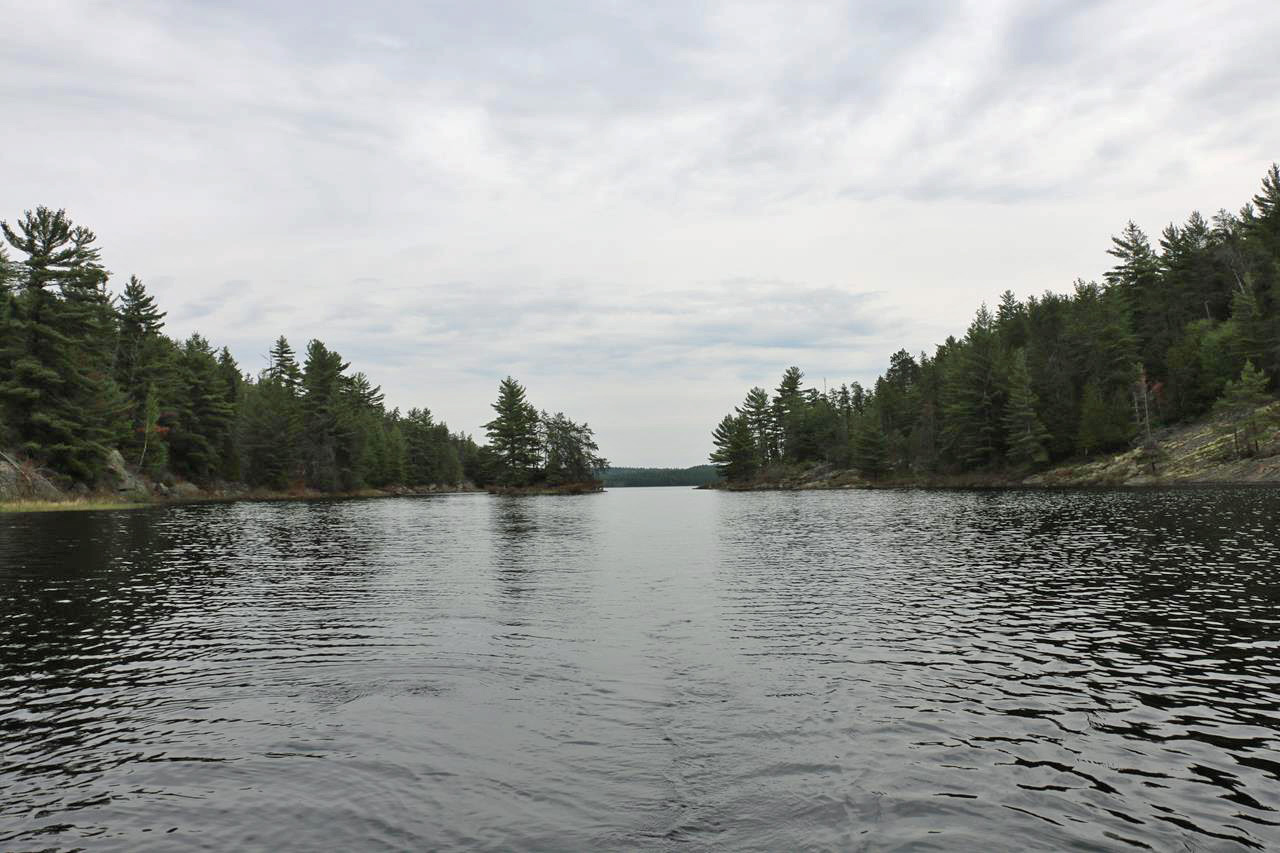 |
| Looking back through the narrows at Grand Lake. |
 |
Upon arriving at the mouth of Carcajou Bay, we paddled close to the rock wall where the petroglyphs are located. Paddling nice and slow, we tried to spot them. A few instances here and there produced some Ďmaybesí. However, we never saw anything conclusive. The bugs were attacking us because we were close to shore, so we moved on through the bay. We stopped quickly at the first campsite in the bay because I wanted to get out a have a closer look. I spotted this campsite a few years back and thought it might be a nice spot to make camp. We stayed about 5 minutes and remarked how the area must have recently been maintained as there was evidence staff had cleaned up the campsites. Much appreciated!
Back in the canoe, we continued down the bay to the first portage of the trip .. a measly 20m around a swift. I dropped Angela off on the rock and told her I would line the canoe up the little rapid, thus avoiding unloading and reloading all our stuff for such a small distance. However, I neglected to tie a line to the stern of the boat, which compromised my ability to completely control the boat. As I began to line the canoe up the rapid all was going well. Then before I could say ĎOh Shit!í the nose of the boat hit the current, and instantly swung it sideways into the swift. The boat rocked to one side and began to fill with water. Not good! I pulled up on the rope as fast and hard as I could, which was enough to bring the gunwale above the waterline and prevented total submersion. It had been an epic mistake that almost caused me to have to take a swim to retrieve all my gear. Luckily, the canoe only ended up with about an inch and a half of water and nothing damaged.
I pulled the boat back to the landing and proceeded to unload it. I did this silently as Angela began to take packs and stuff to the other end of the tiny trail. The only thing I said about the situation was, "Well that couldíve been much, much worse." Angela agreed and that was that.
We pressed on to the beautiful waterfalls. This was Angelaís first time through Achray, and second time on the east side of the park. She kept remarking how rugged and rocky the area was. I explained these were the main reasons why the east side is my favorite place in Algonquin Park. It was still very early (11:45am), so at the bottom of the falls we decided to throw a few casts and try to land a trout. We werenít serious about it, but figured it would be a good spot to possibly land a brookie. No dice, or fish, but that was okay. We headed over to the 90m portage around the falls and made quick work of it.
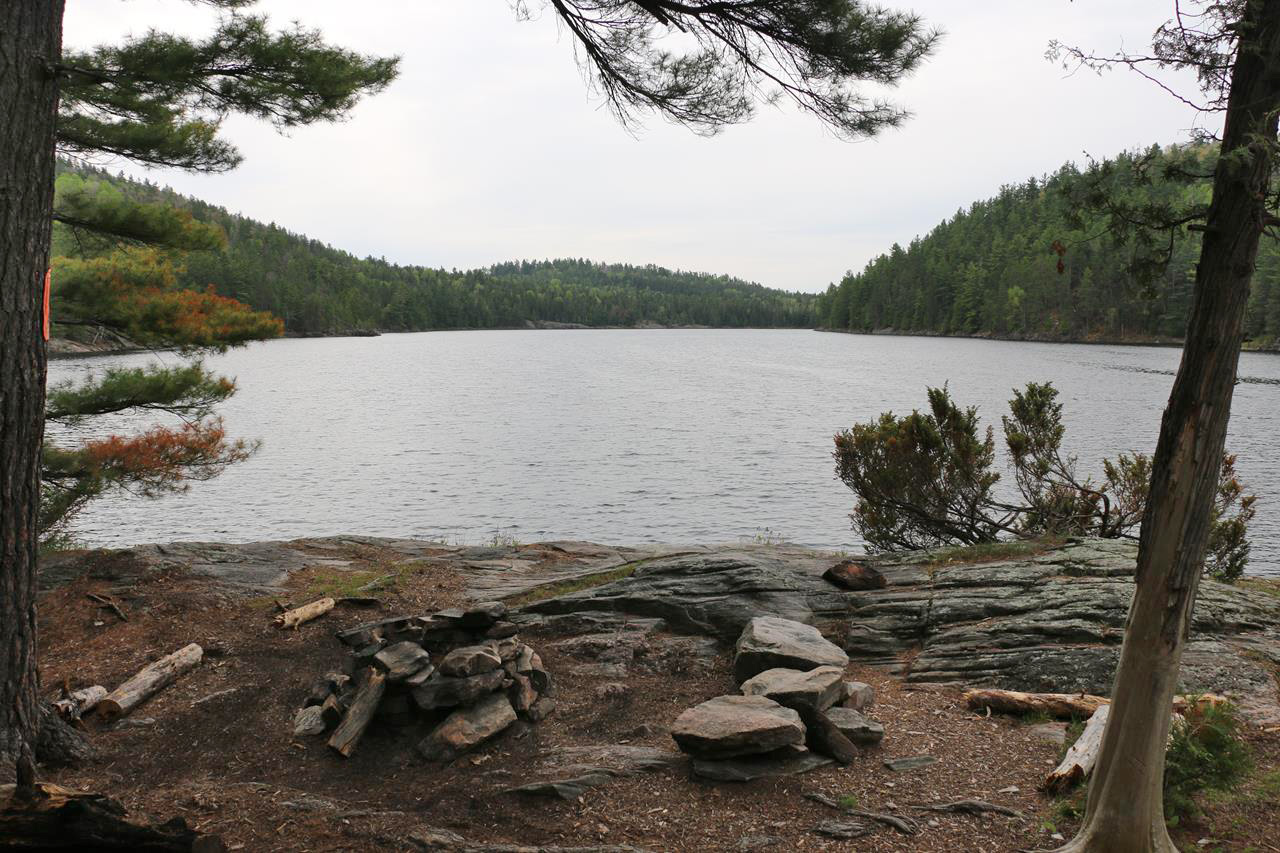 |
| Great Campsite on Carcajou Bay. |
 |
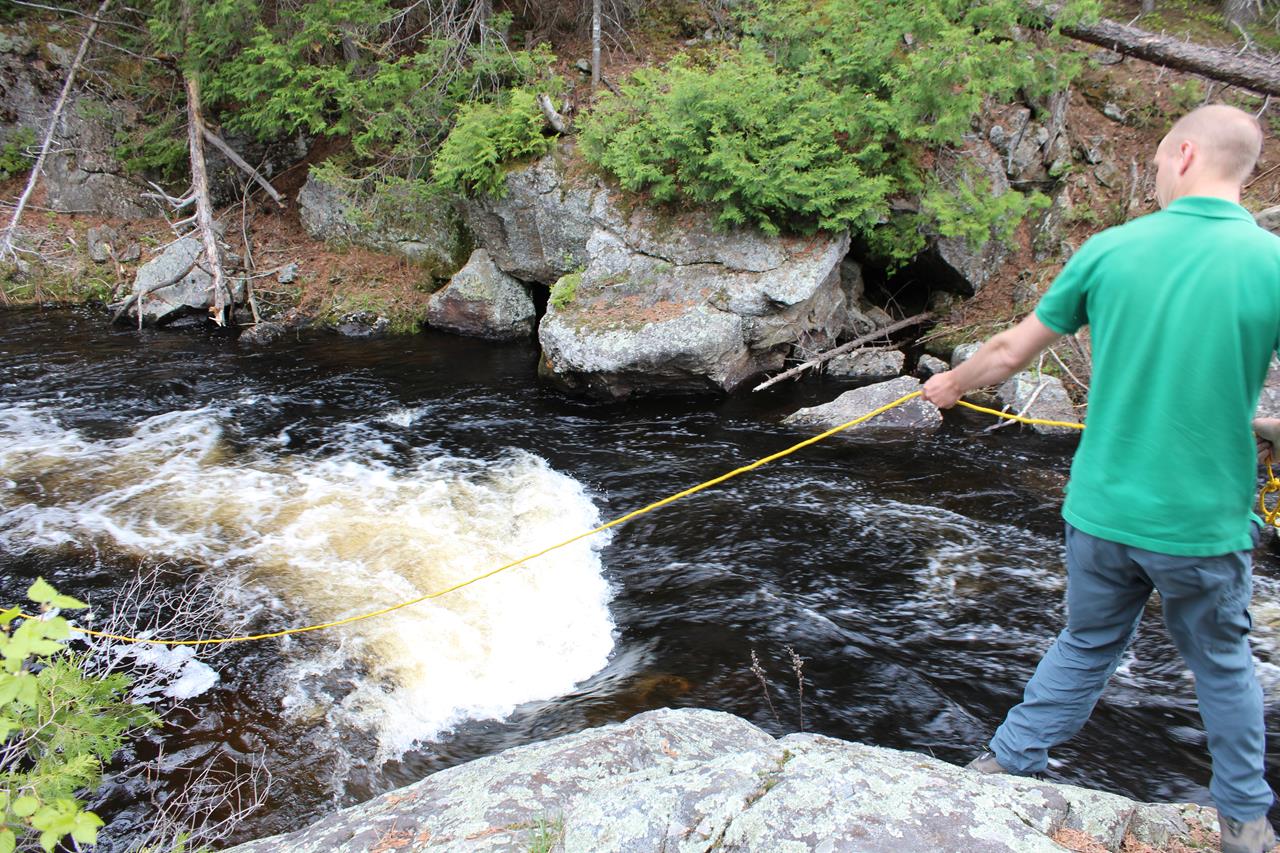 |
| Lining up the swift. |
 |
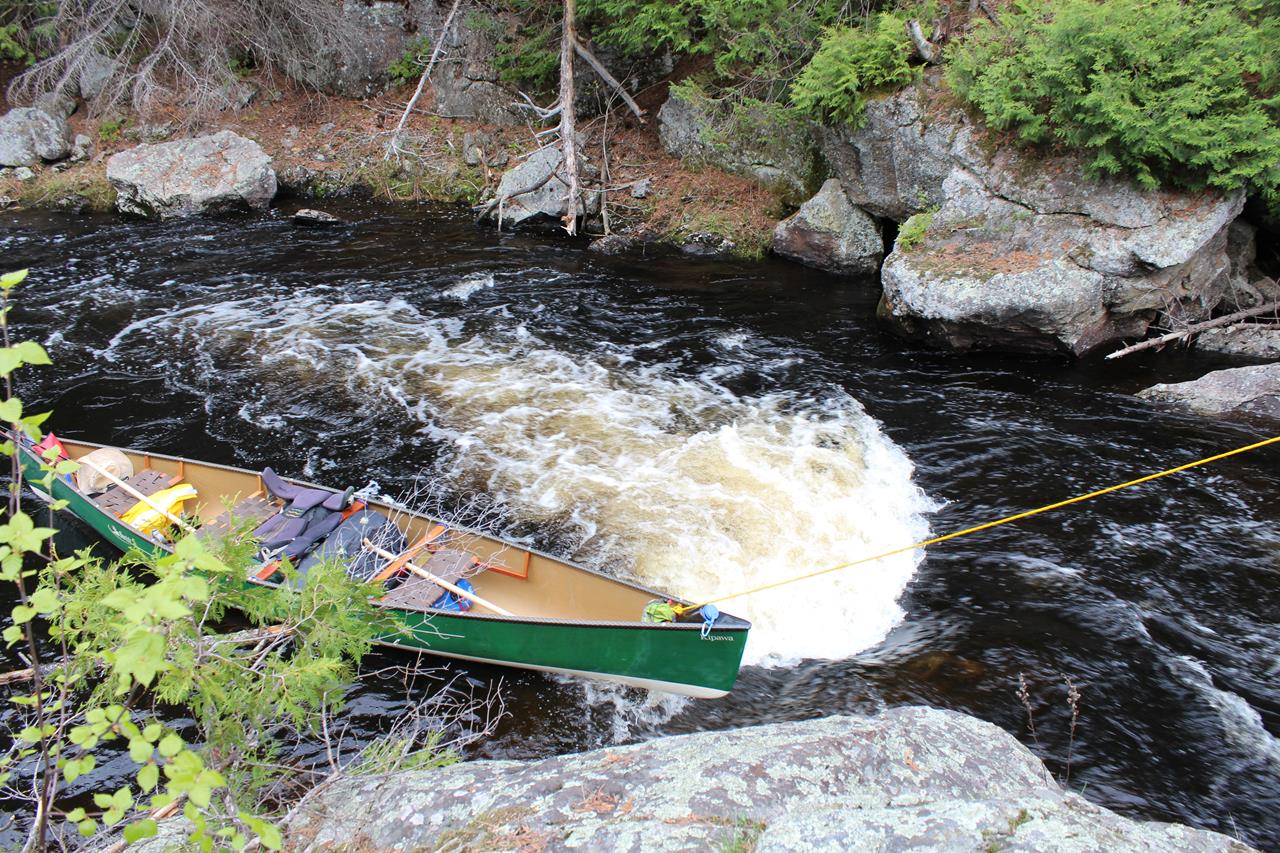 |
| So far so good! |
 |
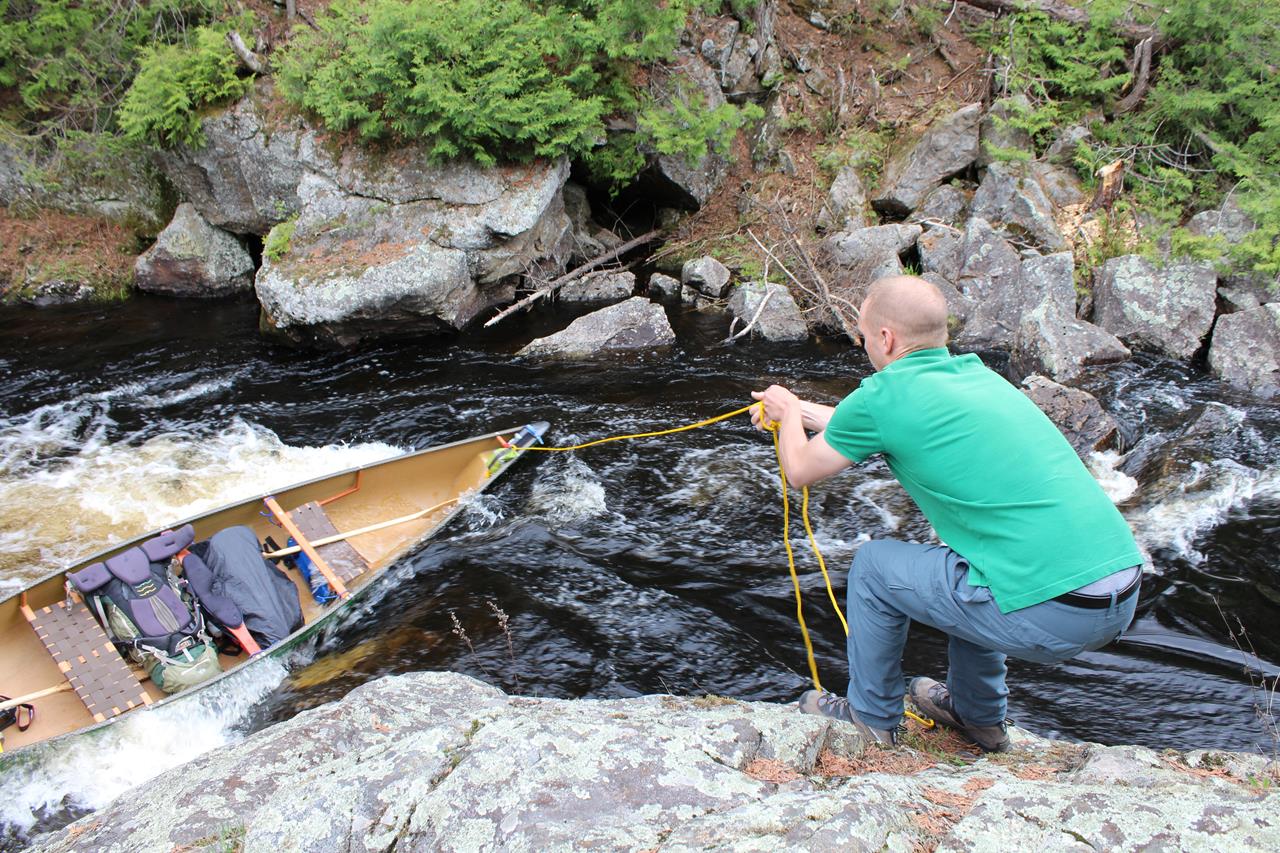 |
| OH GOD, NO. PLEASE NO!! |
 |
We stopped at the top of the falls for a little break and snack. The pools above the falls here are very beautiful. Massive flat rocks slope gently to the waterís edge all around this area. Itís very scenic and very beautiful. After a quick snack we loaded the canoe and made the 30-second paddle over to the next portage Ė a 220m trail leading into Carcajou Creek. As we passed the lone campsite on this portage, a few guys called out and asked about the weather forecast. I told them it was supposed to rain a bit this afternoon, but then clear skies for the next 5 days. They seemed happy at the sound of that, and why shouldnít they be?!
When we arrived at Carcajou Creek, the bugs were a little more annoying than they had been elsewhere. So we didnít hang around too long and began our trek to Lower Spectacle Lake. The section of creek between the last portage and Lower Spectacle Lake is stunning. Itís only a few hundred meters at best, but just stunning. Itís a small sample of the entire east side.
When we arrived at Lower Spectacle Lake, I was surprised to see it was vacant. I'd checked the online reservation system before leaving and all the sites in this whole area were supposedly booked up. I'd even modified our route to account for that unavailability. It turned out to not be an issue, I had expected it to be crammed! I pointed out the campsite on the east shore, telling Angela I had stayed here once back in 2012 (See my website's TR17: The Barron Canyon to Greenleaf Lake). She mentioned this lake was unremarkable and I agreed Ė it was very shallow and lacked the giant features usually associated with the east side.
Just after 1pm, we arrived at the take out for the short portage between the two Spectacle Lakes. We did the short, flat, pine-needle covered trail in about a minute and launched onto Upper Spectacle Lake. While paddling up the lake, I pointed out the burned-over east end of the lake and mentioned it had been like that since I passed in 2012. We passed the first campsite and eventually the second. The second campsite was occupied and the group was busy getting tents and tarps put up as we paddled by. Iím not even sure they saw us. We landed at the take out to P2180 to our destination for the night .. Little Carcajou Lake.
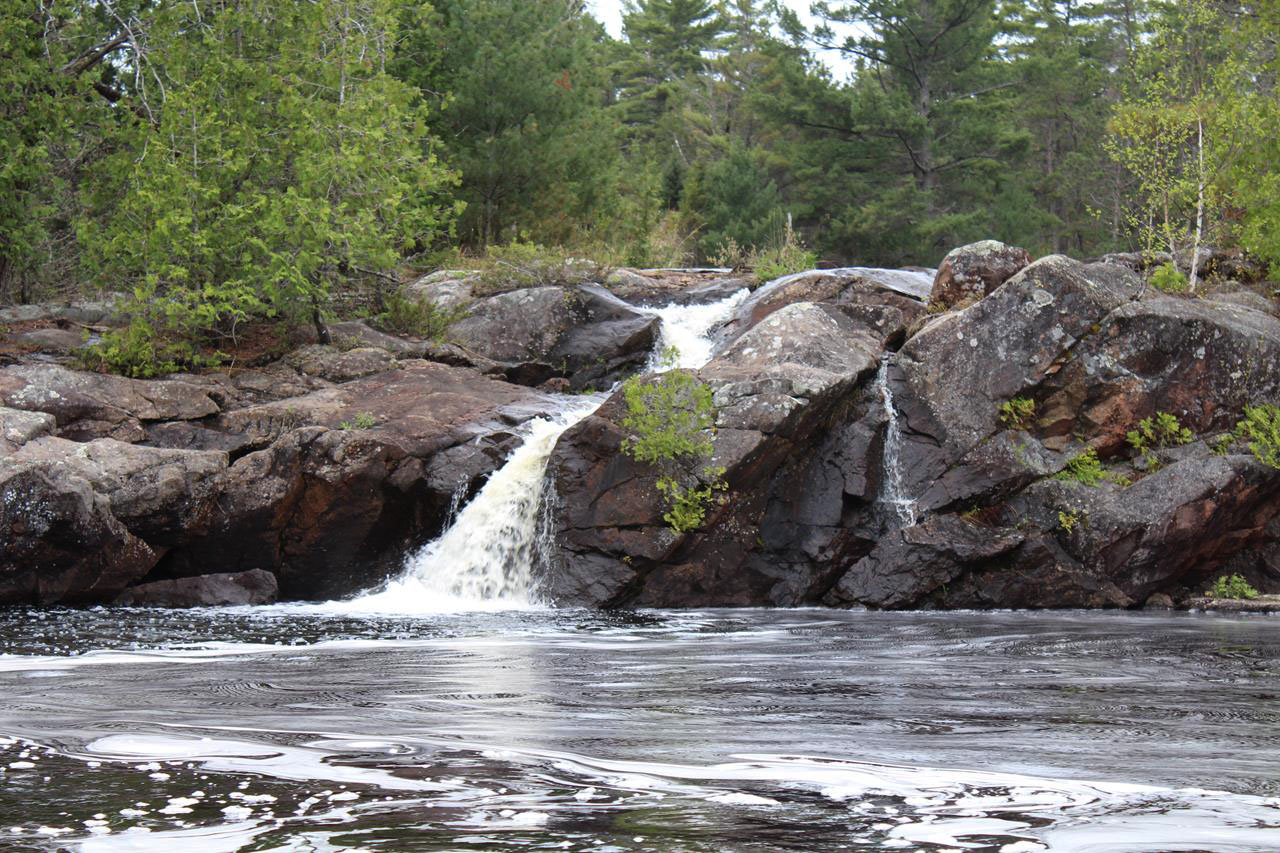 |
| High Falls on Carcajou Creek. |
 |
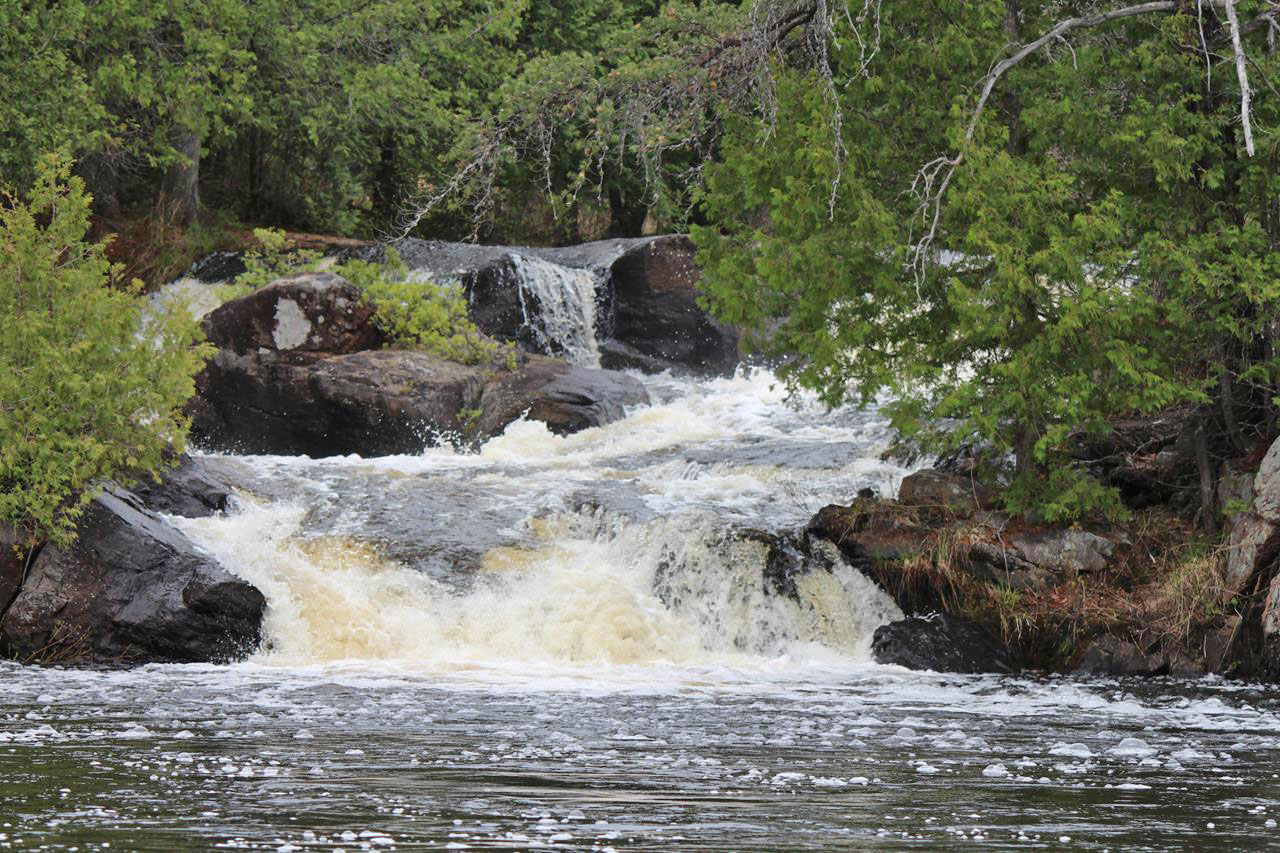 |
| High Falls on Carcajou Creek. |
 |
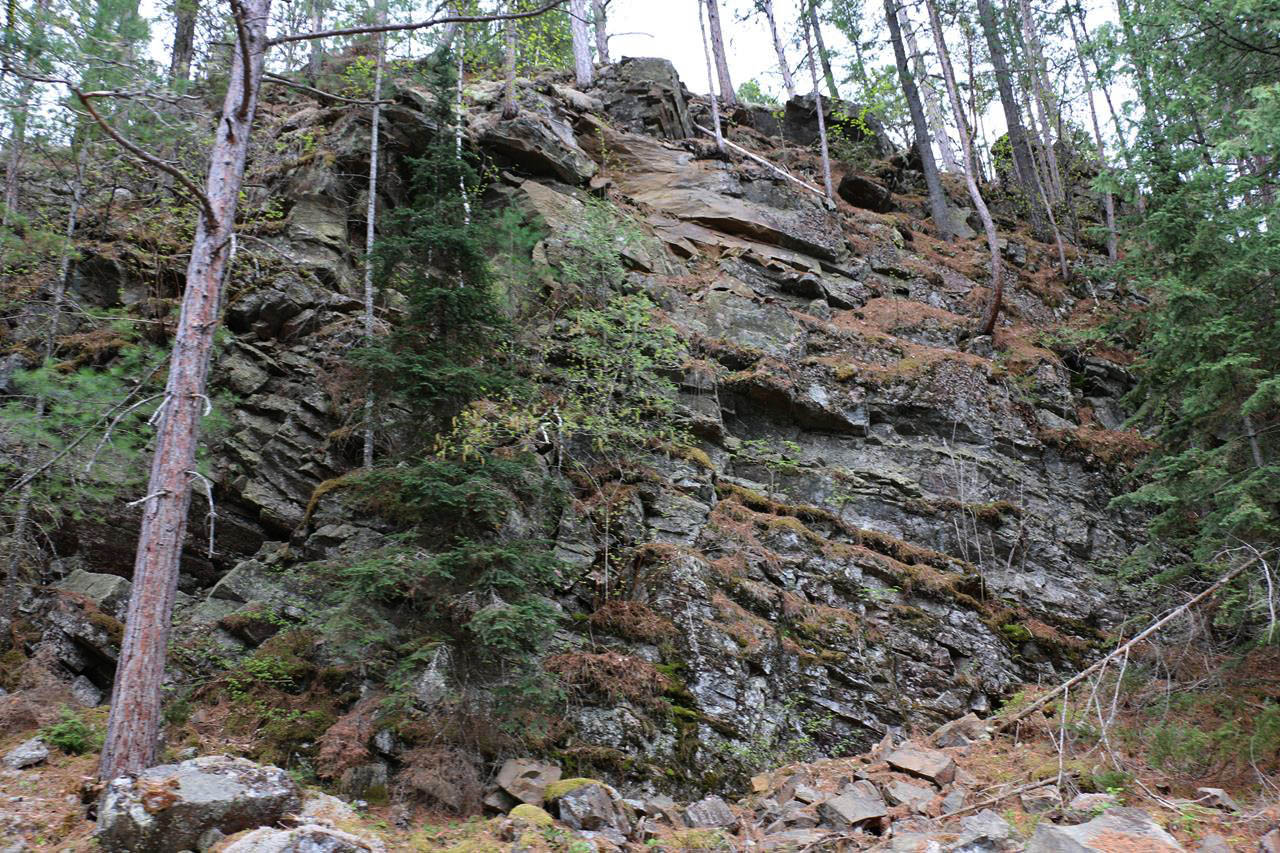 |
| Mini canyon on the way to Lower Spectacle Lake. |
 |
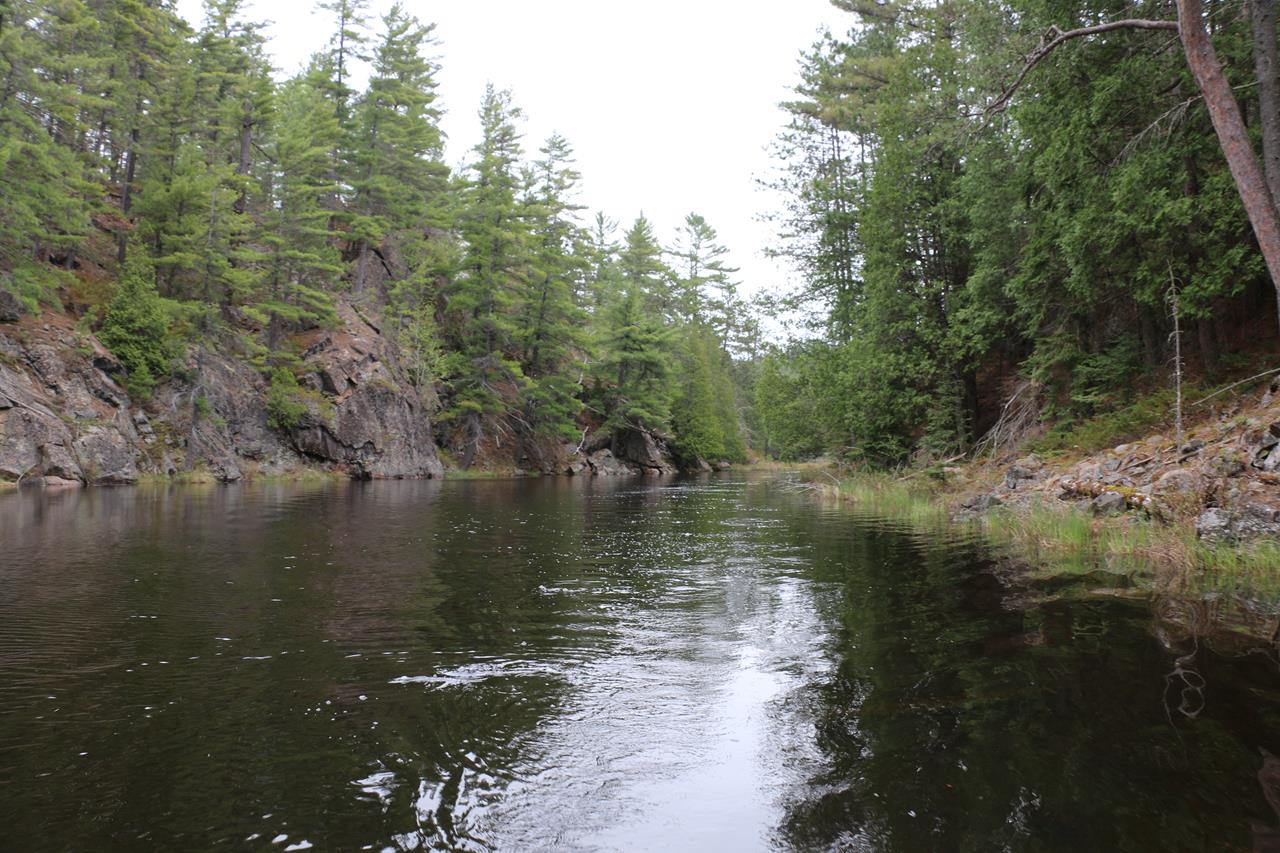 |
| Creek to Lower Spectacle Lake. |
 |
Before taking this short but very rugged beast of a trail on, we decided to have a quick lunch. I ate a few granola bars and meat sticks and Angela had some decanted lemon tuna and a couple of granola bars as well. We topped off with a huge swig of water to lighten the load and began to suit up for the trail. I gave Angela fair warning about this trail. I told her itís full of ankle busting rocks, narrow passages and flooded out areas. She was game.
The trail starts off easy enough, a nice flat section through a beautiful stand of red pines. But it doesnít take long for things to take a turn for the worse on this trail. We needed a break by the 500m mark, then another one 400m after that, then 200m after that. We seemed to be getting tired and our food pack was at its heaviest, so it was beginning to take its toll on us.
When we arrived at the pond, I told Angela that I wasn't interested in skipping it. The previous two times I'd crossed this trail, I hadn't made use of the pond. I donít see value in re-loading then unloading the canoe, just to save a measly 300m. We pressed on and took a few more breaks. It took us a total of nearly 90 minutes to get across that trail. Considering I average about 20 minutes per km when solo, this took way more time than it needed to. But considering Angela was still very new at this and it was the longest and most difficult portage she'd attempted, I had to commend her on her completion of it.
She kept complaining to a minimum and was mostly frustrated at how the trail would just disappear in some areas, or be underwater in other areas. I said these are the costs of spring tripping! We arrived at the end of the trail just after 3pm and both of us were very happy that our portaging for the day was complete. The landing here is a little steep, but after walking the rough trail itís not so bad to work with. It didnít take long for us to paddle up the lake and to land at the campsite.
The campsite was missing its sign, but it was obvious that this was the right spot. The fire pit was located fairly close to the shore. This campsite is situated on a little slab of land jetting out from the main shoreline. The site has one, maybe two tent pads and is fairly small. It's great for a couple or a soloist.
I began to set up the tent and tarp while Angela got a fire going. It wasnít needed yet, but it was a bit chilly and damp, so I figured why not. Usually Iím opposed to an unnecessary fire, mostly because it just means I have to get more wood for when we actually need it, but I think new campers find comfort in fire. I say this because every new person Iíve brought out to the back country, the first thing they do is get a fire going. When Iím solo, Iíll have a fire on a cold morning, when Iím cooking, or before bed. To each their own. With the shelter set up, Angela began to work on the inside of the tent. Mattresses rolled out and inflated, sleeping bags ready to go!
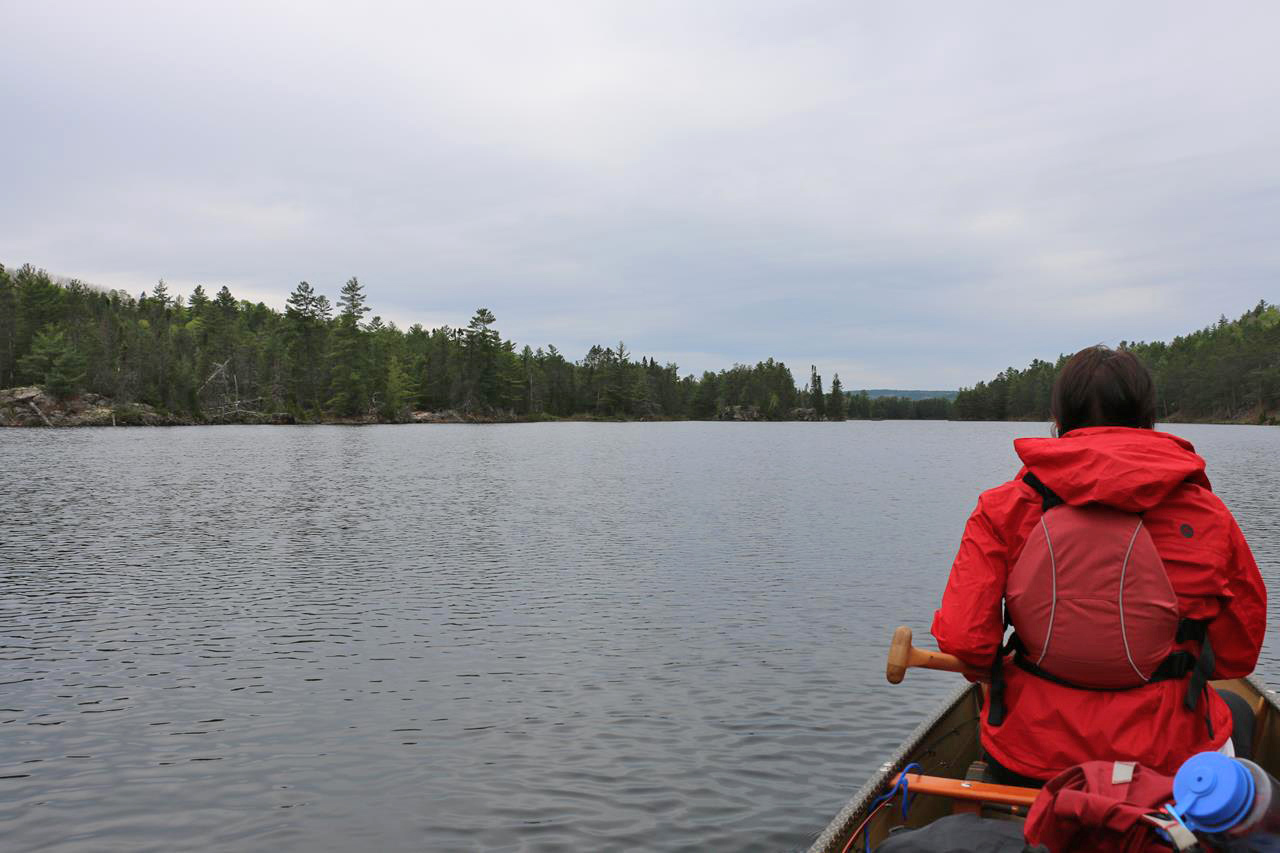 |
| Paddling up Little Carcajou Lake. |
 |
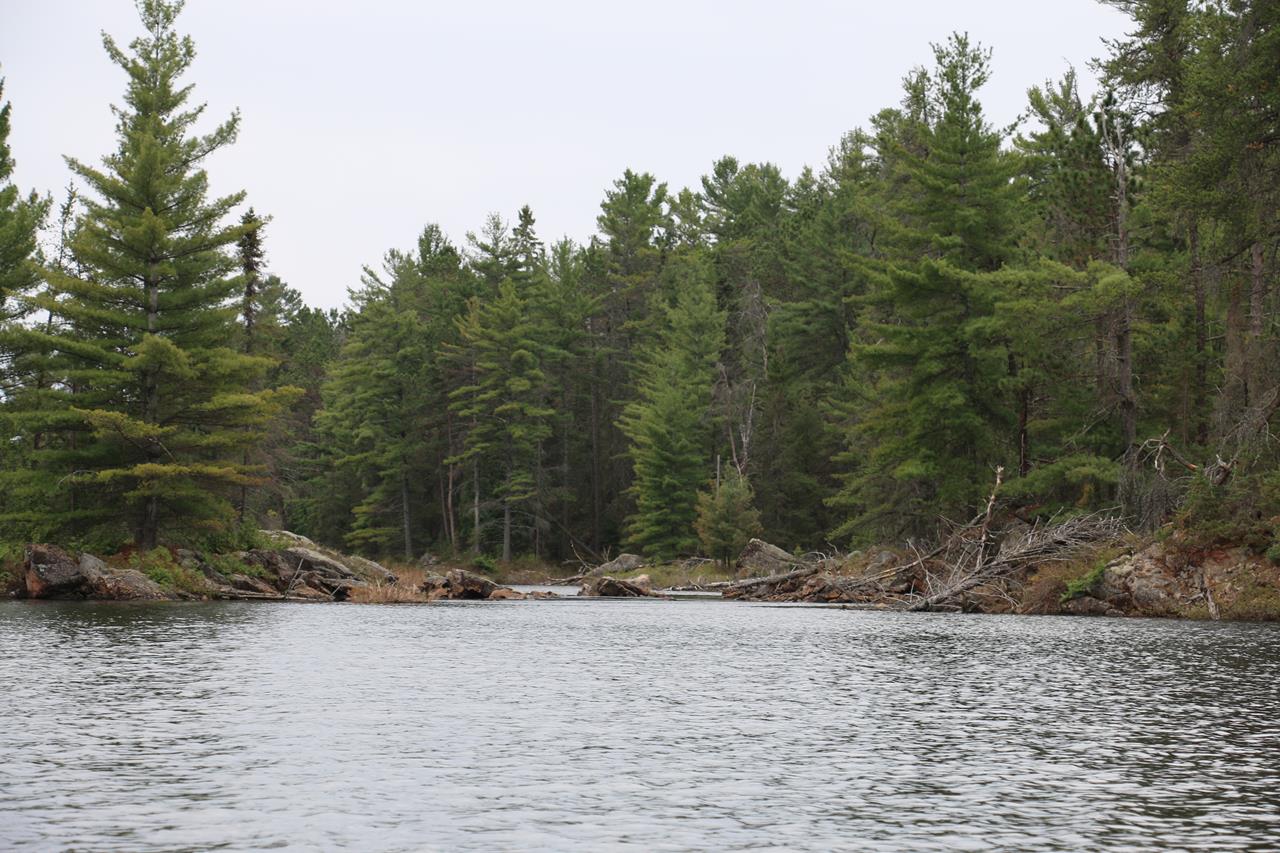 |
| A look at the entrance to Stone Chute. |
 |
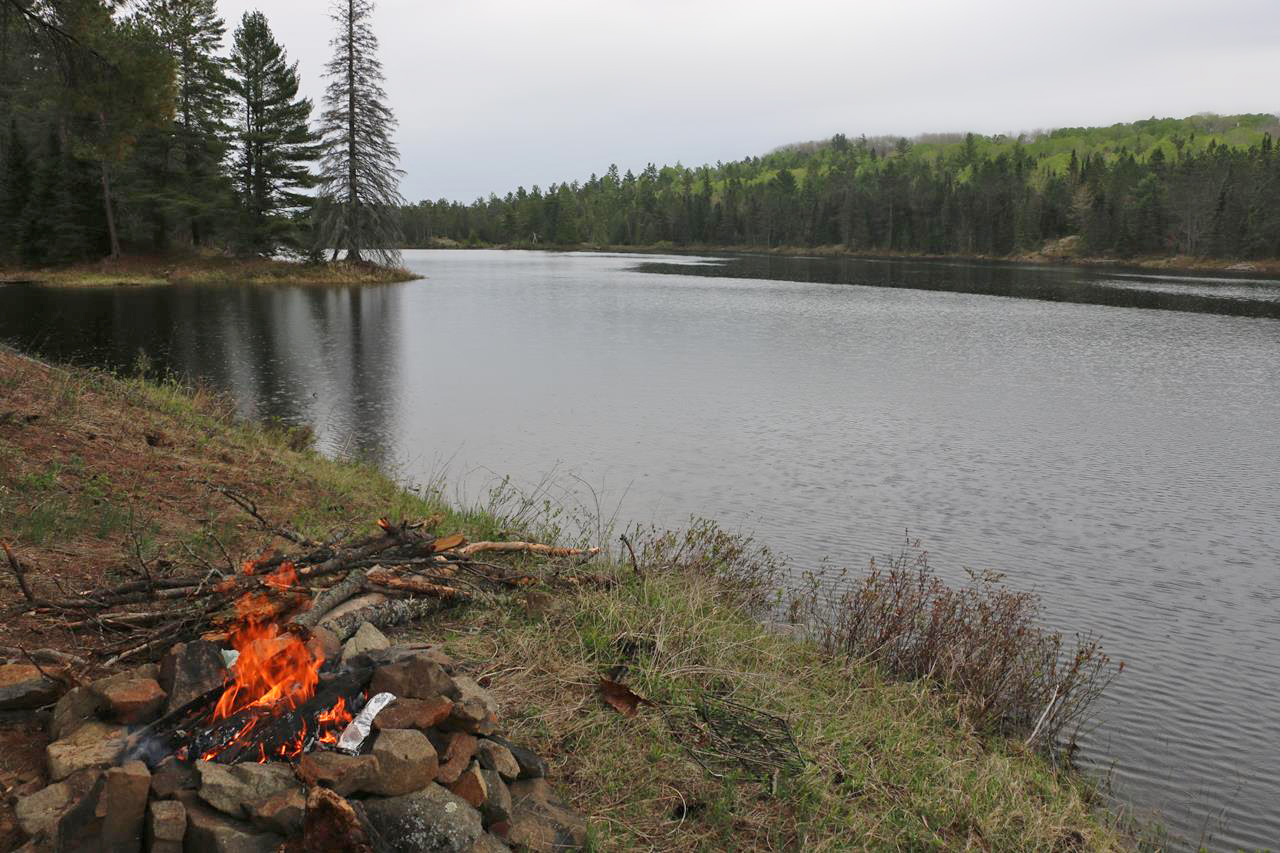 |
| A nice view down Little Carcajou Lake from the lone campsite. |
 |
Around 5:30pm, I decided to get a good pile of wood going. Angela tossed a few logs on the fire, as we needed a good bed of hot coals to cook dinner. I made a few trips back and forth with wood from the forest behind the campsite. One thing I like about spring camping is the ease of finding firewood. Fast forward to October and I bet this site will have been picked clean. While looking for firewood, I also tried to locate the thunder box. I went up a really steep hill, following what I thought was a trail but then it just stopped. No box. Ah well, no problem Ė we had a mini shovel for digging cat holes anyway.
On one of my trips back with wood, I noticed a bunch of white fur on the ground. Then I saw more fur, and followed a furry trail to a spot where it was obvious a deer had been eaten. Nothing but hair remained .. nothing! It had the stench of death in the area, so I moved on. With the fire down, we tossed a pre-made foil package of potatoes, onion and jerk seasoning, and a second foil pack of jerk seasoned broccoli. That along with our steaks and dinner was ready to go! Steak is a tradition on the first night of many camping trips. I canít think of a single trip Iíve taken that didnít start out this way.
With our dinner finished, the dishes washed up and the food sack hung, there wasnít anything left to do except pour a drink, sit back and enjoy the fire. We chatted about our journey so far and I found Angela was in good spirits. This was especially good because on previous trips, we would base-camp for 4 nights and complete day trips. On this trip however, we would be moving each day with a rest day at Greenleaf Ė so I was happy to learn she wasnít exhausted or wanted to call it quits!
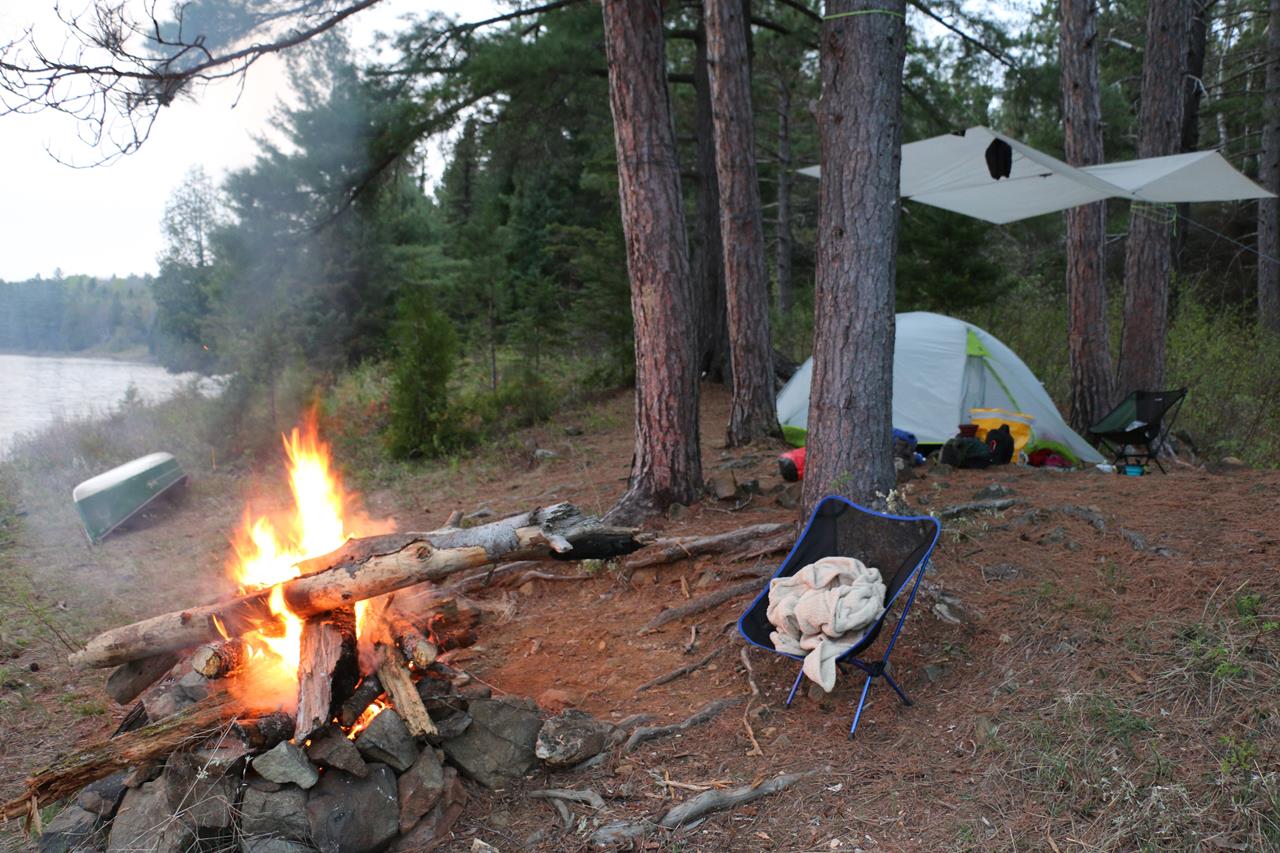 |
| Our campsite on Little Carcajou Lake |
 |
Around 9:15pm something odd happened. I heard loud noises from the south end of the lake. ďWhat was that?Ē Angela inquired. "No idea, but it kind of sounds like people." Sure enough, about twenty minutes later, a canoe was approaching our campsite. When they were close, they asked how much further to the portage to Wenda. I told them not much, maybe 5 minutes of paddling. I assumed they were staying at the cabin and when I asked them, they confirmed it. Angela asked how I knew they were going to the cabin and I told her it was just a guess because the cabin is one lake over and itís pretty late to be travelling to a campsite, then having to set up camp as opposed to open a cabin door. They continued on and another canoe followed just behind them. I certainly wouldnít want to be travelling in the dark, but sometimes you do what you gotta do. Maybe there were highway delays, maybe one of them had to work late.
We continued to enjoy the fire and about a half hour later I could see headlamps at the portage to Wenda. "They must be double-carrying," I said to Angela, "because it shouldnít take a half hour to paddle to a trail and start down it." Eventually their lights disappeared into the bush, and we both decided to retire to the tent for the night. All in all, an awesome first day in Algonquin Park.
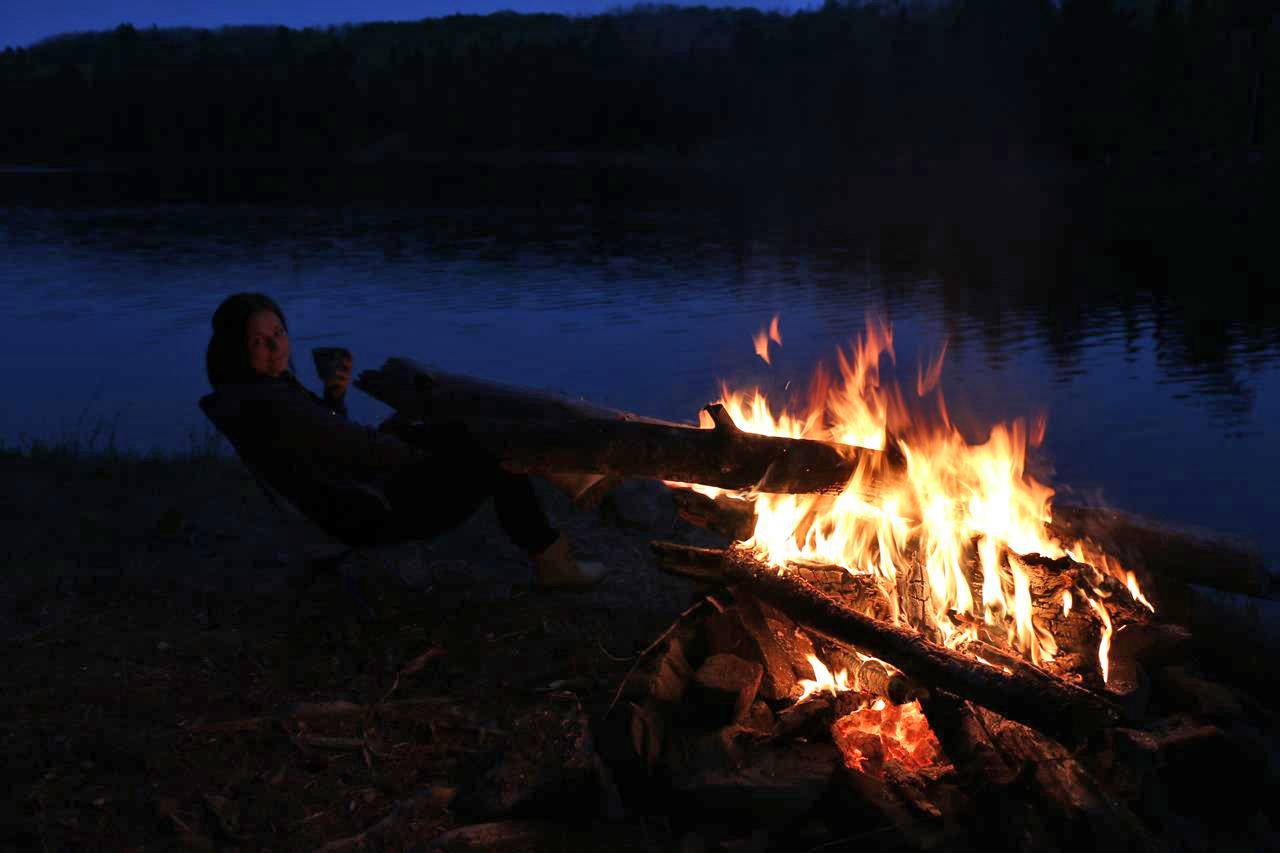 |
| Enjoying the fire. |
 |
Day 2- Saturday May 16th, 2015: Little Carcajou Ė Carcajou
We awoke a little early, at 6:30am. I wanted to quietly duck out and paddle down to the Stone Chute to check it out and get some photos. I put on some water for coffee and had the boat in the water ready to go. Coffee done, I poured a cup and jumped into the canoe. Just as I was pulling away from the campsite, Angela emerged from the tent. She hadnít slept well and was in desperate need of a coffee. I swung the boat around and headed back to camp. I really wanted to check out Stone Chute, but Angela was awake and I didnít want to leave her at the campsite all alone. Itís one thing if sheís sleeping. Itís another if I ditch her to go explore while sheís awake at the campsite.
We decided to get a fire going and enjoy some coffee. It was overcast and looked as though it would rain. We made a breakfast of BLTís on bagels and enjoyed some more coffee. As I began to take down the tent, I mentioned Iíd like to get an early start because Carcajou Lake was fully booked and I wanted a very specific campsite .. one that I had seen previously when passing through the lake. It was a beautiful long rocky outcropping, really high above the water and an amazing vista views of the lake proper and the giant bay heading south. Knowing how awesome this campsite was, I also assumed that the other two parties booked on this lake were aiming for that campsite too.
We took everything down and had our bags packed fairly quickly. With the boat in the water, we began to load it for the dayís journey. It was just after 11am Ė so much for my early start! Just as we were completing a final walk around the campsite checking for misplaced gear, I spotted a red canoe coming our way. As they passed the campsite, I greeted them and we had a quick chat. "Where ya headed? Carcajou Lake?" I asked. They replied with a "Yup!" And that was it Ė the race was on! I told them we were headed there as well, just for a night then would continue to Greenleaf for two more nights. They had mentioned they will be on Carcajou for two nights, with a possible day trip to Greenleaf.
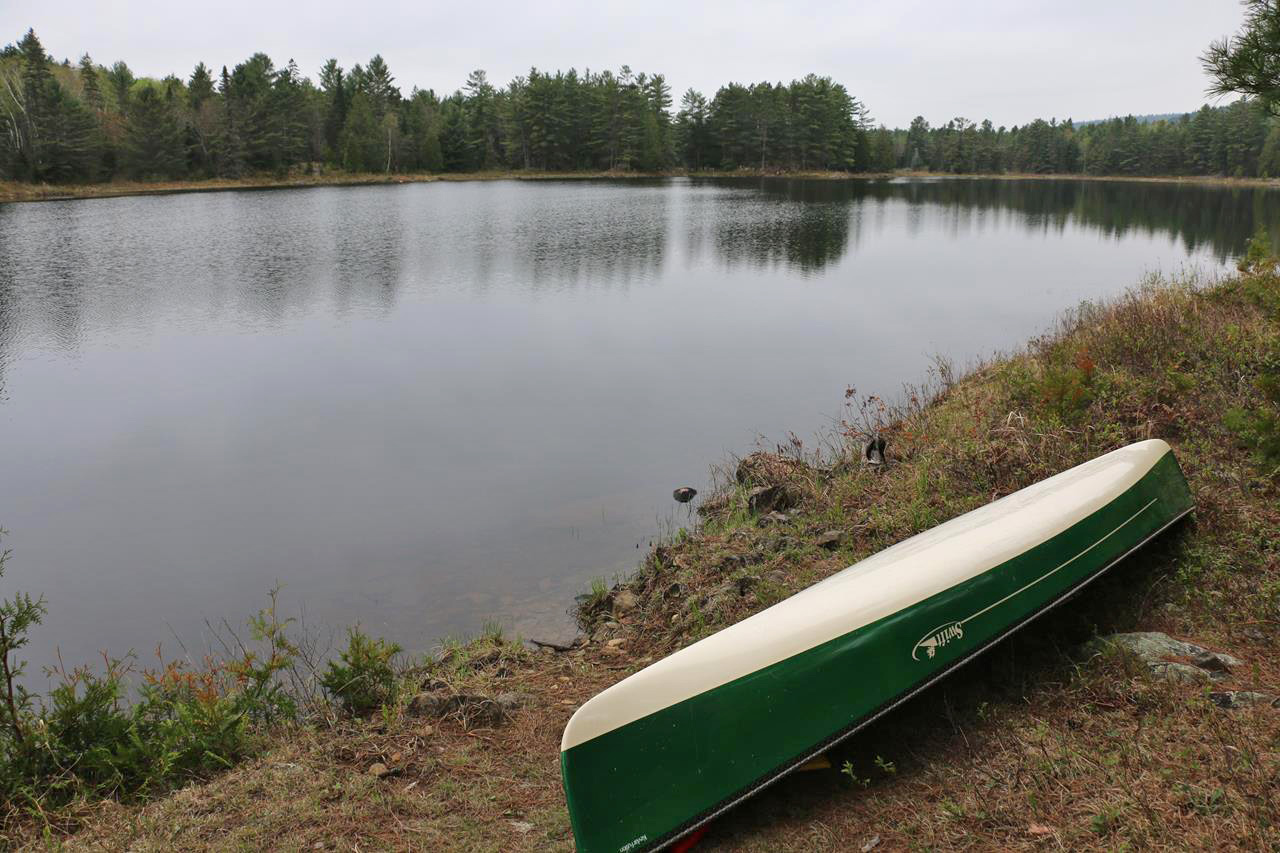 |
| A quiet morning on Little Carcajou Lake. |
 |
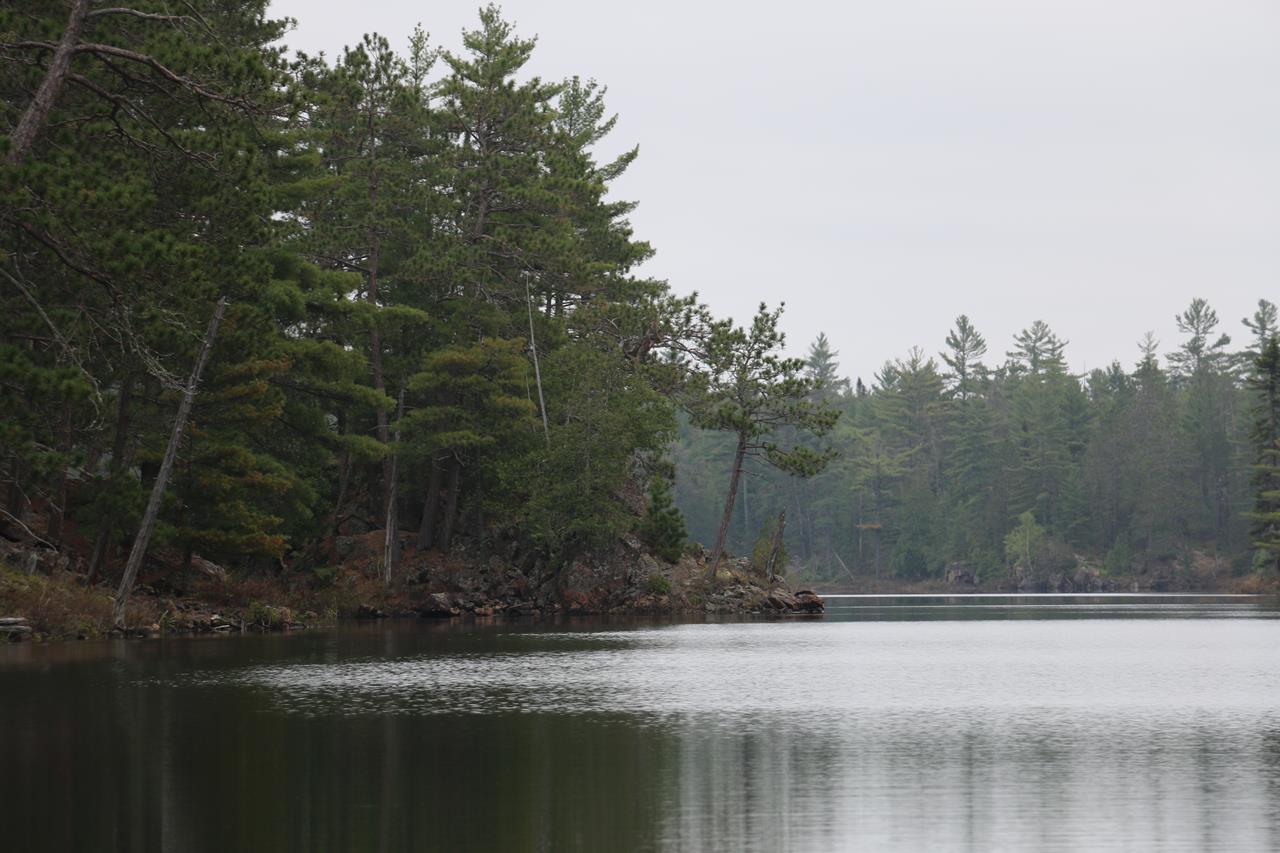 |
| Nice view down the lake from the campsite. |
 |
As they pulled away, Angela and I got in the canoe and began our journey for the day. A sense of urgency came over me. Something told me that if I didnít get to Carcajou Lake before they did, the dream campsite would be taken and we would be stuck somewhere in the buggy forest. Angela didnít seem too concerned at first, but when I explained the geography of the potential campsite she immediately recognized why it was imperative we get there Ė bugs! We started towards the end of the lake where the portage to Wenda Lake beings when we noticed they were headed off in the wrong direction. When we landed at the portage I realized these guys werenít taking the portage, they were taking the creek and fishing. ĎOh good! We donít have to rush!í I said to Angela.
We made a quick crossing of the 380m trail and arrived at Wenda Lake by 11:40am. I looked down the creek Ė no sight of the red canoe. I looked up the lake Ė nothing there either! Not seeing the red canoe led me to believe these guys were fishing the whole way up the creek and werenít in a rush to get to Carcajou Lake. As we paddled up Wenda Lake and reached the cabin, the group from the night before was outside the cabin getting their gear in order. I said hello and asked if the cabin was in good shape. "Yep" they replied. I was happy to hear that, because when I stayed at this cabin last July, it was a total mess. My friend and I filled 2 green garbage bags with all the garbage left behind .. from food to gear to clothing.
We continued up the lake and arrived at the take out to the 180m portage. I looked down the lake and still could not see the guys in the red canoe. All pressure was relieved at this point. We crossed the trail without issue and launched on the creek. Less than a minute later we arrived at the 80m portage Ė once again crossing it with no trouble at all, except the landing on the other side was tricky. Shortly after this portage we encountered a beaver dam. Having crossed literally hundreds of these, I pulled up to it and said ĎOkay, hop out!í. "Hop out onto what? This dam? Are you serious?" Angela replied. I was rather confused by this, "What do you mean am I serious?" What I forgot was, this was the first time Angela had encountered a beaver dam, and wasnít aware you could get out and stand on one without getting soaked or attacked by a beaver. I laughed a bit and apologized, then gave her instructions on how to deal with beaver dams and eventually helped her up onto the dam.
Just as I was pulling the canoe up and over the dam, I hear voices behind me. I turned around and looked, ĎOh shoot!í It was the guys in the red canoe. I couldnít believe it. I was a bit mind-boggled because when I had looked down Wenda Lake, I couldnít even see them. And here we were not even a half hour later and they were right on our tail! We chatted again and they had mentioned they have not portaged since the 2180m. Awesome I said! So far they saved 3 portages, and would likely save 2 or 3 more. We paddled side by side for a minute chatting.
When we approached the 110m portage, I told them I was going to take a page out of their book and jumped in the water to start creek walking. I let Angela out at the trailhead and told her to walk the trail as it follows the creek anyway. She wasnít thrilled with the idea, but she wasnít wearing a pack either, so it seemed okay for now. As we continued up the creek, I saw a huge beaver dam where there had once been a logging dam. This beaver dam was at least 3ft high and had a rush of water flowing over it. The creek in that spot was also studded with rocks and boulders and after what had nearly happened on the 20m portage the day before, I opted to take the portage for the final 30 meters or so. As I landed and proceeded to unload the packs, the guys in the red canoe hauled themselves up and over the beaver dam and continued on, leaving us in the dust! Well, that was it. We'd lost the race. The awesome campsite only a couple kmís away would definitely be occupied. Oh well, no biggy. We'd have to make do with whatever campsite we got.
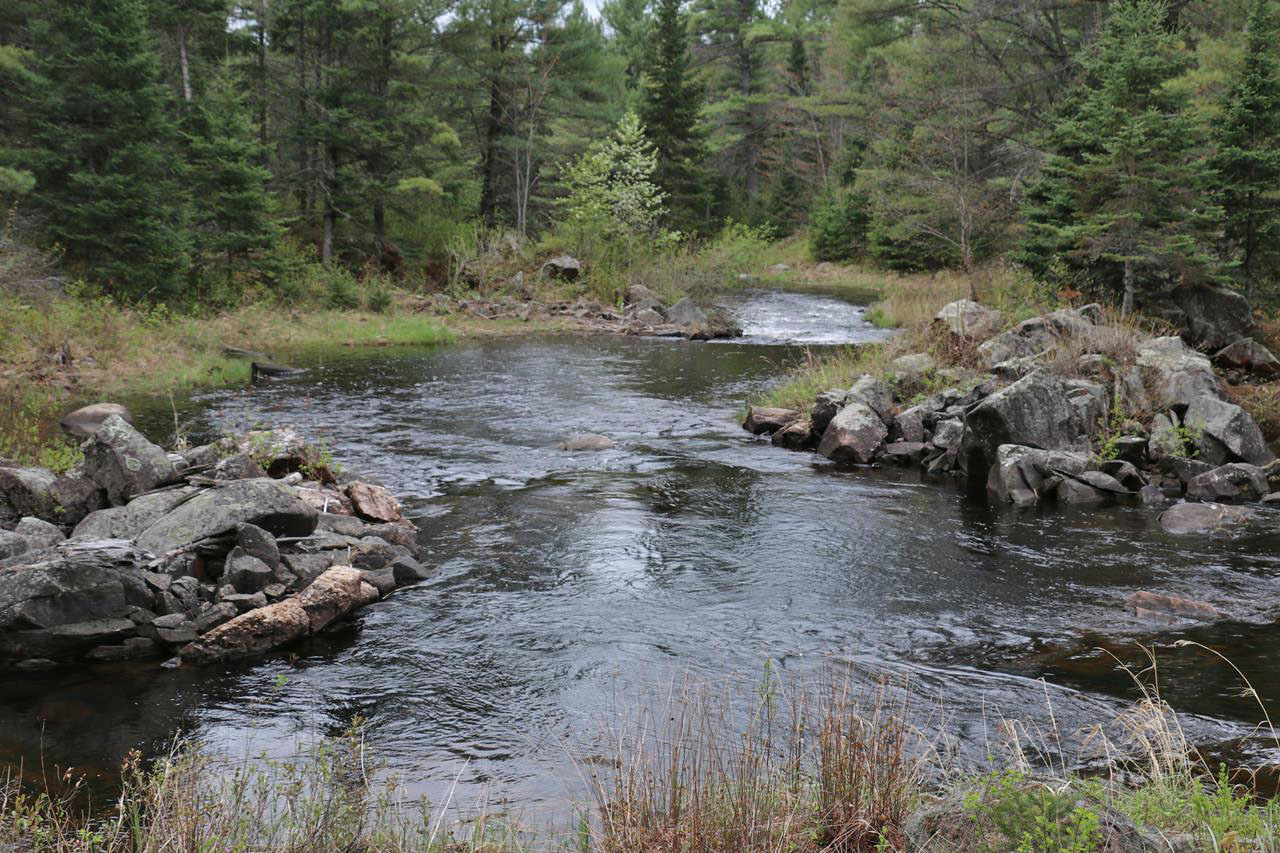 |
| Carcajou Creek exiting Wenda Lake. |
 |
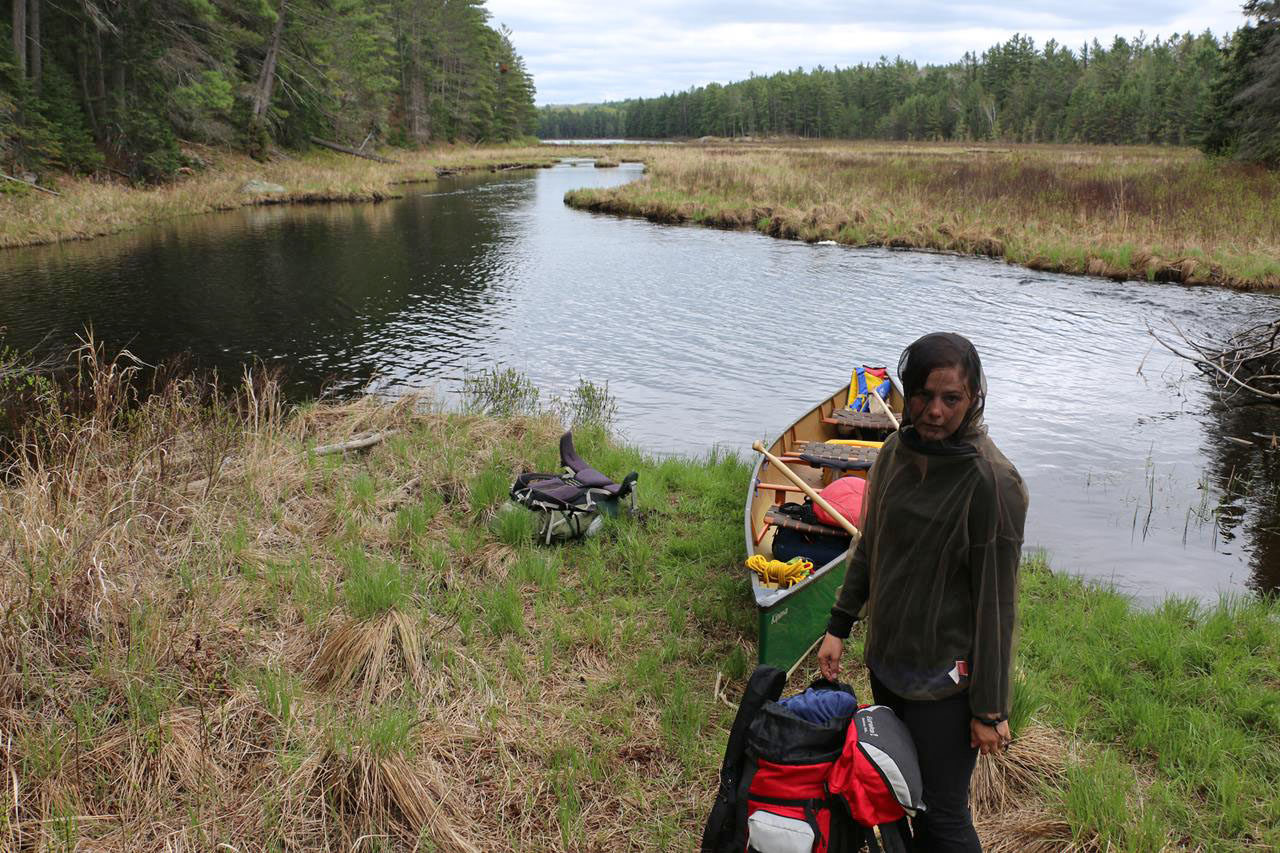 |
| Portage landing from Wenda Lake north to Carcajou Creek. |
 |
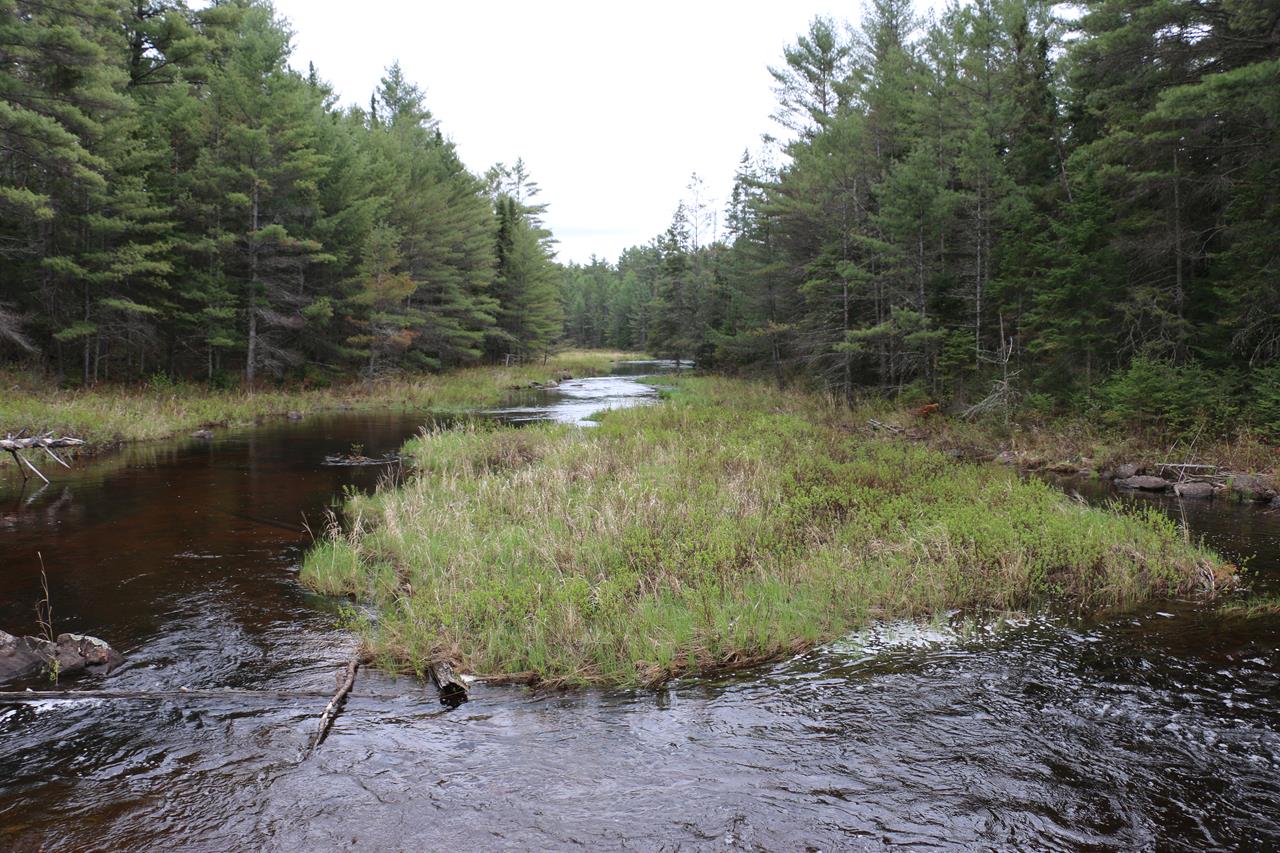 |
| Carcajou Creek south of P110. |
 |
Since we were no longer in a race, I decided we should take a break at the former logging dam site. There is a giant rock overlooking the creek right at the dam and Iíve sat here before on previous trips to take a break. This particular spot was especially interesting because it is thought to be the site of a Tom Thomson painting called ĎThe Driveí. We hung around for about 15 minutes but the bugs started to Ďbugí us so we decided it was time to move on. Since my feet were already wet from creek-walking, I told Angela to stay in the canoe for the next portage, and I would drag her and the boat up the creek.
It was a hot day, so I had no problem jumping into the cold creek. I walked the canoe and Angela up the creek and into deeper waters where I jumped back in the boat. Not bad! Two portages skipped! Only one left for the day. Just beyond the 115m portage, the creek becomes very narrow and rocky, so I jumped out again. There was a fairly large beaver dam so I remained in the creek until I was able to drag the boat passed the dam. A little further up and we arrived at the take out to Carcajou Lake. I was happy that we were at our final portage of the day, but still a little bummed out about the prospect of losing the awesome campsite.
We crossed the 220m portage with ease and proceeded to load the boat. When I looked around the lake from the portage, I noticed some boats around the giant rock outcropping .. our targeted campsite. It wasnít the red canoe, so I turned to Angela and said, "The race wouldíve been in vain anyway, the site is already occupied." I then noticed the red canoe on the shore at the first campsite on the east side. They were skunked too. I guess someone was up super early to get here, or they were camped there from the night before. We started up the lake and I noticed the second campsite on the east shore was also occupied. "Thatís odd." I said. "Why?" Angela asked. "Well, this lake only takes three reservations and it has four campsites." I replied.
"Why is that weird?" She continued. "We can see three campsites from here and the fouth one is up a little further. Of the three campsites we can see, all three are occupied Ė which means someone is here when they shouldnít be." It didnít matter because there was still a fourth campsite, but I felt the lake was too crowded. As we were passing the big rock campsite, Angela noticed a canoe pulling away and thought it was now vacant. I told her that canoe was fishing out front of the campsite, and likely not staying on it Ė it very likely still has occupants. We couldnít see anyone, so we decided to paddle over to check it out. Just as we arrived at the campsite, a canoe came around the rocky point and greeted us. We asked if the site was vacant and to our delight Ė it was! These guys were just on a day trip down from Greenleaf Lake and stopped to have lunch at this campsite. How funny is that? Had we rushed and actually beat the red canoe, we wouldíve assumed the campsite was occupied and made camp across the lake Ė just as they did! But instead, we took our time after admitting defeat only to be rewarded with the campsite we were targeting.
I have to admit, I felt bad for the guys in the red canoe. I just know they were aiming for this campsite Ė who wouldnít?! We were so happy to get this site Ė but at the same time and as uptight as it may sound, I think a rule about occupying campsites for lunch needs to be created. It isnít fair (though it worked out positive for us this time) that people are deferred to less desirable campsites just because someone on a day trip is having lunch. There is no way of knowing, without asking, if the campsite is vacant or if the occupying parties are just stopping for lunch. Chances are, if you see people walking around on a campsite, youíll just move on, assuming itís occupied. It is what it is, but Iím sure a lot of people get short-changed like this.
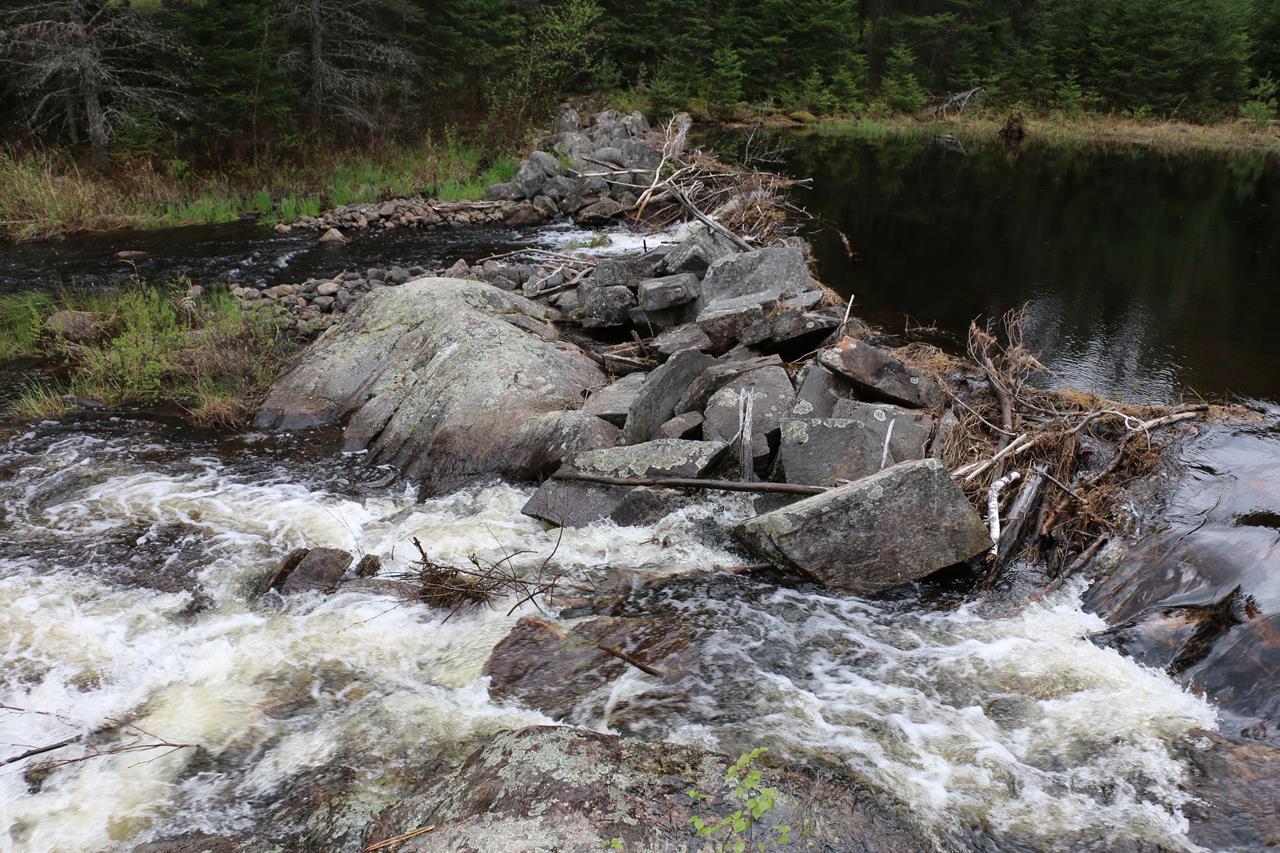 |
| The dam at P110 where we were overtaken in the race to Carcajou Lake. |
 |
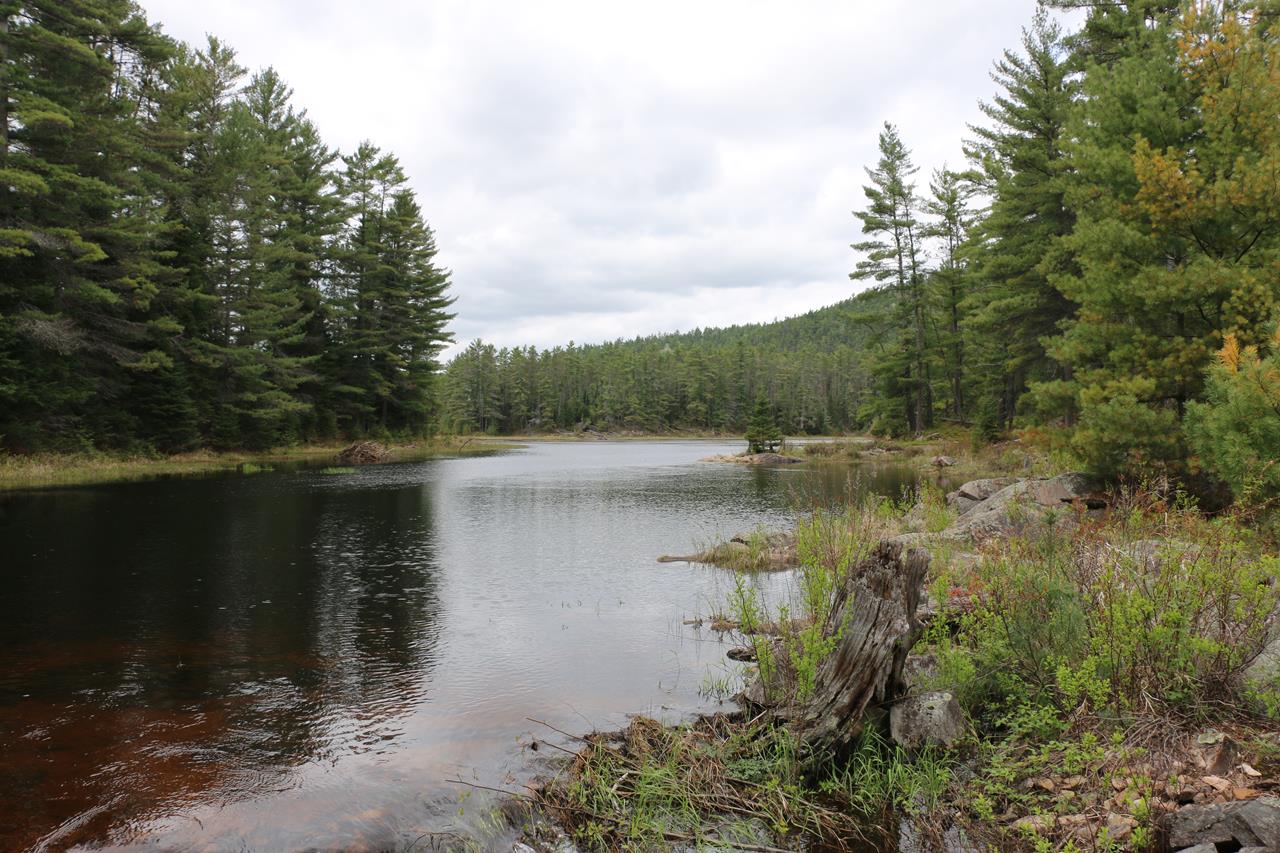 |
| Carcajou Creek above P110. |
 |
It was just after 2:00pm when we began to set up camp. There was a nice breeze blowing through the campsite, so I delayed putting up the tent. Even with the breeze, the bugs were making more of an appearance than on Little Carcajou Lake. So I busted out the bug shelter. I decided to gather some firewood. And just like on the previous lake, there was plenty of wood to be found. It didnít take long to get a pile bigger than I needed. This allowed me to leave a bunch of wood for the next group who would visits the campsite.
I walked around the campsite a bit more and realized itís a kind of island .. only connected to the main land by a very thin stretch of marsh. If the water had been 2ft higher, it would definitely be a full-fledged island. On one side of the campsite, the view up the lake was amazing and on the other side the view down the long bay was equally impressive. Little rock outcroppings covered in white & red pines could be seen all the way down the bay. It was just beautiful. I went down to the shoreline to cast a few but after looking in the water decided against it. I would surely have become snagged among the rocks and would have had to get out into the canoe to free my lure.
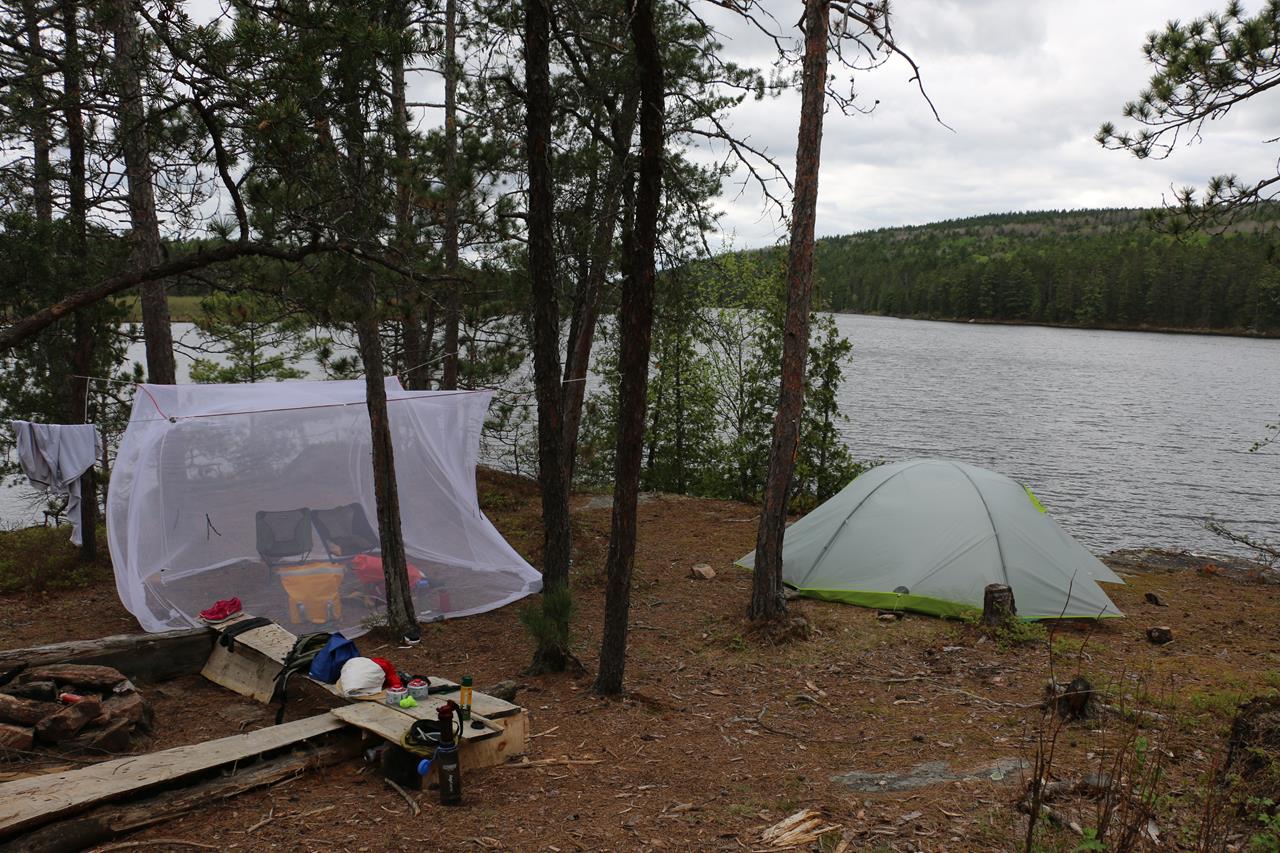 |
| The prize: The great campsite of Carcajou Lake. |
 |
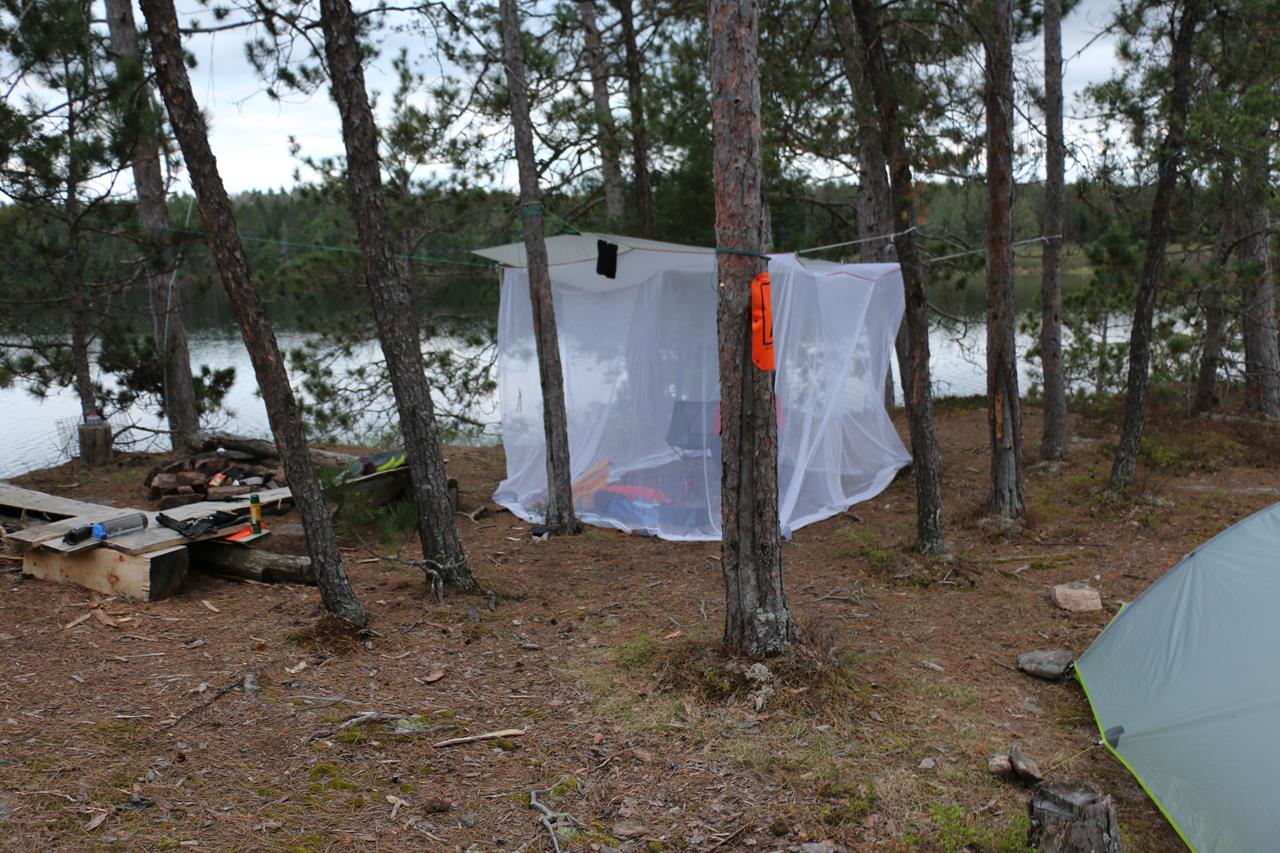 |
| Another view of this awesome campsite. |
 |
By 5pm the wind had died down a bit so I decided to put up the tent. Seeing how the whole campsite was one giant rock, I first had to collect 8 big rocks to keep the rain fly Ďpegged-outí. There were big rocks scattered all throughout the campsite so it wasnít an issue. With the tent ready to go and firewood already collected, there wasnít much left to do. Angela and I entered the bug shelter and began to cook dinner. Tonight it would be butter chicken on a bed of Indian rice. While it may not look like much, it sure tastes amazing. With a big hot meal in my stomach, I sat back in my chair and just relaxed for a bit, hands clasped together behind my head. I was in heaven. Evening arrived and we got the fire going. I said I wanted to have a nice big fire because I had too much energy for going to bed early tonight. So, we hung out around the fire for a good while, eventually retreating to the tent just after midnight.
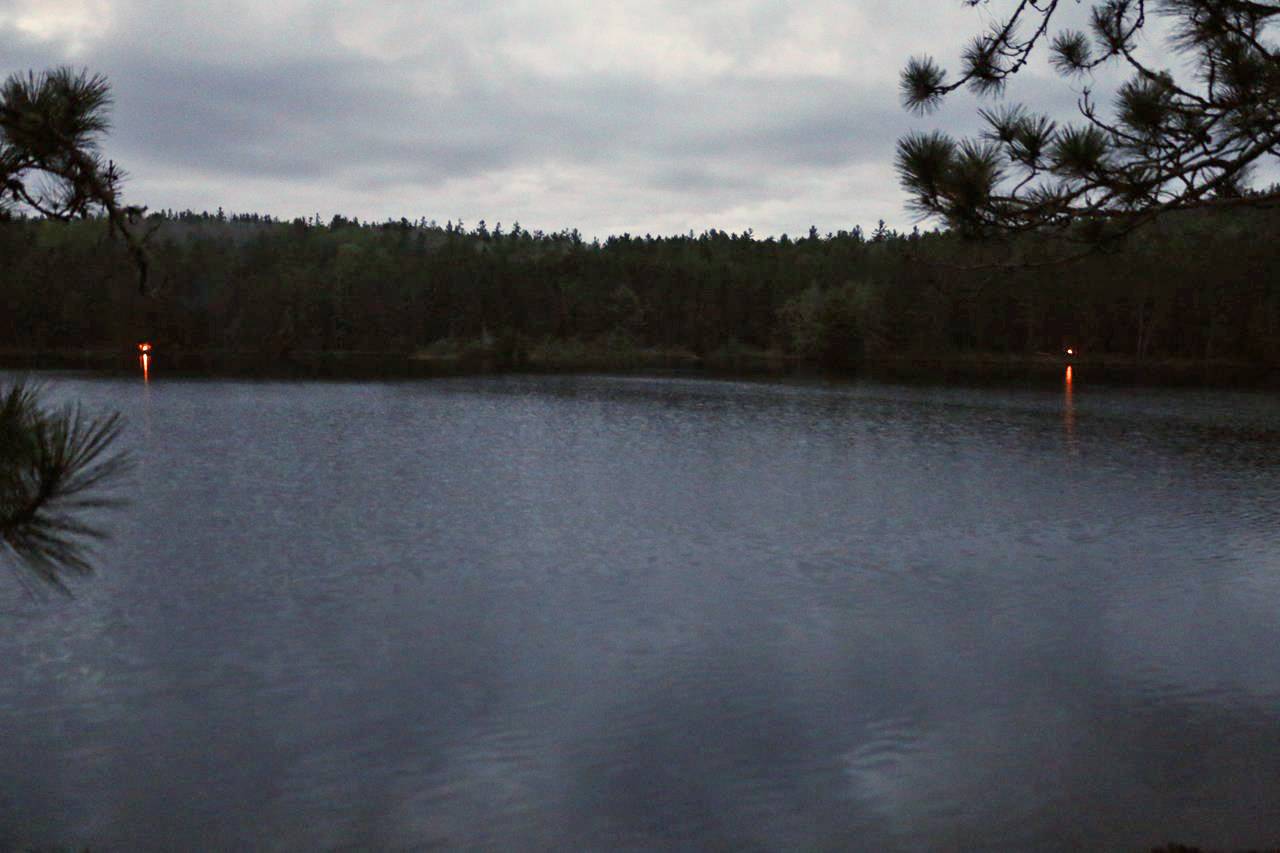 |
| Company at Carcajou Lake. The fire on the right is the guys in the red canoe. |
 |
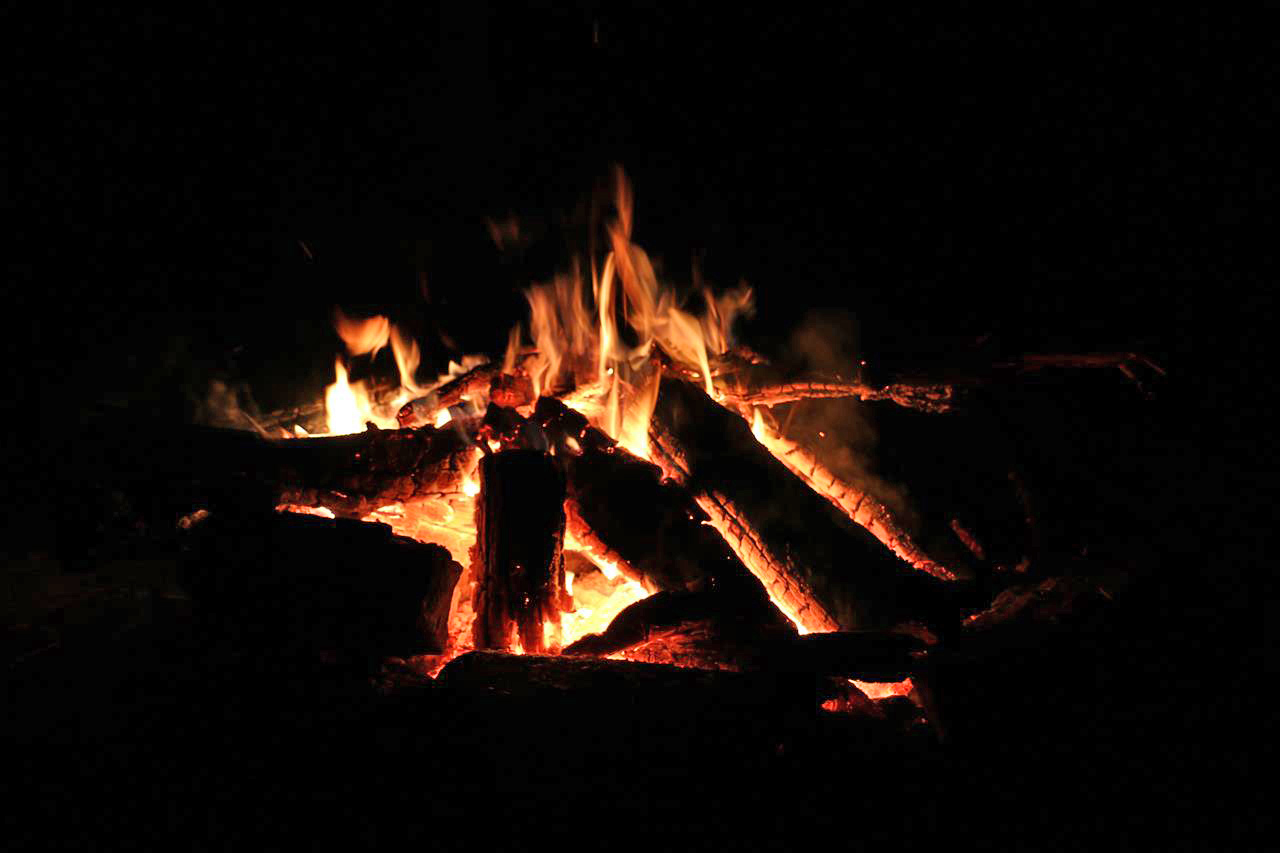 |
| Evening fire on Carcajou Lake. |
 |
Day 3 Ė Sunday May 17th, 2015: Carcajou Ė Greenleaf
I woke up just after 7am and left the warmth and comfort of my sleeping bag. When I unzipped the tent door and looked outside, I was ecstatic to see nothing but a blue sky and no clouds Ė not one! I walked around the site basking in the warm sun for a bit. Then I took the food bag down to get some coffee going. There are few things in this life that compare to a 7am coffee on a bright, sunny and peacefully quite morning in Algonquin Park. I often joke to people, "I go for the coffee". I'm amused by the look of confusion on their faces while they process the comment.
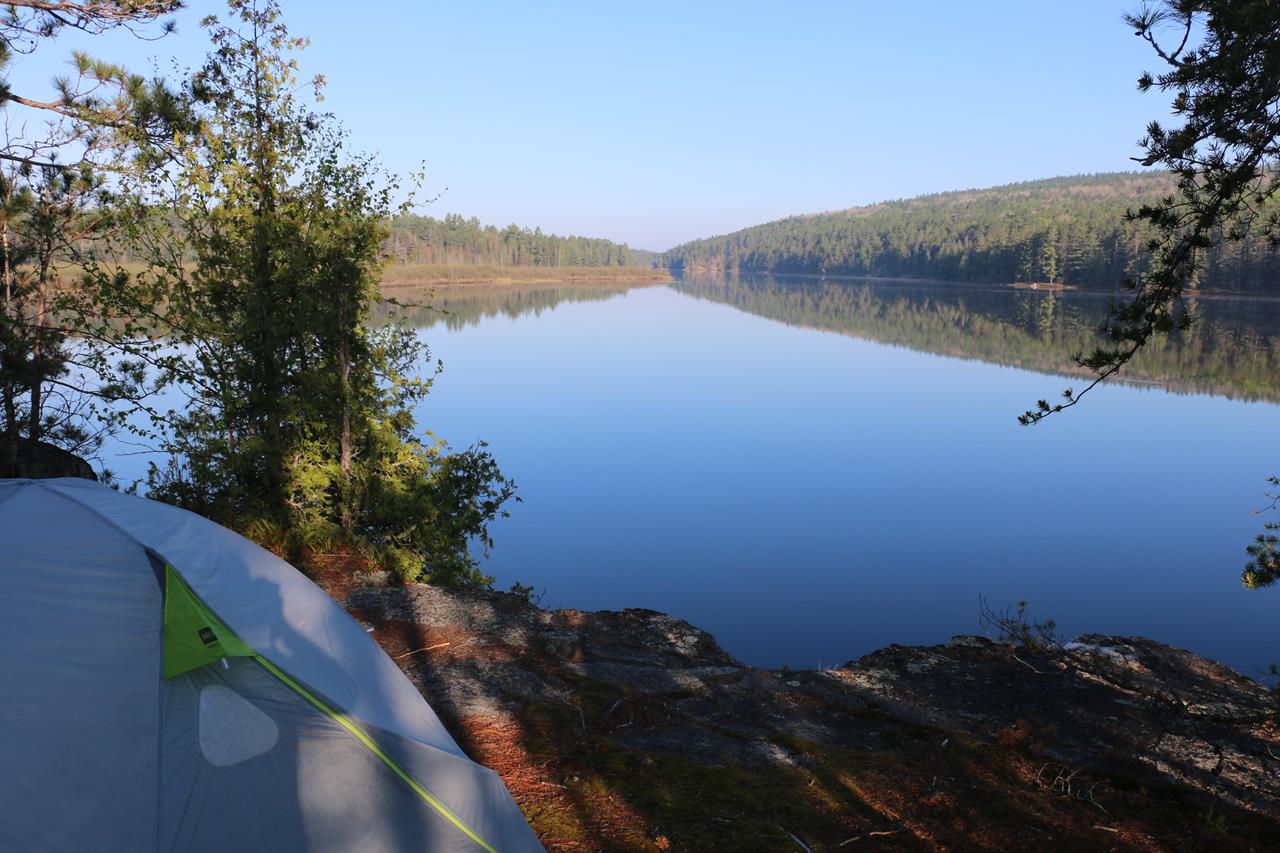 |
| Nothing but sun on Carcajou Lake. |
 |
This was another moving day, but not very far and only two portages. I was in no rush to leave this awesome campsite. About an hour later, Angela emerged from the tent and was also super pleased to see the clear blue sky. I made her a coffee and myself a second. Then we enjoyed the silence of the morning, with more BLT's on bagels. I have to admit, BLTís are probably my most favorite breakfast food, camping or not! Once breakfast was finished, Angela cleaned the dishes while I began to dismantle our campsite. We were much faster this time around compared to yesterday. But we were in no rush. With everything packed up, we proceeded down to the water and loaded the canoe. We hit the water at exactly 11am.
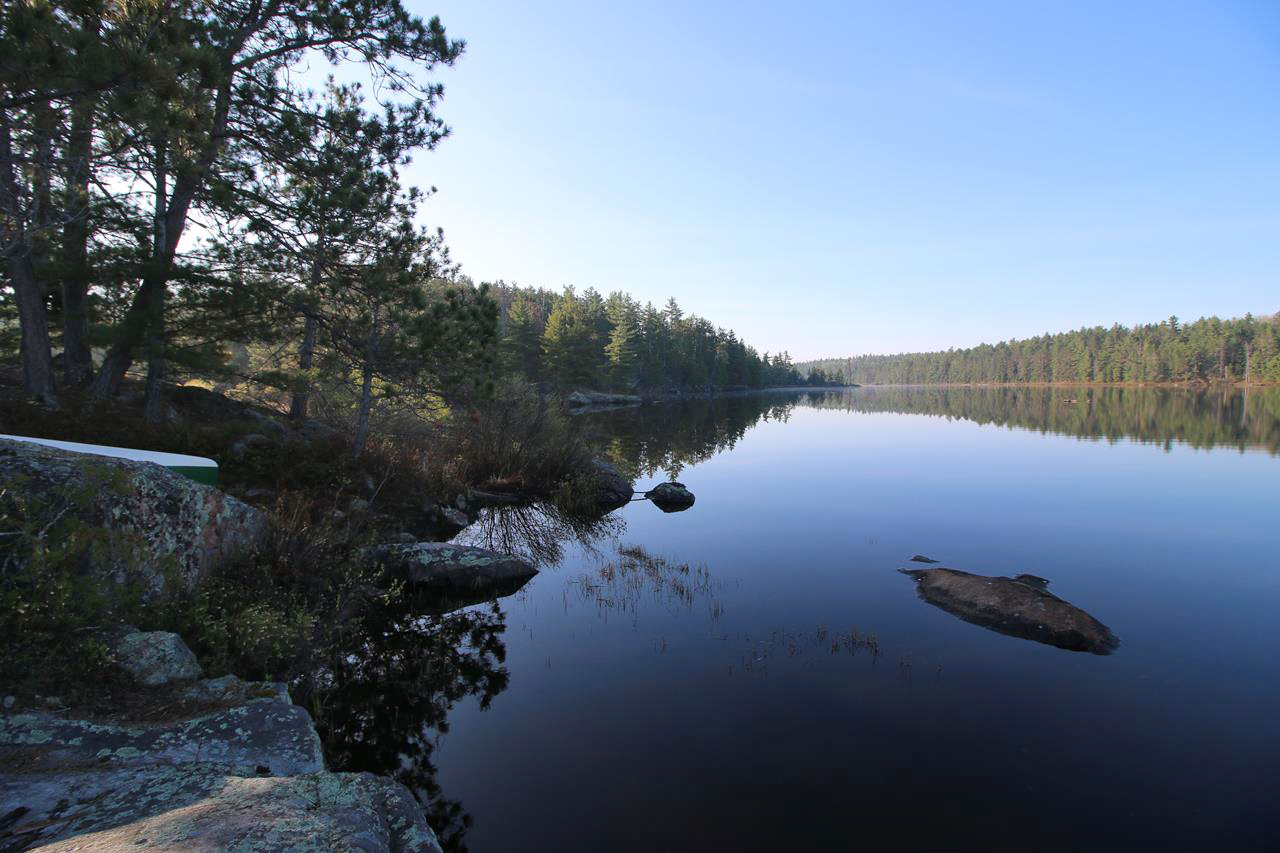 |
| A view down the long bay from the shore. |
 |
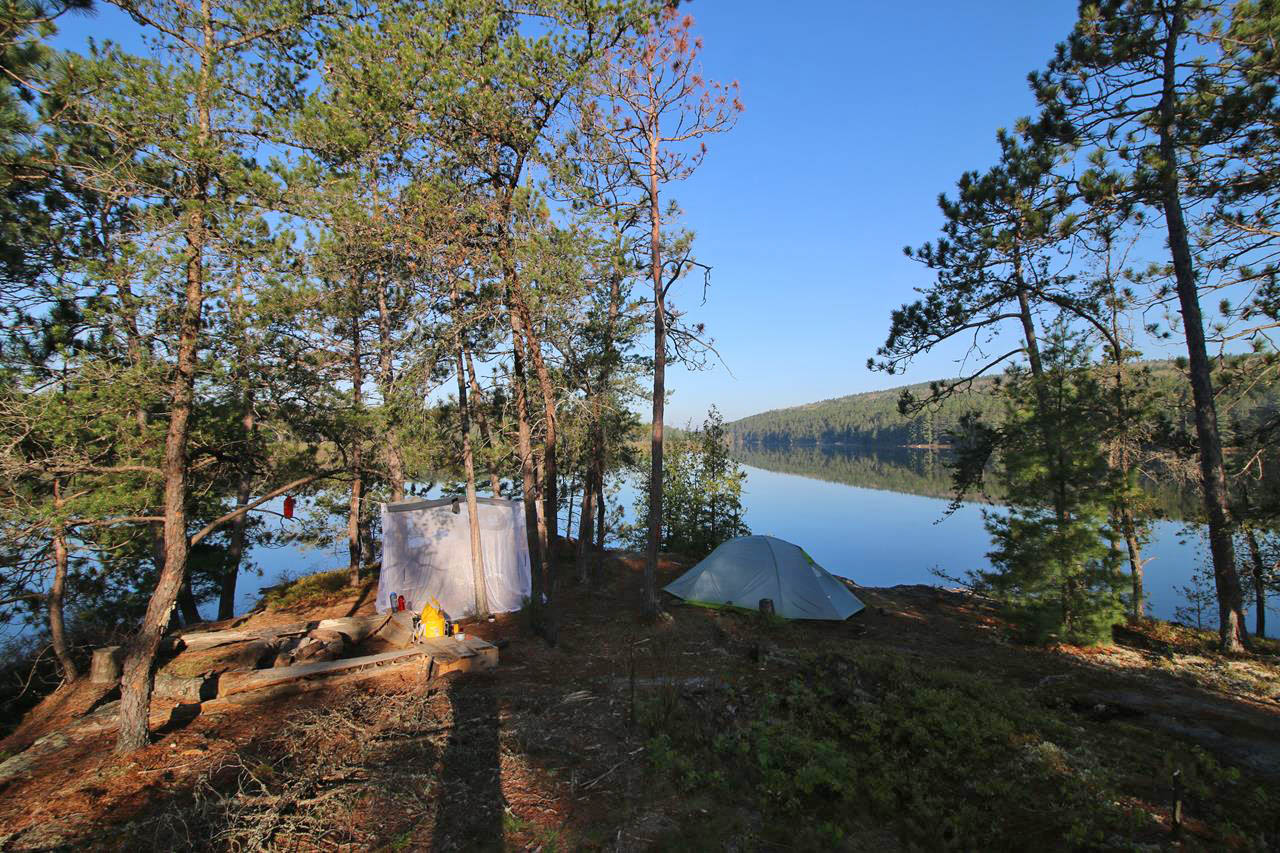 |
| Great open campsite. |
 |
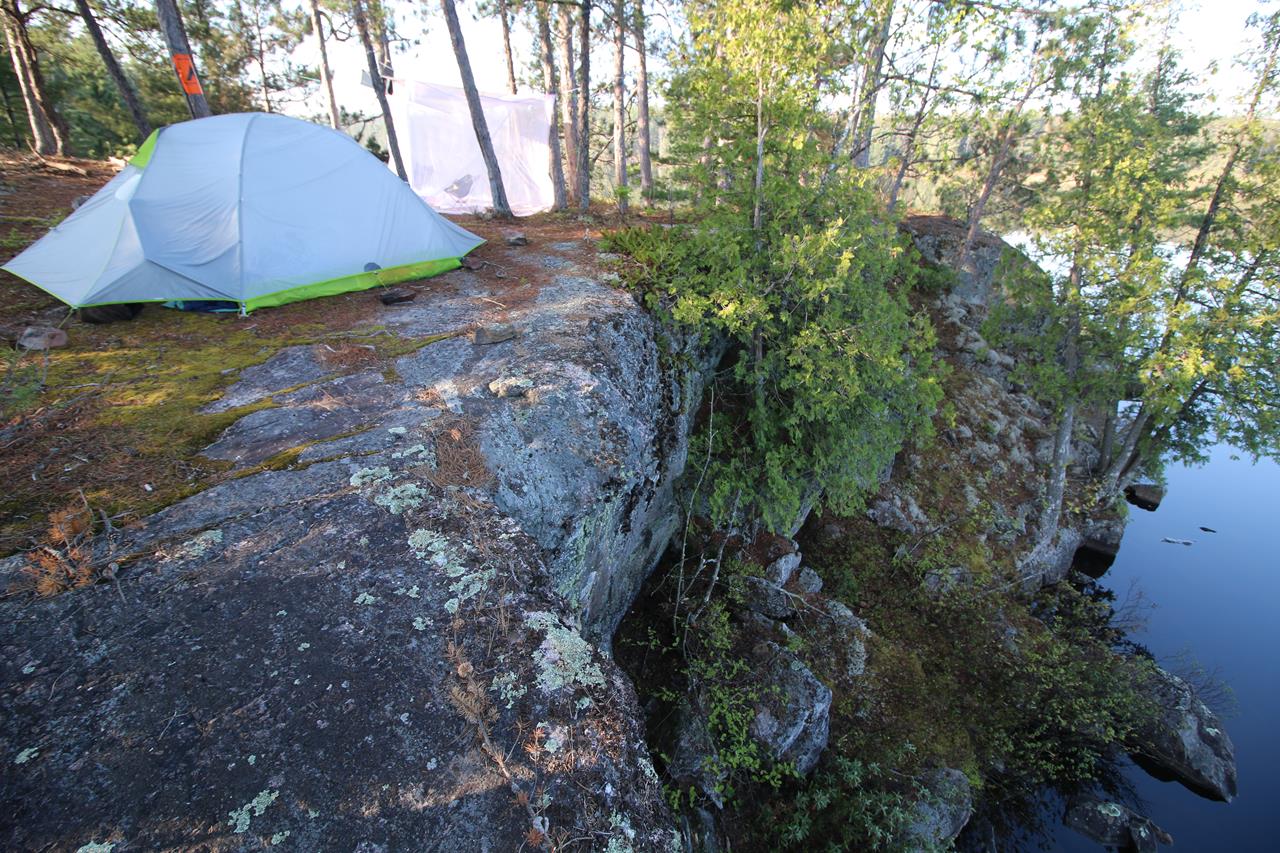 |
| Tent perched up on a cliff. |
 |
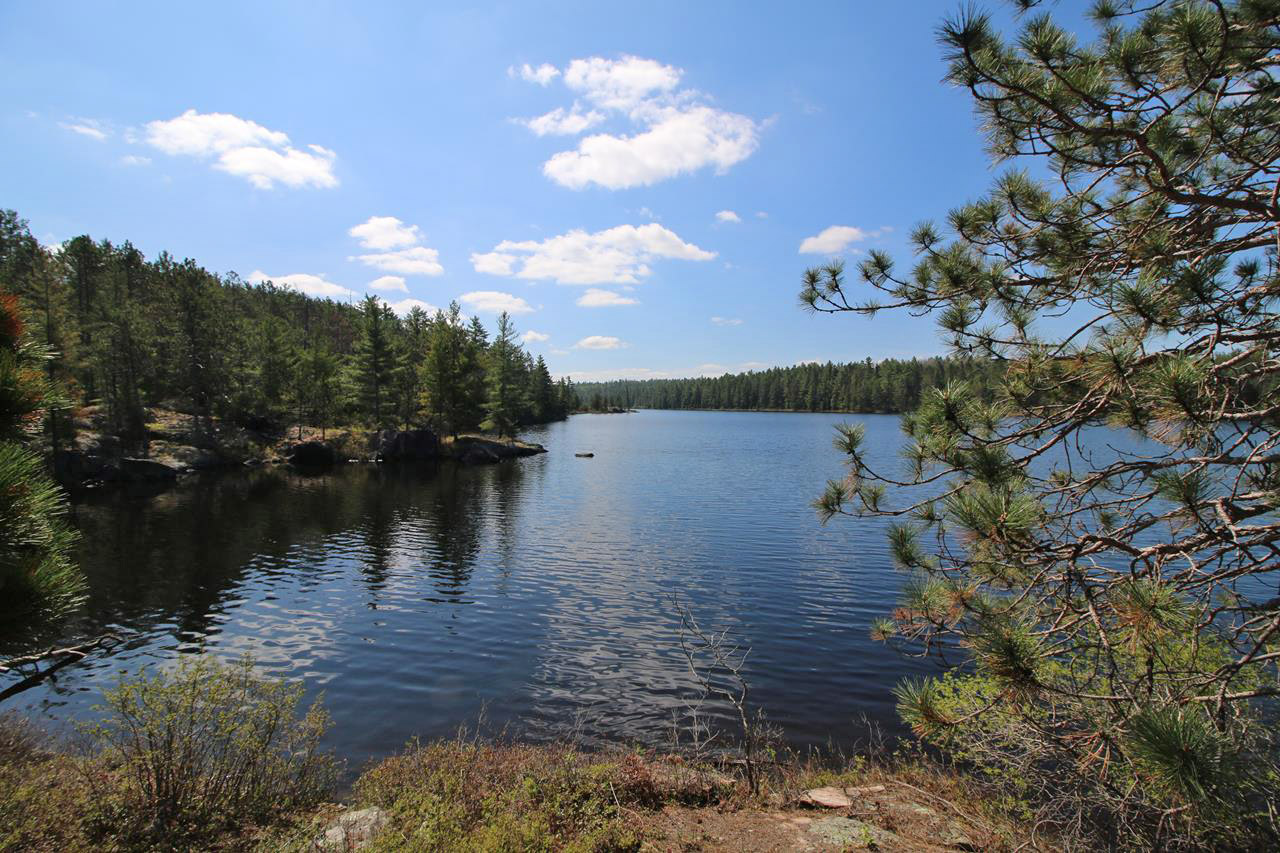 |
| A view down the bay from up high on the campsite. |
 |
Oddly, just as it happened yesterday, as we were pulling out from the campsite another canoe was pulling in. They asked if the campsite was vacant and we said "Yup, itís all yours!" The one guy seemed baffled and even said "I canít believe the best site on the lake is available!" I then went on to tell him how we has acquired this campsite yesterday in the same fashion. They both laughed at the nuances of life and we parted ways.
As we continued up Carcajou Lake I was paddling at a much slower pace than yesterday. We were in no rush to get to Greenleaf. Iíve been to the lake many times, and I know they only book two of the three campsites there, and luckily two of the three campsites are awesome. So it didnít matter which one we arrived at because we knew we would end up with a great campsite either way! When approaching the end of Carcajou Lake the terrain on both sides changes dramatically. Huge rocks jutting out from the high-hilled shoreline could be seen. A little further along the west side is a giant rock wall, probably 200m in length, or more. Itís truly amazing how different the east and west sides of Algonquin Park are. Itís like two completely different parks.
By 11:20am, we landed at the take out to the 285m portage. Once again we made a quick carry over to the other side and were greeted by another huge beaver dam. I was really impressed with the condition of all the portages so far .. no major issues at all. The beaver dam at the put in was holding back the entire marsh we had to travel through. If that dam wasnít there, I do not know that this canoe route would even be passable. It was easily holding back about 2 feet of water. We launched into the sedge meadow and I told Angela to keep her eyes open for wildlife. If there was a place for moose to hang out, this was it. We quietly paddled through the meadow and Angela was impressed with its beauty.
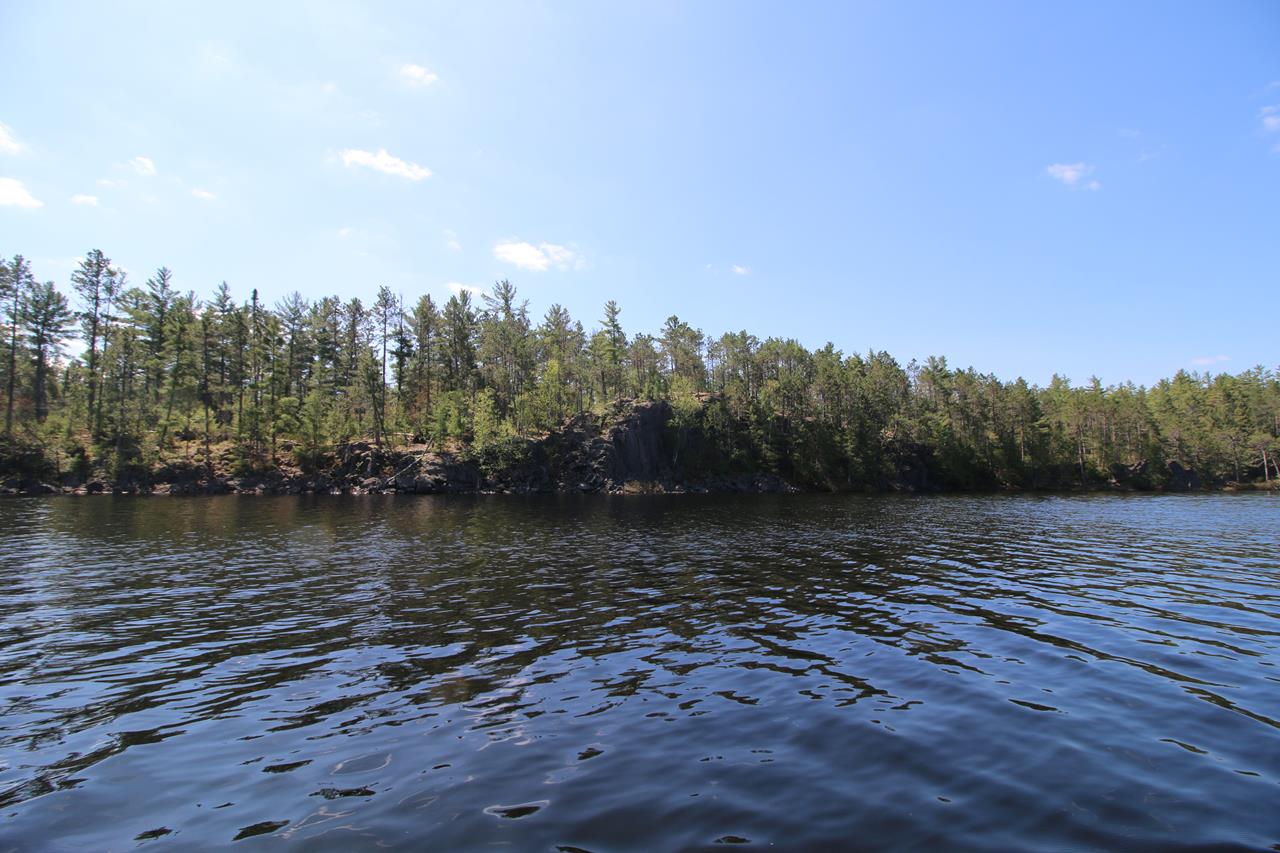 |
| The giant rock wall on Carcajou Lake. |
 |
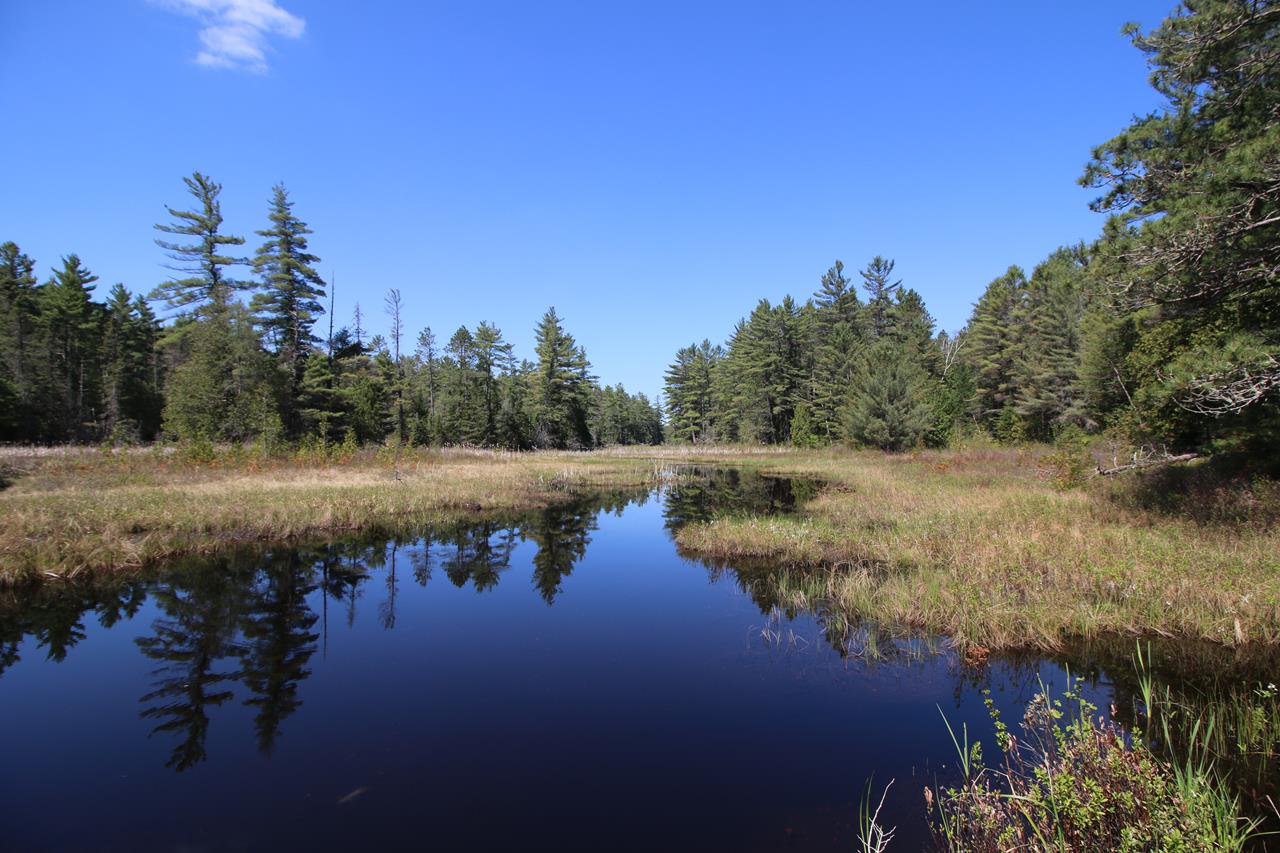 |
| Beaver dam above Carcajou Lake. |
 |
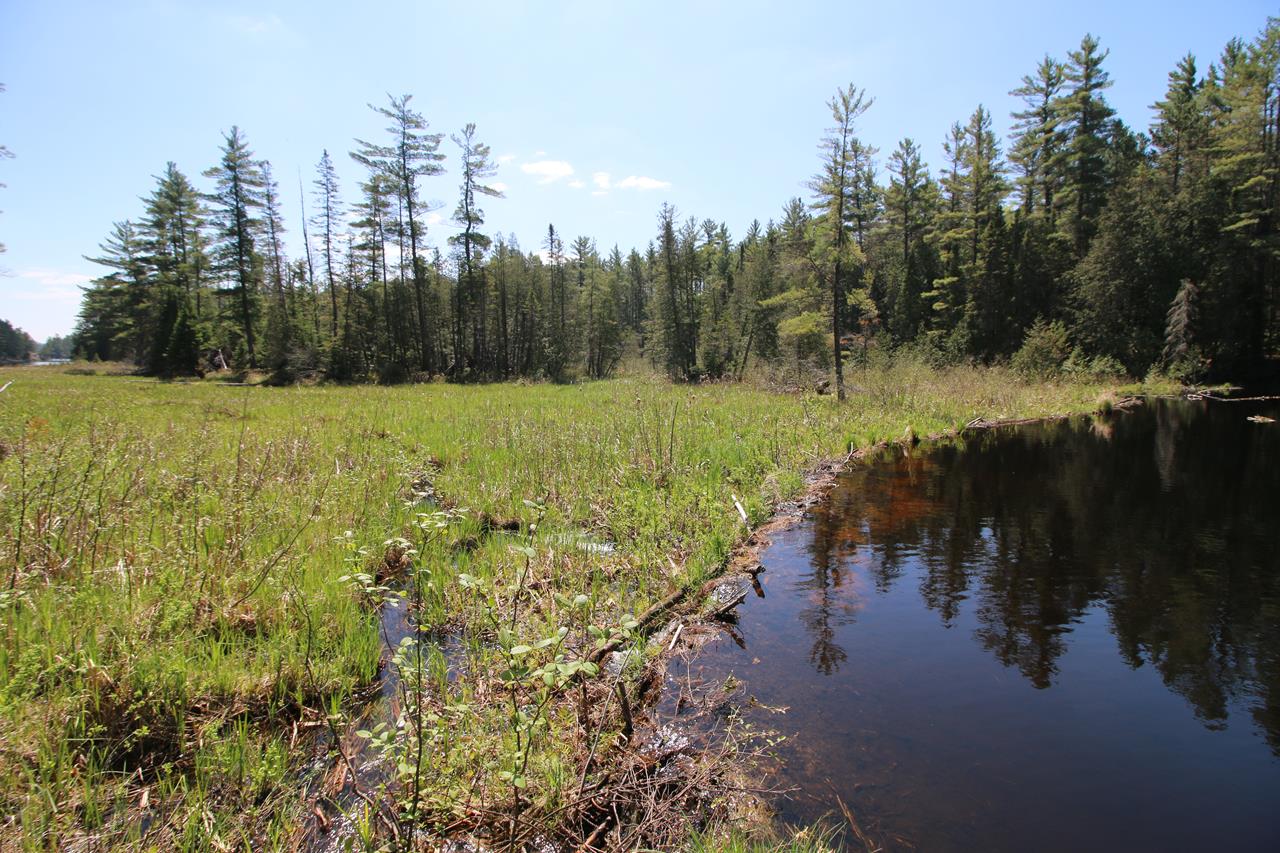 |
| Meadow before the Hydro field. |
 |
A few minutes later, we arrived at the take out to our second and final portage of the day .. a 3-part trail totalling 1,555m. I looked back at the marsh for one last glimpse of a moose, but saw nothing. We loaded up and started down the trail just before noon. This is a relatively easy portage trail as it follows a maintenance road for most of its length. When we completed the first section, Angela was surprised to be at the Hydro Field. I said letís take a quick break; but she wasnít too happy about it. I forgot that last year I'd told her that problem bears are taken to the hydro field because there are ample amounts of berries for them and theyíre not likely to leave. Oops. I didnít think she would remember that. Oh well Ė we took a very short break and continued along the trail.
When we re-entered the forest on the other side of the hydro field, we took another break. We were only 440m away from Greenleaf and I couldnít have been happier. It was beginning to get really warm and I wanted to get to camp so I could take a swim and cool off. After a short break, it didnít take long to complete the boulder-laden trail and to arrive at Greenleaf Lake. As soon as I put the canoe down, I spotted a brook trout hiding among sunken logs in the lake. I quickly pointed it out to Angela and said I saw the same thing last time I was here. This lake must be teeming with fish! Angela was less than excited to see the brookie and was more interested in getting her pack off. It was really getting hot and that 1,555m portage hadn't helped. The put-in was packed with jammed logs, which made for an interesting launch.
We loaded up the boat and began our paddle up Greenleaf Lake. Our target was either the 2nd or 3rd campsite up the lake. We knew that one of them would probably be occupied, and that the only other site on the lake wasn't very attractive. Itís not even at the cool end of Greenleaf. Itís at the south end, where the lake looks like every other lake in Algonquin. Once you get about a third of the way up the lake, you really start to see the changes. Rocky outcrops and boulder gardens on both left and right, and the shoreline becomes very steep, almost as if you are headed into a canyon.
I decided to troll on the way to camp, and dropped a line in the water. As we passed the first campsite, I could see it was unoccupied. I wasnít surprised at this and we continued on. Although the other two sites are both amazing in their own way, I secretly wanted the middle site to be vacant. I had stayed at the last campsite every other time I camped on Greenleaf and had only visited the second campsite, but I remembered it was pretty cool and I wouldnít mind switching it up on this trip. Unfortunately, when approaching the second campsite, I could see a tent and tarp set up. Oh well Ė canít have Ďem all!
The 3rd campsite has a rock couch and a great view of the cliffs, so on we went to stay there. By 1:15pm we'd landed at our campsite .. our earliest arrival yet! It had been two years since I'd last stayed at this campsite and it had pretty much remained unchanged in those two years. The stone couch was still intact, as was the huge fire pit. The other thing that remained unchanged were the bugs. I donít know if itís because of the rocks but this area always seems to be slightly buggier than other areas. Iíve observed this on all three stays on this campsite.
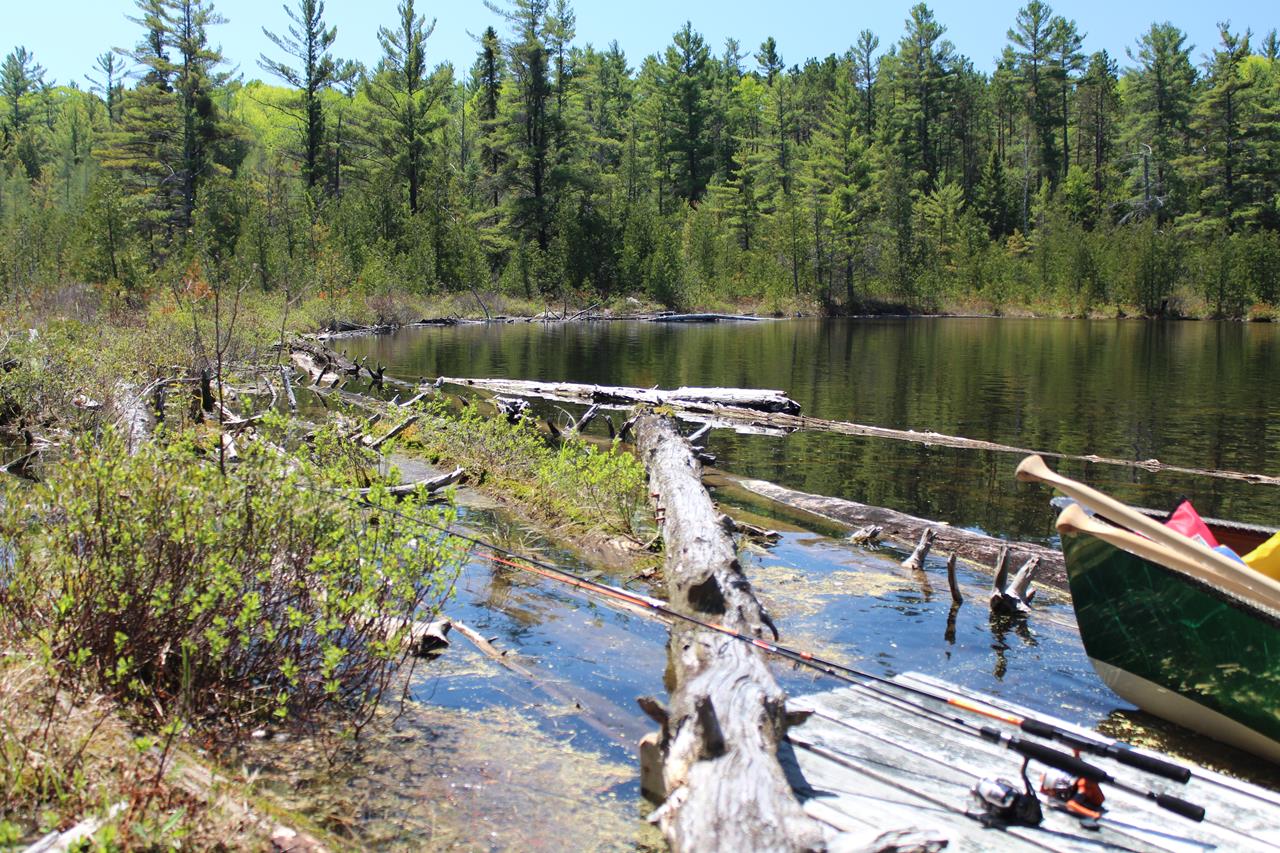 |
| Log jam at the put in to Greenleaf Lake. |
 |
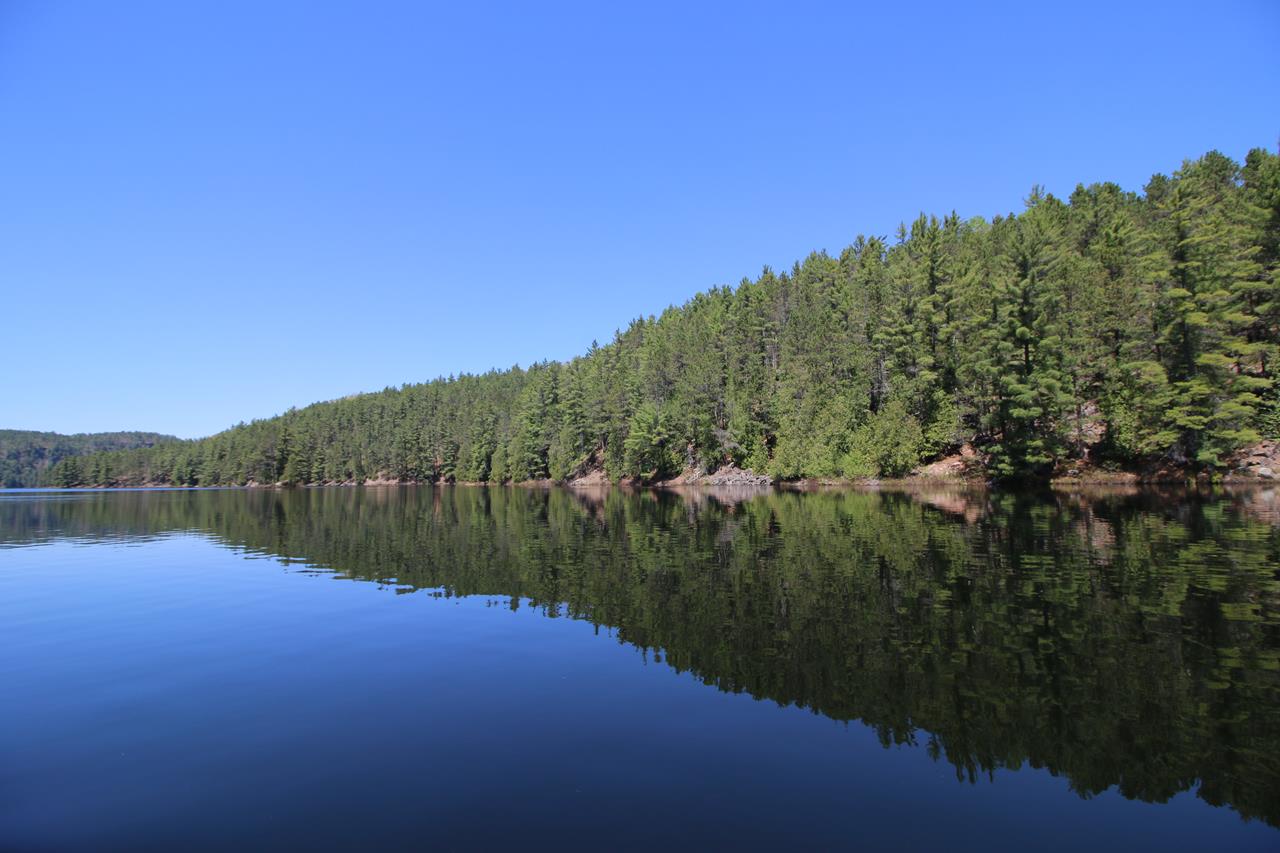 |
| Finally here! Greenleaf Lake. |
 |
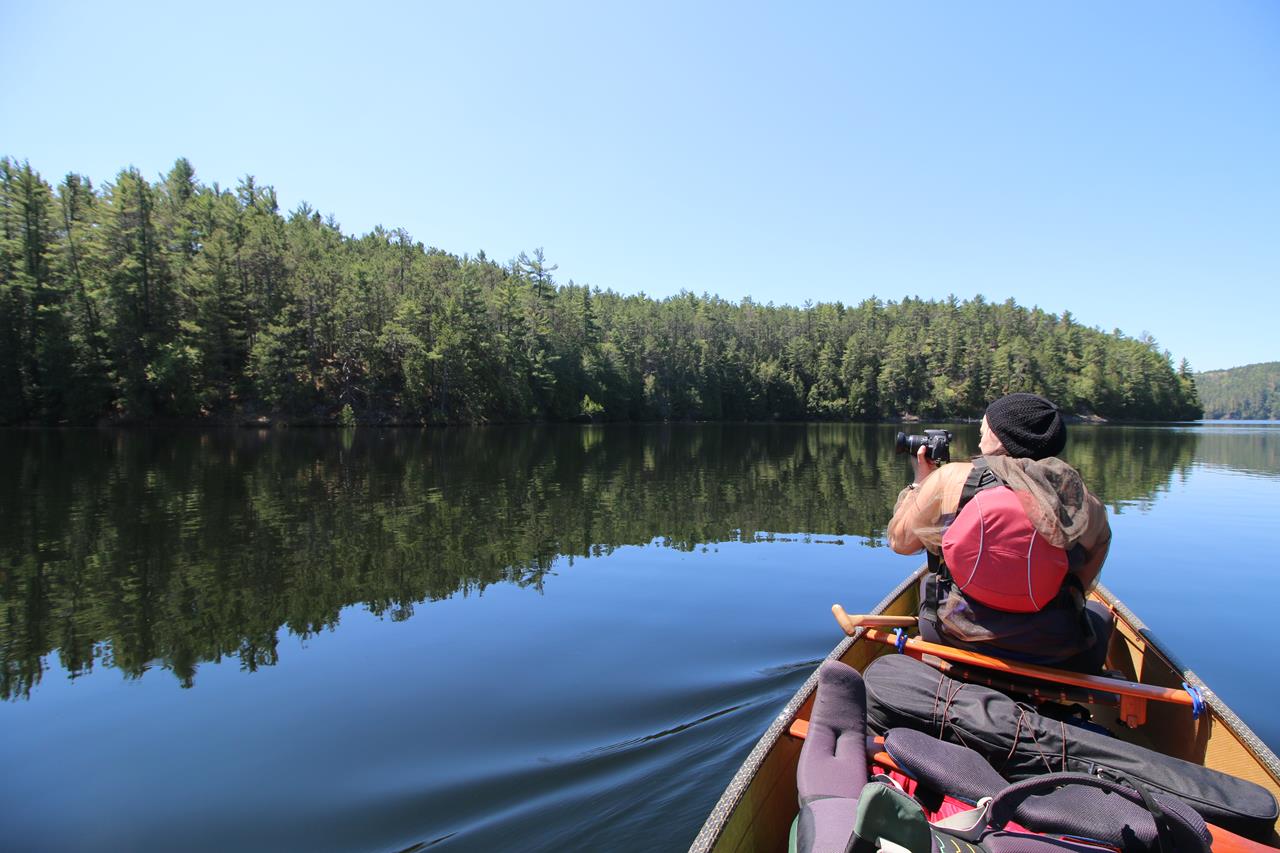 |
| Calm paddle up Greenleaf Lake |
 |
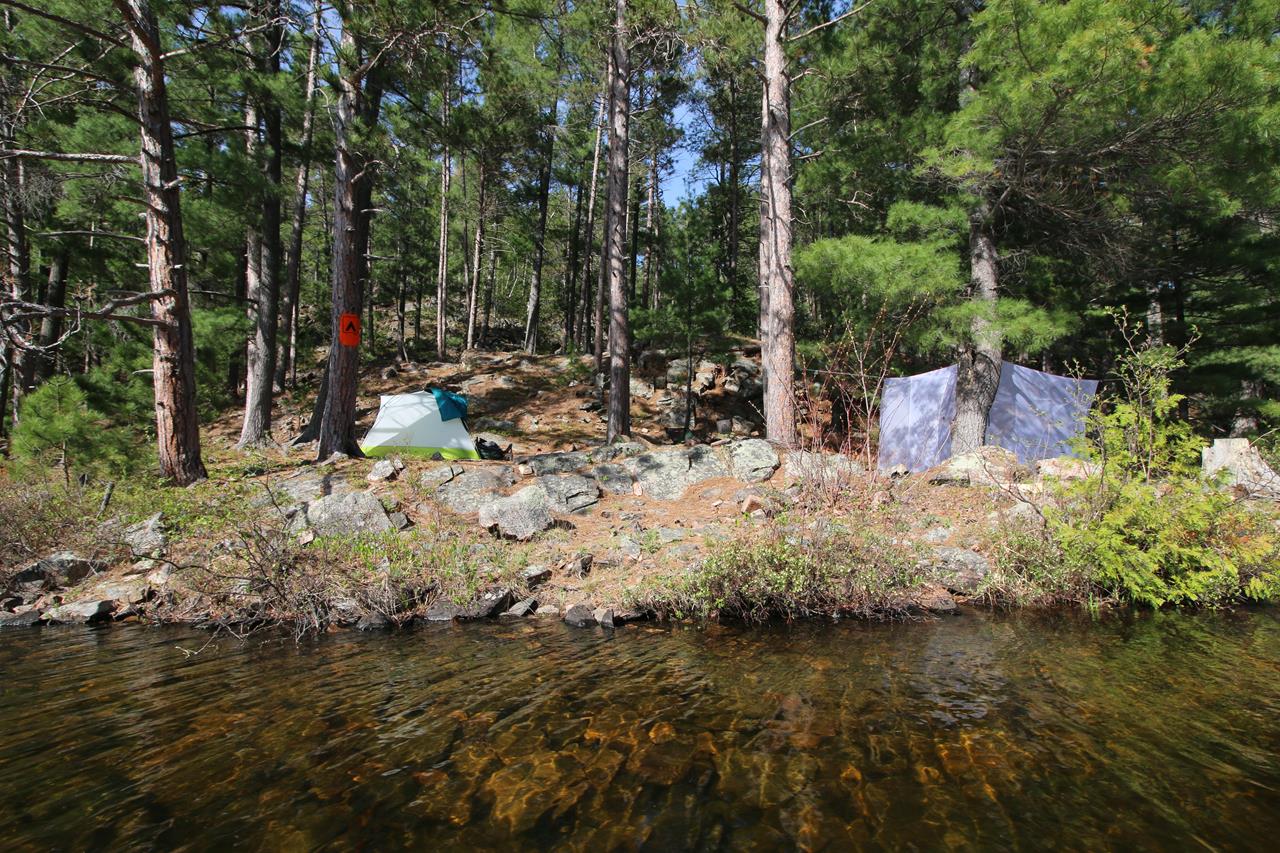 |
| Our campsite on Greenleaf Lake |
 |
With the bugs in mind, I began to set up the bug shelter so we could have a peaceful place to eat and relax. It didnít take long to get camp all set up. By 3:30pm I was really itching to take a swim, both to cool down and to clean up. Angela also wanted to bathe, so we looked around the campsite for a suitable spot to go for a swim. The shoreline of this campsite isnít ideal for swimming. Itís all bushy and shrubby. And even the canoe landing is less than ideal. We decided to hop in the canoe and head up the lake a bit further to see if there was a more suitable place to go for a swim. We paddled all the way up to the cliffs and even up Greenleaf Creek a little bit. Nothing. Itís just too rocky and rugged, and the few giant rocks we did find were swarming with bugs. So Angela wasnít having any of that.
As we started back to camp, we spotted a big slab of rock sloping into the water. It looked like it would do, but when we pulled up to it we realized the angle of the slope was close to 45 degrees, or more, which made it especially difficult to work with. Never the less, we made use of the spot. My clothes we getting a little ripe and saturated with sweat, so I decided to jump in fully clothed to give them a chance to rinse out. I swam around the lake for a few minutes, then exited and removed all my clothing and jumped back in.
Then I became worried about being naked and snapping turtles. So I didnít stay in very long. Angela had decided to bring her Helinox chair along and placed it into the water to bathe. The sun was beaming and I was really happy to finally get a chance to clean off. We both finished up and got back in the boat to head back to camp. We arrived back at camp by 5pm and I decided to collect some firewood, but I didnít need much as there was already a decent pile left behind Ė probably from winter campers. I say that because not only was there evidence of snowmobiles accessing Greenleaf Lake, but the wood that was left over was cut with a chainsaw then split Ė and these were not small pieces of wood. They were also fairly dry, which implies they were not recent cuts and had probably been seasoning for a few months.
The dinner plan for the night was one of two things Ė either chili and bannock or lake trout and bannock. The problem with the second option was we needed to catch a lake trout before that plan could actually come to fruition. I asked Angela if she wanted to come out fishing for dinner with me. She did! How awesome is this girl, eh? We loaded up the canoe with some tackle and our rods then made our way back up to the cliffs at the north end of the lake. My first instinct was to head to the falls flowing in from Lost Lake and cast into it. We did this for about 20 or 30 minutes and nothing, except a twig I managed to salvage from the bottom or the lake. I recommended we start trolling, so I asked Angela to let out as much line as possible while I paddled us parallel to the cliff face. Fifteen minutes later I had something. It resisted at first, but then stopped suddenly. I figured I had another twig or stick. But as I reeled it in, there was resistance again. This time I knew it was a fish! I pulled him up and into the canoe.
Lake Trout for dinner .. not the biggest trout but enough for dinner. I unhooked him and Angela looked back and said "Heís cute, maybe we should let him go." I chuckled because we were out here to find dinner, so I told her to turn around and I did the deed. I thanked the spirits of Algonquin and thanked the fish for his life.
I started to paddle back to the campsite, while Angela kept trolling. Not ten minutes later she hits a snag. I told her to reel it in and just as I said that, the snag pulled back. She was so excited. I spun the canoe around to give her a better advantage and sure enough .. another lake trout! Slightly smaller than mine, and since the first one was on the smaller side I told her we would keep this one too and weíd have an all-out spring opener fish fry!
We both had conservation licenses and were authorized to each keep a fish. Considering Iíve harvested less than a dozen trout from Algonquin Park since 2009, I didnít feel like a glutton. We'd set out to catch dinner and we did just that! I was so proud of her for bringing in a lake trout. She was happy too, but I insisted she should be more excited. I explained there are people who come from all over the world to catch the elusive Algonquin Trout and she should be thrilled she got one! I think she felt bad because these fish were destined for the frying pan. When we got back to camp, I made quick work of cleaning and filleting the fish, while the bugs had their way with me. Back in 2012 on Head Lake I was taught a fairly solid method of filleting trout by my buddy Mark Steel. I've used it on every fish I've harvested since then. The bugs were really starting to come out, which made cleaning the fish a lot more challenging than it should have been.
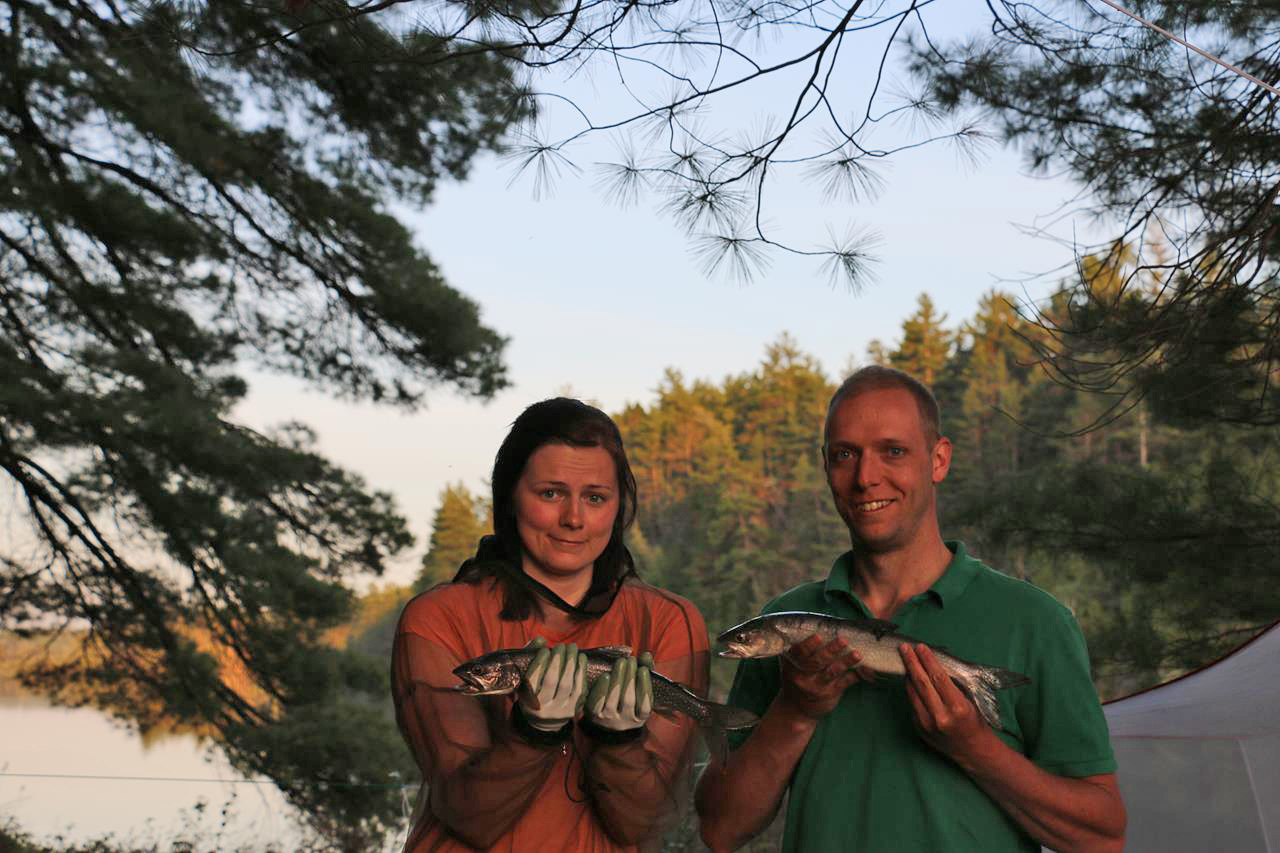 |
| Trophy shot: Angela isnít please with having to hold the fish for a photo. |
 |
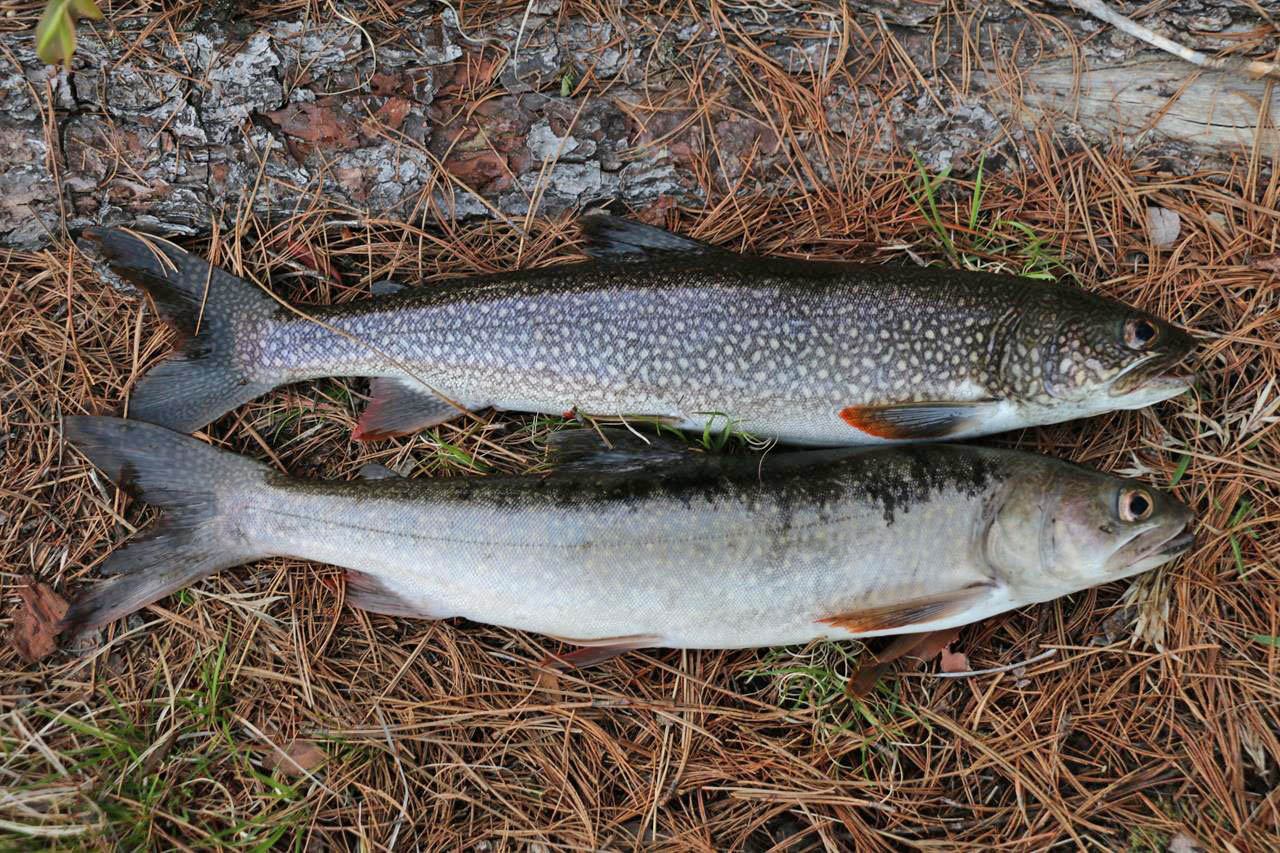 |
| Our dinner for night three: Two fresh Algonquin lake trout! |
 |
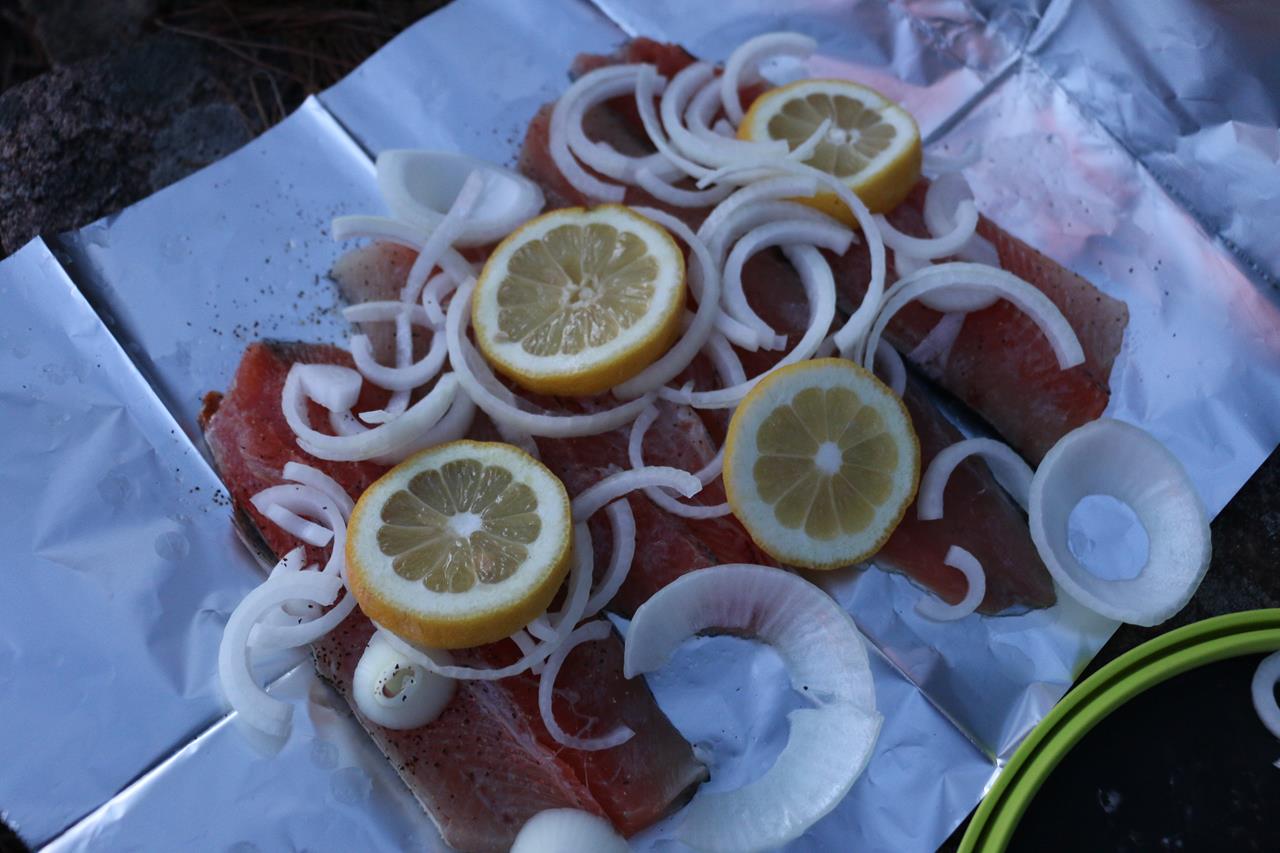 |
| Trout, onion, lemon and black pepper. Into the coals they go! |
 |
With the fish filleted, I seasoned them with fresh lemon, onion and black pepper. I then wrapped the fillets in foil and placed them into the coals to slow-cook. We also had potatoes and bannock to go along with our fish. We also had a Mountain House dehydrated meal of pasta primaveraas. We decided to have an all-out feast. It was nothing short of sheer awesomeness. As dark settled in, the bannock, potatoes, pasta and fish were all ready to go. The only thing missing was some daylight. I hate to eat in the dark. I donít know why, but it just annoys me. Nevertheless, the meal was perfect. Angela had been fortunate to sample fresh brook trout on North Tea Lake on a previous trip and here she was eating fresh lake trout. She mentioned that she preferred the brookie, but that may have been due to how it was cooked. In my rush to fillet the fish while fending off the black flies, I missed two spots with bones. The bones donít bother me as the meat flaked right off but it creeped Angela out a little bit.
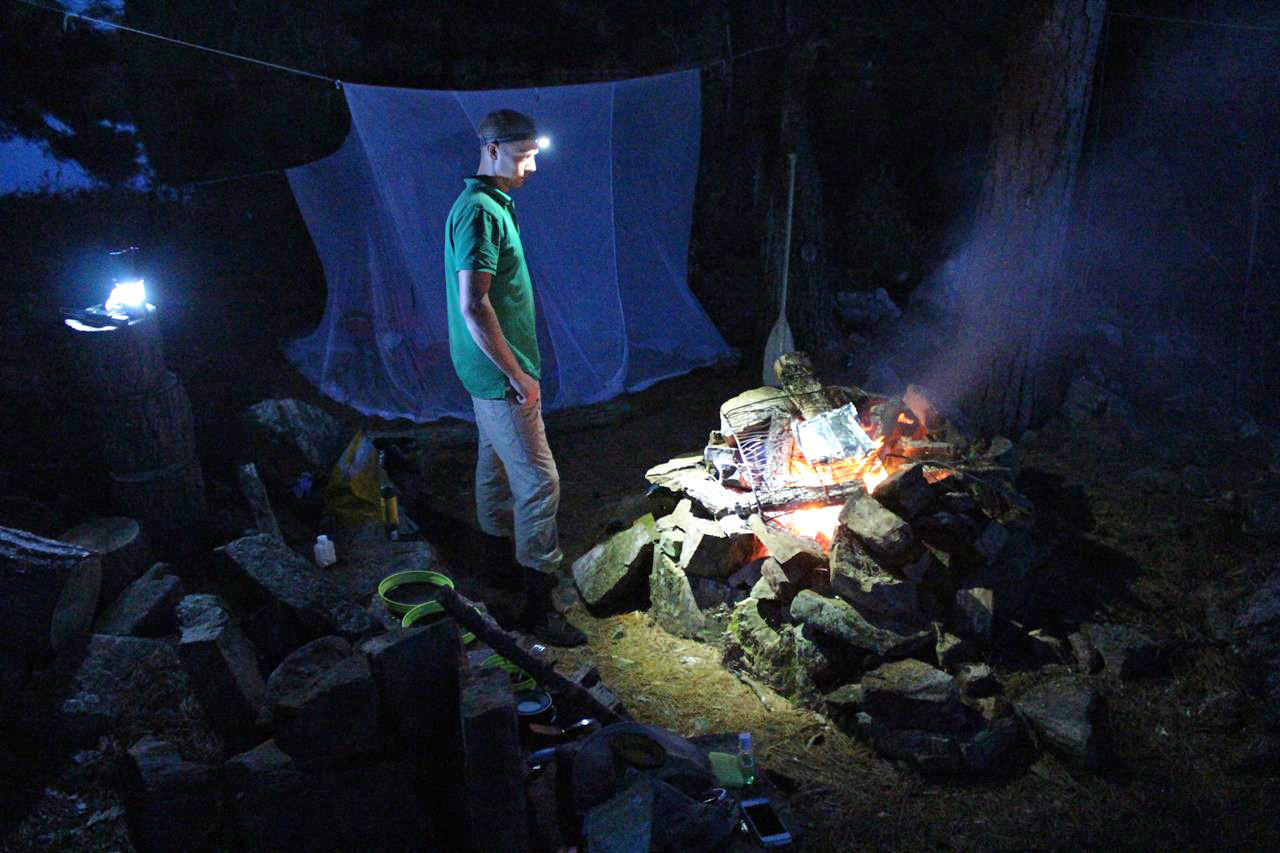 |
| Dinner is almost ready. |
 |
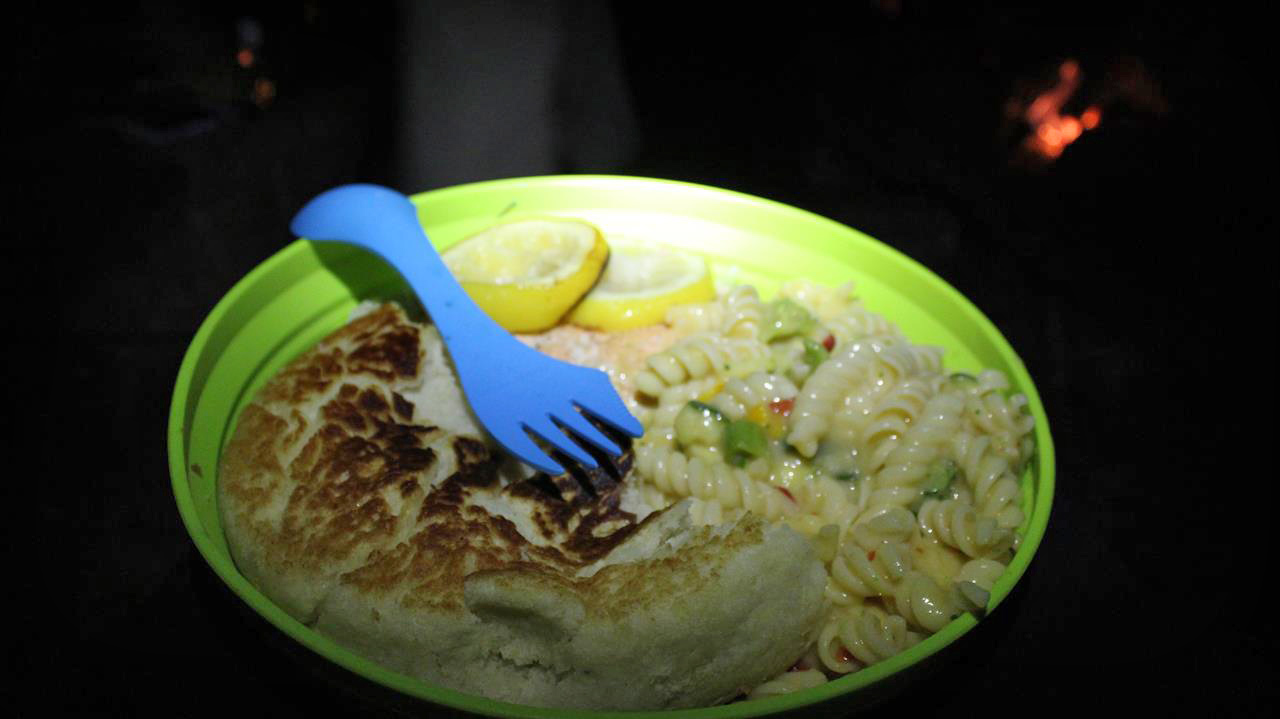 |
| Lake trout with lemon, fresh baked bannock, pasta primavera & potatos still roasting. |
 |
After enjoying the huge feast, we cleaned the dishes and hung the food. A few more logs on the fire and we were both able to relax. We stayed up for about an hour, enjoyed a couple of drinks and the ability to sit by the fire without being harassed by mosquitos and black flies. By 11pm, we were both tired and decided to hit the hay.
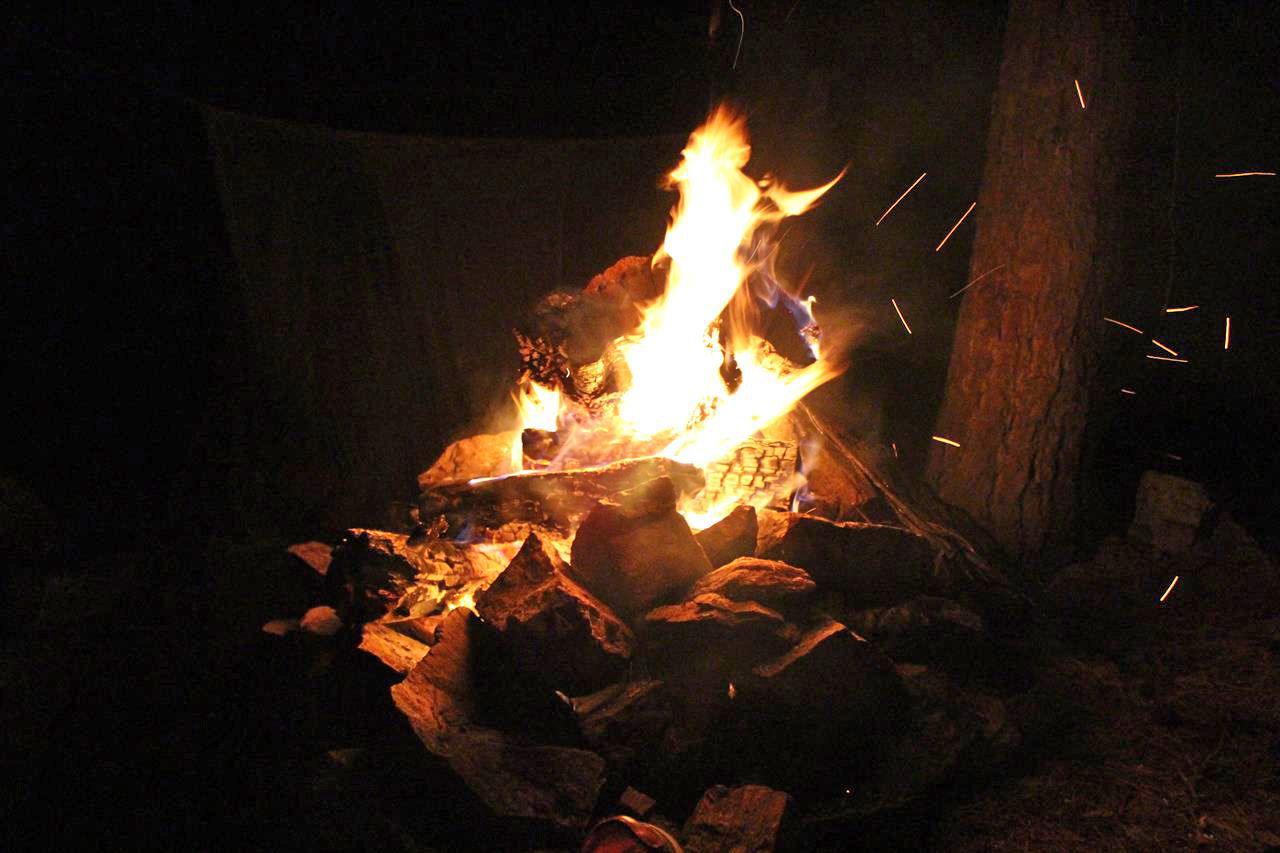 |
| Huge fire to warm up and burn all the garbage & food scraps. |
 |
Day 4 Ė Monday May 18th, 2015: Daytrip to Barron Lake
I slept like a baby and even managed to sleep in a little bit. By 8am, I was up and out of the tent. I retrieved the food bag and put a pot of water on the stove for coffee. The bugs were getting noticeably worse as the trip progressed. This was our off day, and we had no immediate plans to do anything.
I hung out in the bug shelter and enjoyed a couple of cups of coffee, while I looked over the map and retraced our route so far. I had my eye on one of two daytrips. I wanted to either bushwhack up and over to Lost Lake or visit Barron Lake. The trip to Lost Lake was something Iíve wanted to do for a while now. I made an attempt at this back in 2012 but I turned back as the trip was too risky to undertake while solo, since you pretty much have to climb a waterfall to get there. I had described the idea to Angela the day before, and she mentioned that she would prefer to go to Barron Lake. I was okay with this idea because I wanted to have a closer look at Barron Lake myself. I had passed through the lake last year on a long trip. however, I'd stayed one lake further on (at Loonskin Lake), which was nothing more than a giant, leech-filled swamp. I'd noted to myself on that trip that next time, I would either stay on Barron or continue through to North Branch Lake, but never Loonskin again. I remembered Barron Lake being a beautiful lake, surrounded by giant red pines. There was one campsite in particular I wanted to see. It was on a huge point jutting out into the lake, and had looked very inviting. I poured over the map some more and eventually Angela emerged from the tent. I made her a cup of coffee and asked what she wanted to do. "Drink coffee," she replied. I was okay with that, for now.
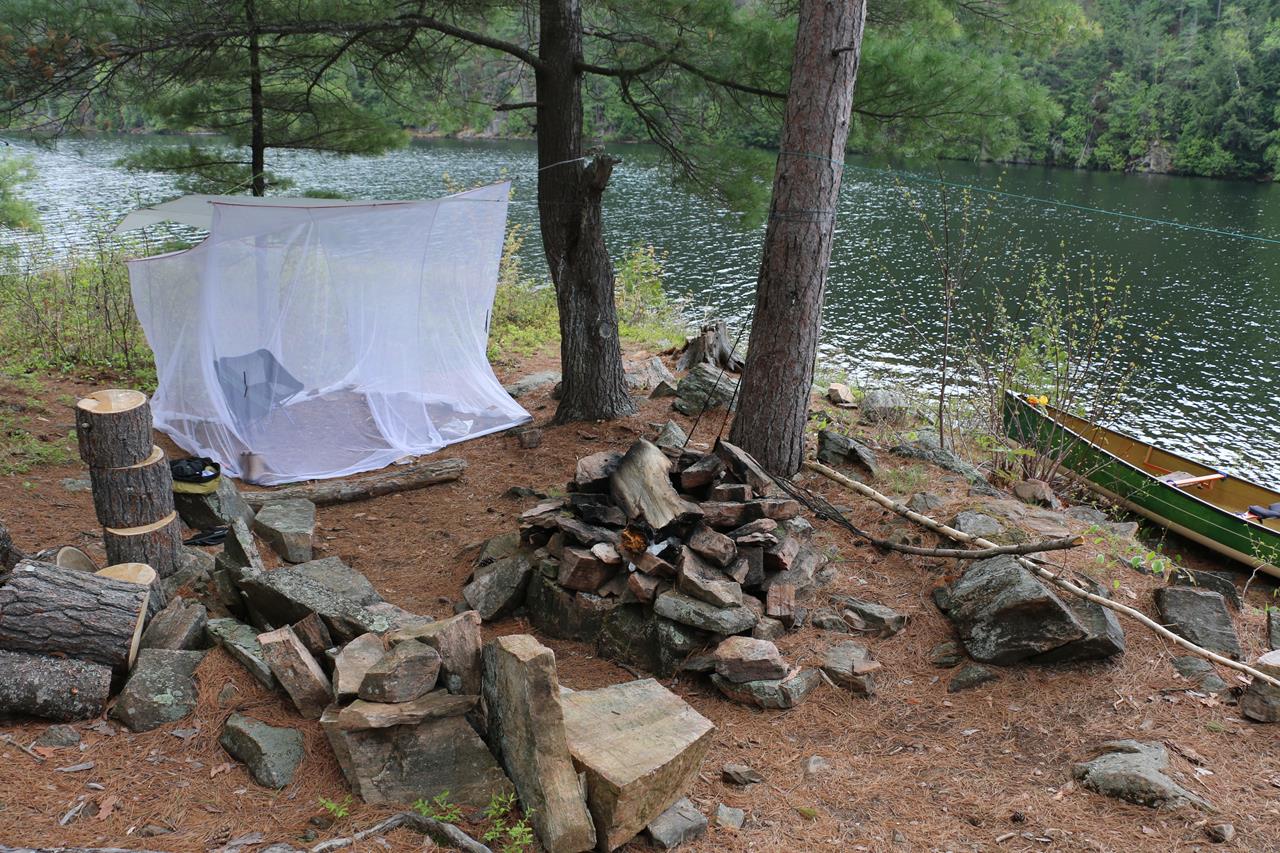 |
| Shelter from the morning bugs. |
 |
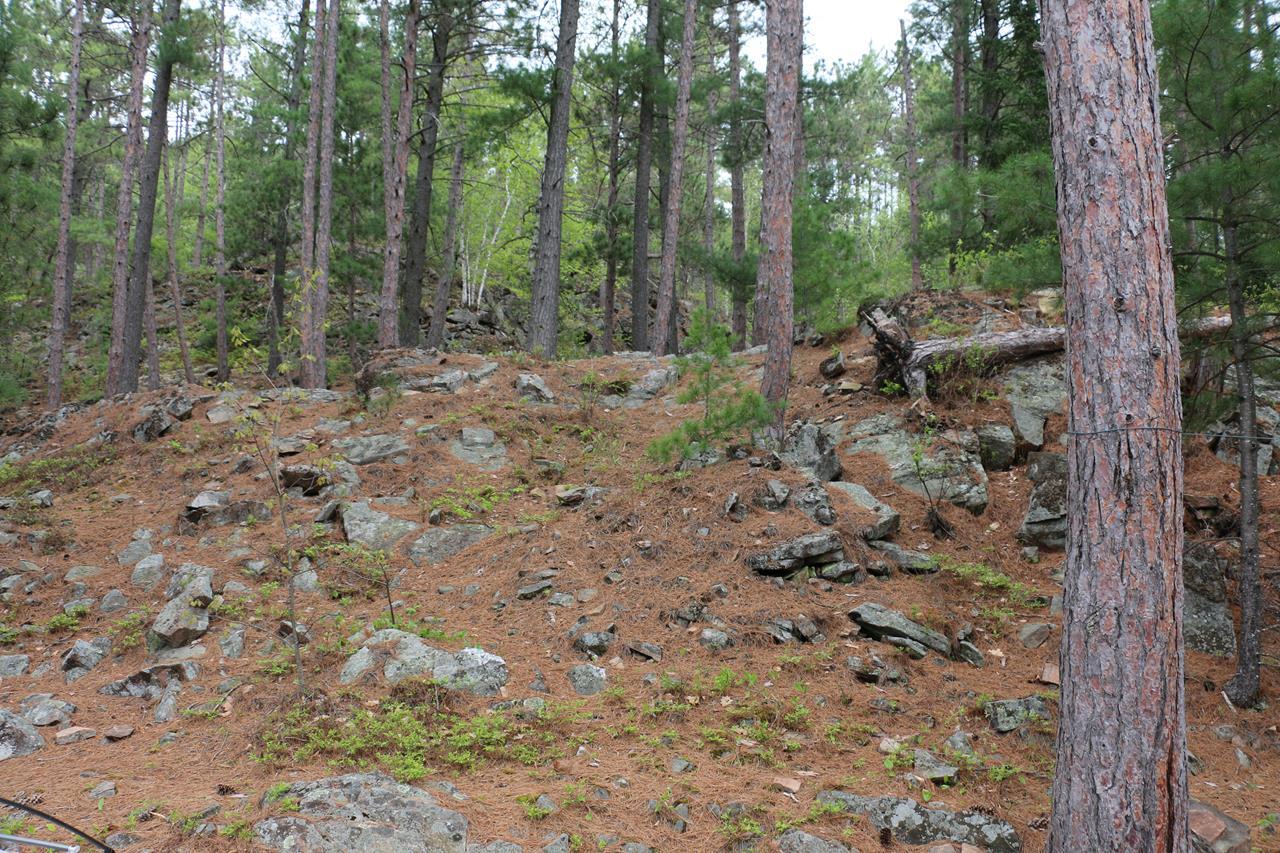 |
| The thunderbox is up there .. somewhere. |
 |
For breakfast we had pancakes and syrup, and I thoroughly enjoyed it. Following breakfast, Angela went back to bed as she hadnít slept very well. While she napped, I cleaned up the campsite, re-hung the food and prepared a day pack to take to Barron Lake. I let Angela sleep for almost two hours and just after noon I woke her up. She felt much better following her second sleep.
We soon shoved off in the canoe on our way to Barron Lake. We took a leisurely paddle down Greenleaf Lake and stopped by the middle campsite, which was now vacant. Angela suggested we could move here, but I wasnít keen about re-establishing camp only a few hundred meters from where it was already established. I walked the site over and it was just as I had remembered it .. many different levels with the main camping area tucked between two ridges. It would provide decent protection from the wind, but in bug season you donít want protection from the wind. You want the wind! We jumped back in the canoe and headed across the lake to the portage leading to Barron Lake.
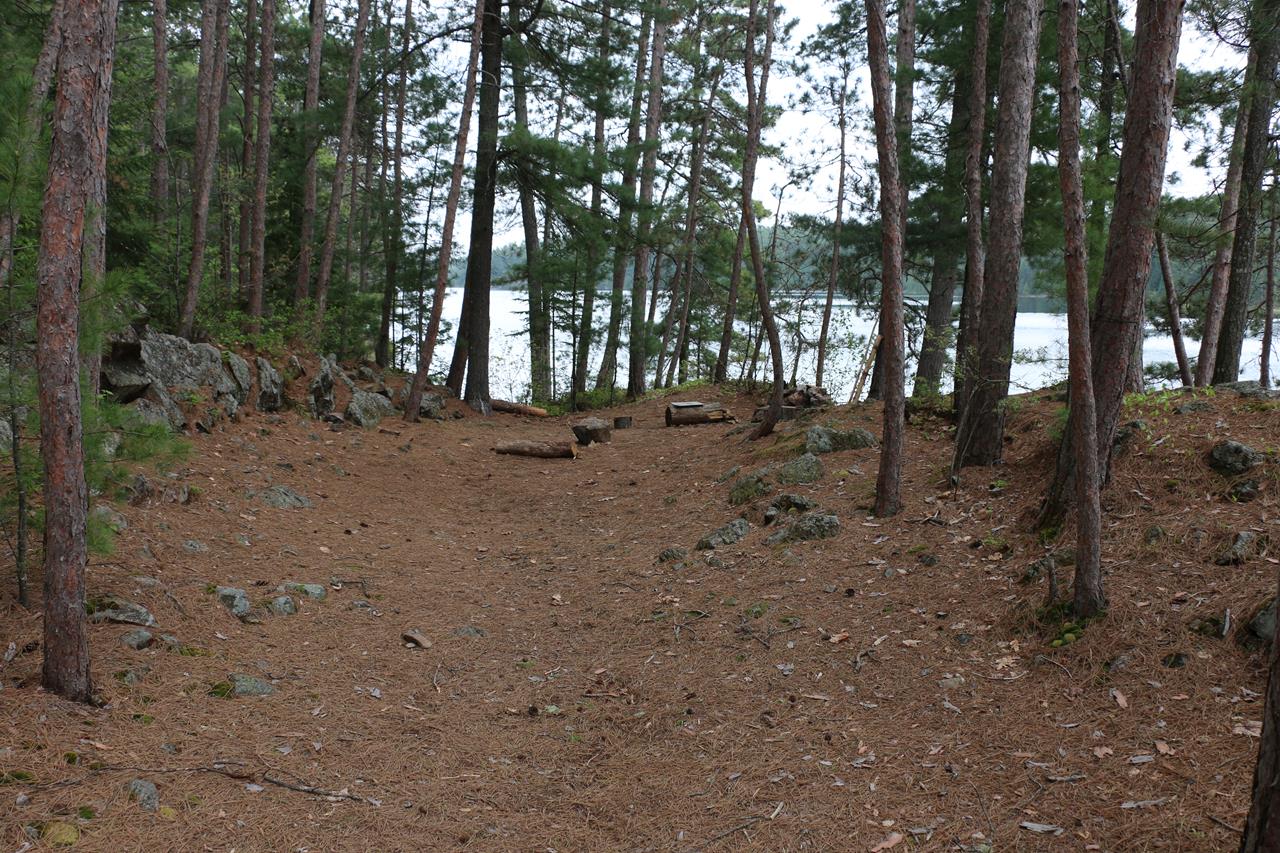 |
| The middle campsite on Greenleaf Lake. |
 |
Iíd crossed this portage once before, but didn't remember it being such a challenge. The landing is covered in large moss-covered boulders which makes exiting the canoe a bit of a challenge. Even worse, is the trail itself. Itís a shallow but constant uphill climb and is littered with even more moss-covered boulders. The safest bet was to just take it slow. There were three large fallen trees, but only one of them required me to drop the canoe. About 25 or 30 minutes later we arrived at breezy Barron Lake. My plan was to circumnavigate the lake, checking out each campsite for a possibly future trip. The wind was up by now, but it wasnít so severe that we couldnít continue.
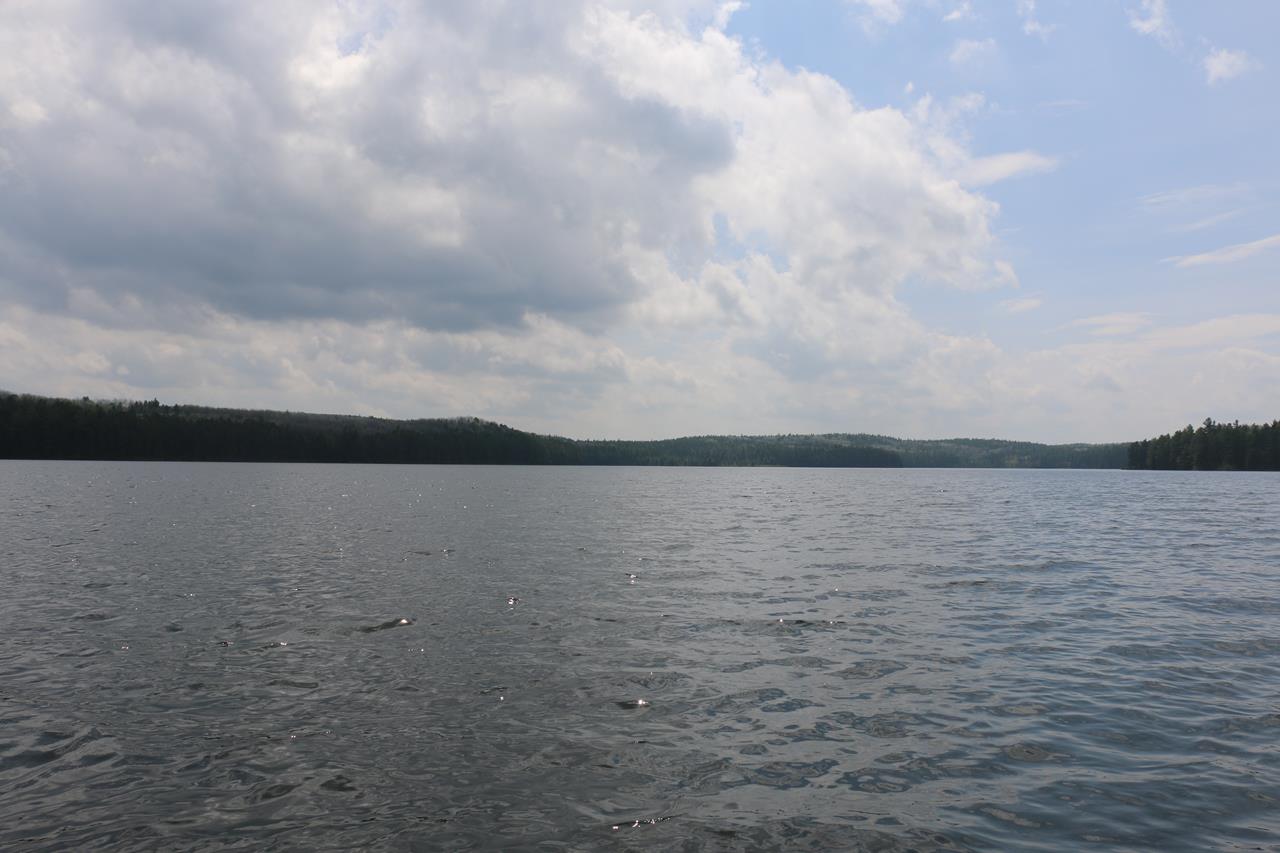 |
| Arriving at Barron Lake. |
 |
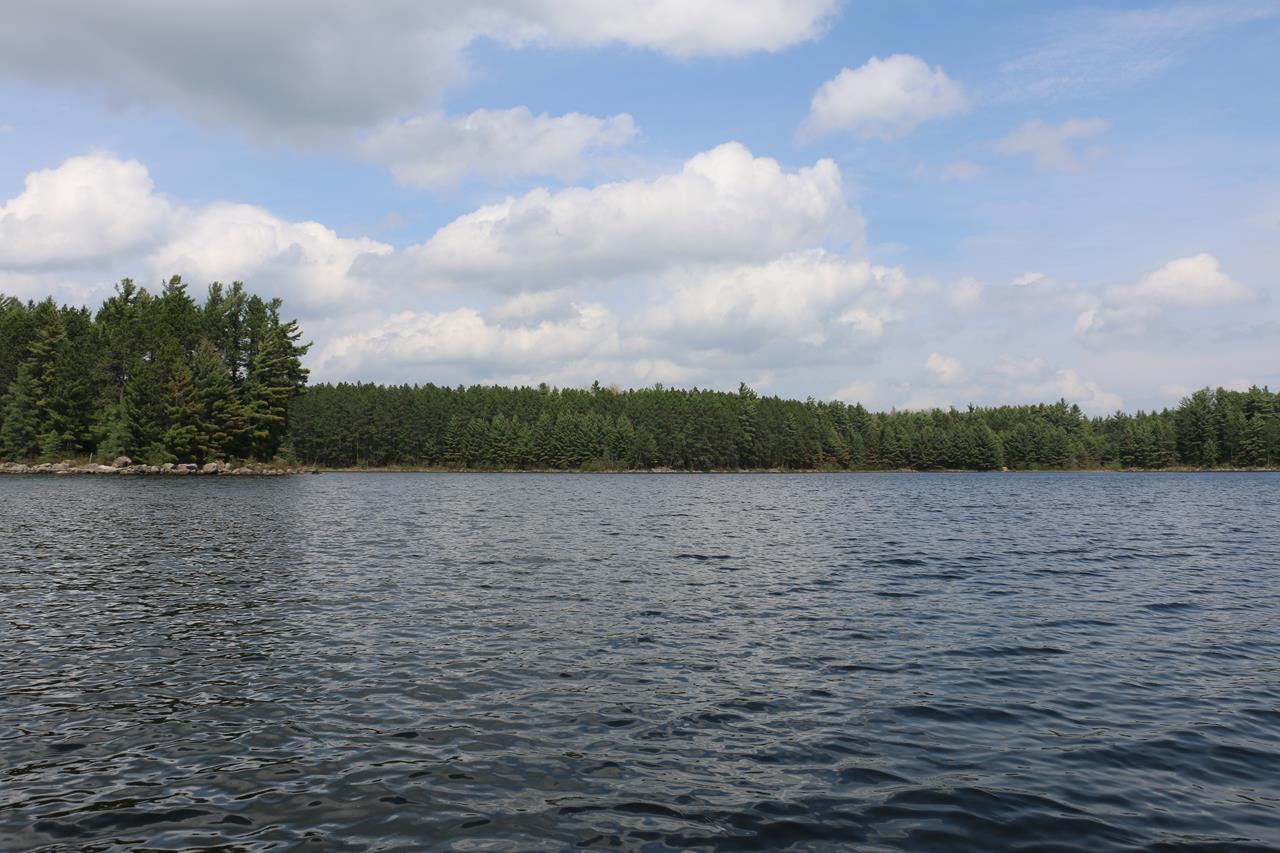 |
| Pine and rocky shoreline. |
 |
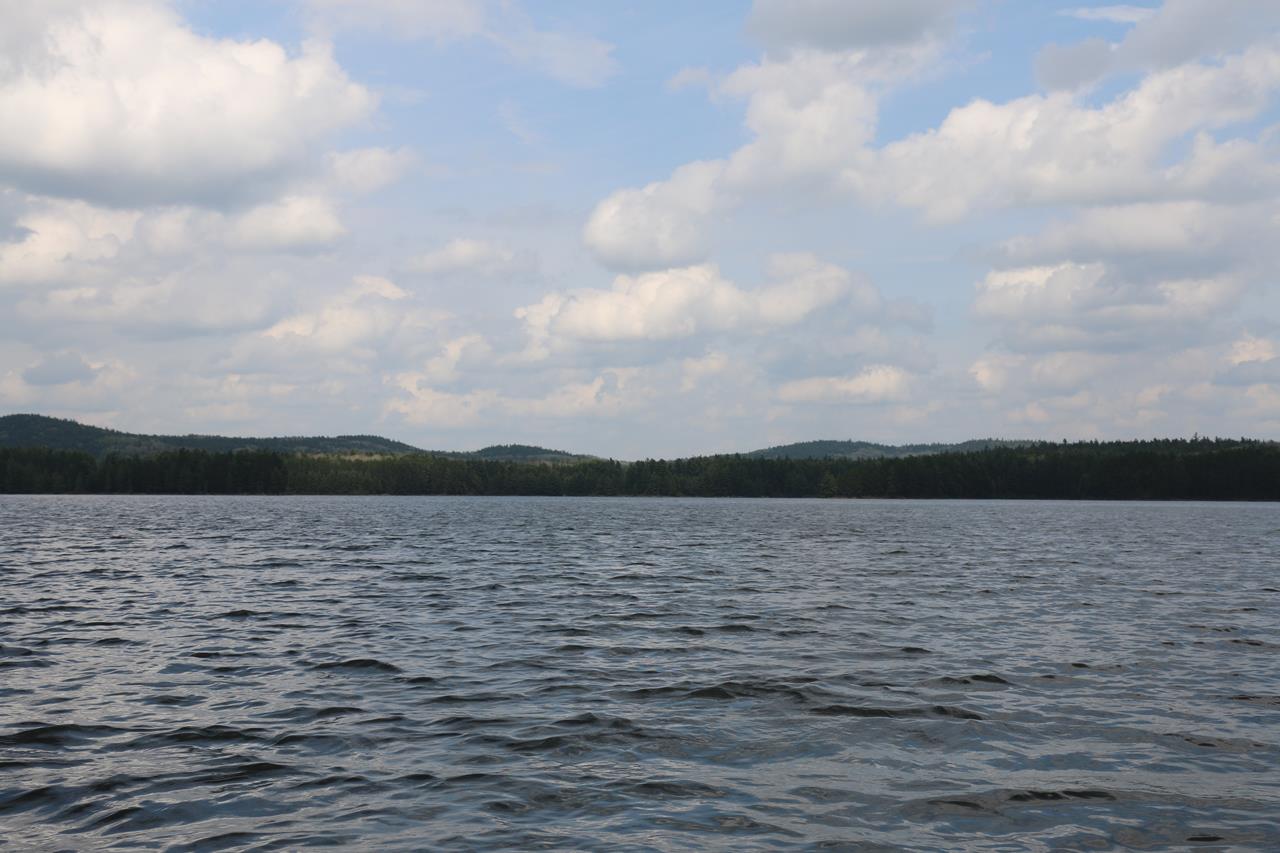 |
| Beautiful hills surround Barron Lake. |
 |
As we made it to the first campsite on the north shore, I looked below me and there were tons of boulders in the area Ė but we was probably 100 feet from shore. The water was deep, then shallow with rocks then deep and so on. I was reminded of one of Marc Rubino's trip-logs where he mentioned to stay away from this part of the lake in low water levels. Boy, he wasnít kidding. We slowly navigated to the campsite and I jumped out to snap a few photos and poke around. The campsite wasnít overly impressive, just a typical low maintenance site. The view of the lake was nice as the site is situated on a mini point, so you have a near wrap-around view.
Back in the boat, we continued on to the furthest campsite. Angela wasnít overly keen on paddling in the wind, and there were some dark clouds overhead. I assured her that once we landed at the next site, we could take a lunch break and the rest of the trip would be with the wind. We paddled across to the campsite and once again it was nothing impressive. We opted to keep going instead of having lunch there. Our lunch plan was a dehydrated meal and I brought the stove, so it didnít really matter where we stopped.
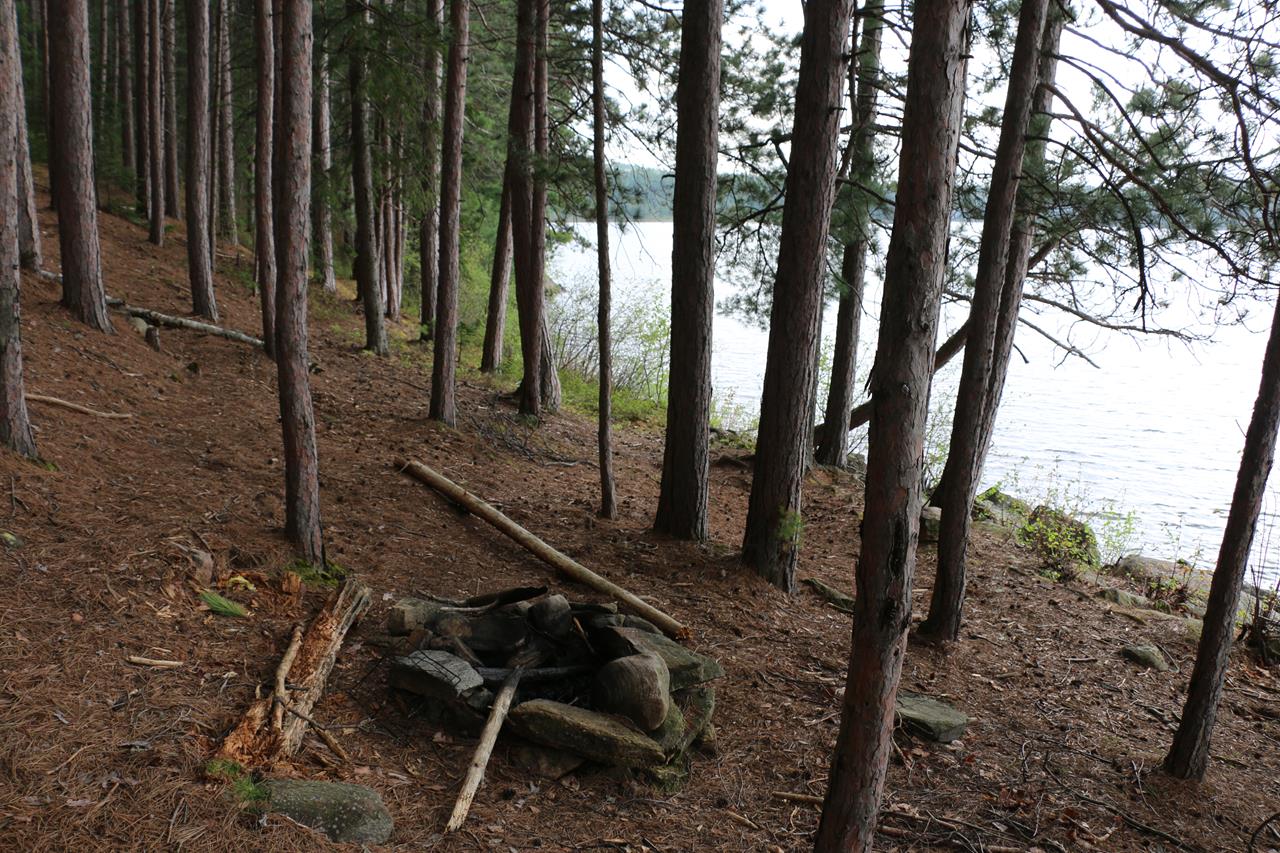 |
| Unmarked and probably closed campsite on Barron Lake. |
 |
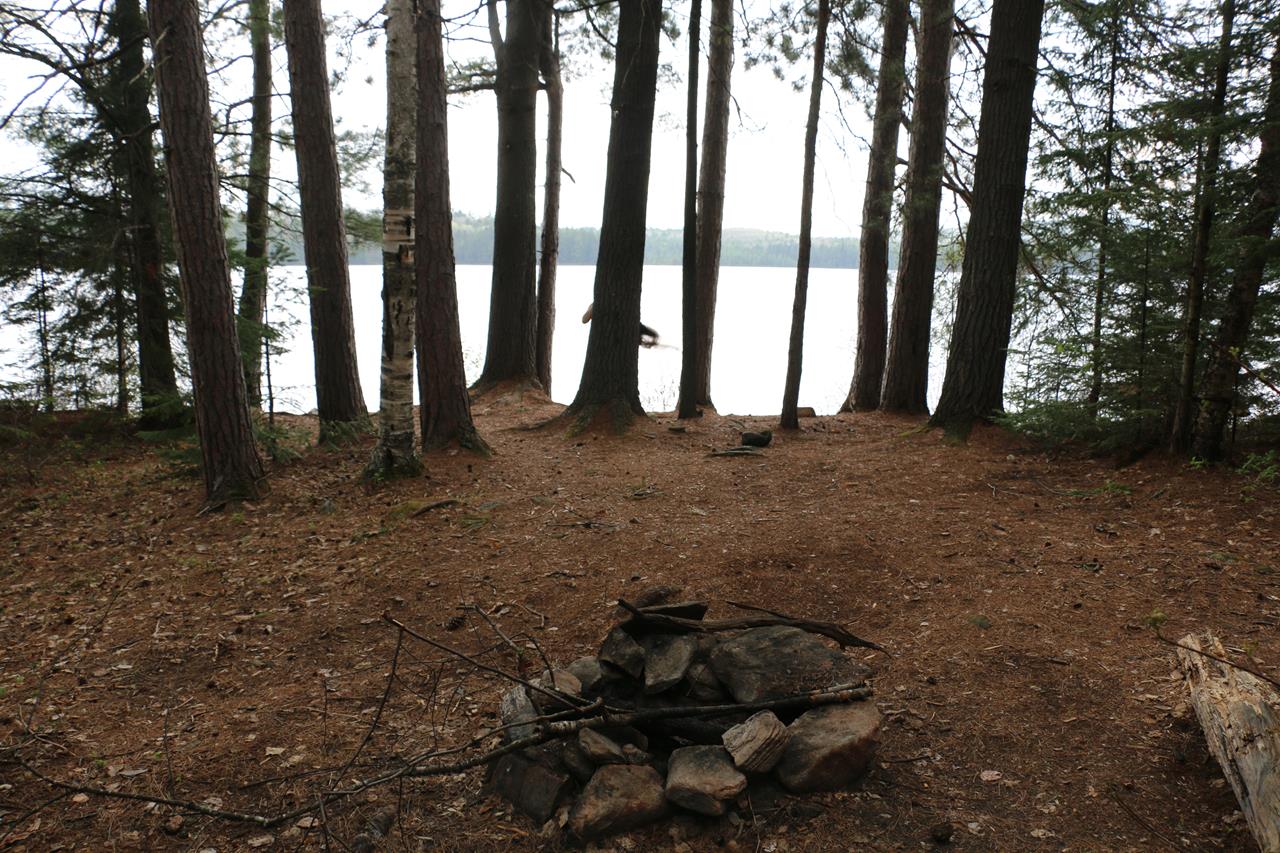 |
| Campsite with big rock out from on Barron Lake. |
 |
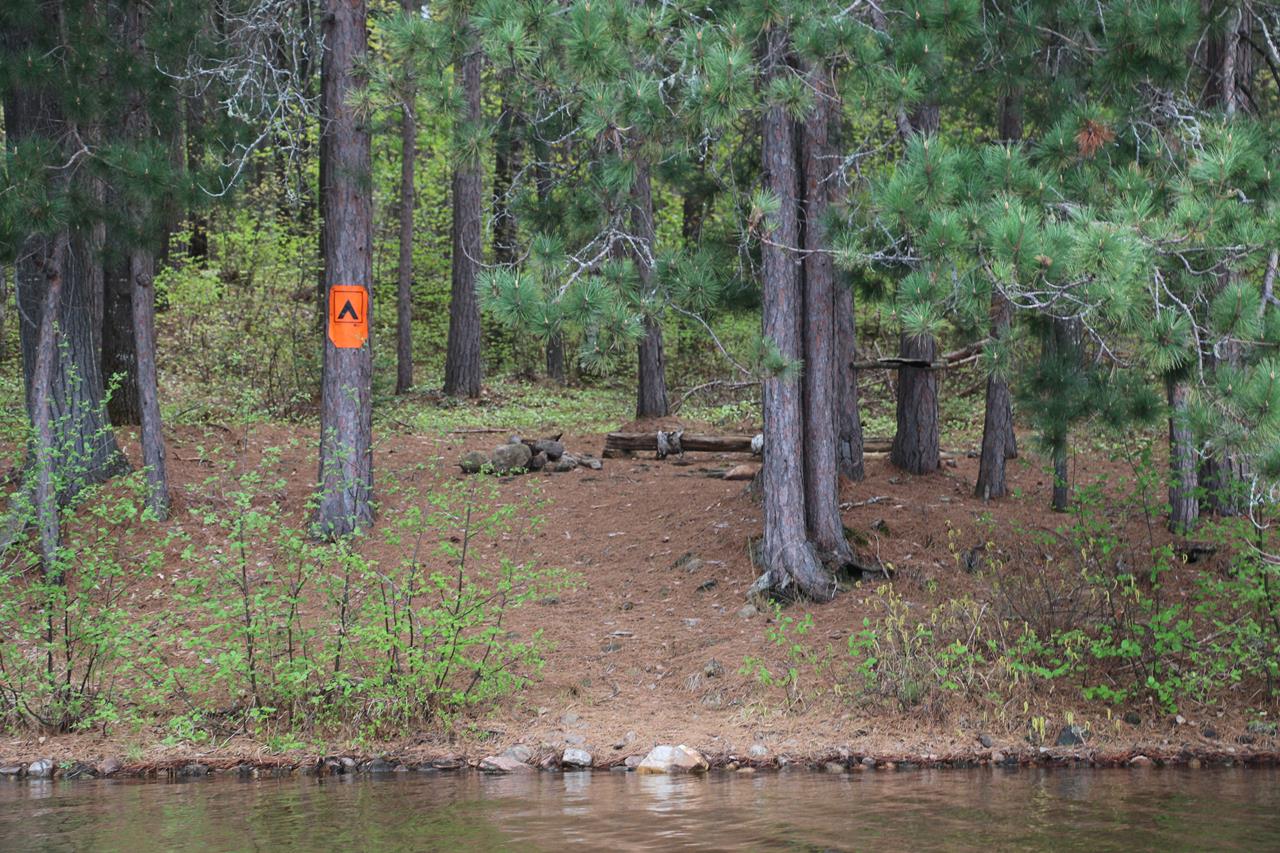 |
| Small & secluded campsite on Barron Lake near the portage to the hydro field. |
 |
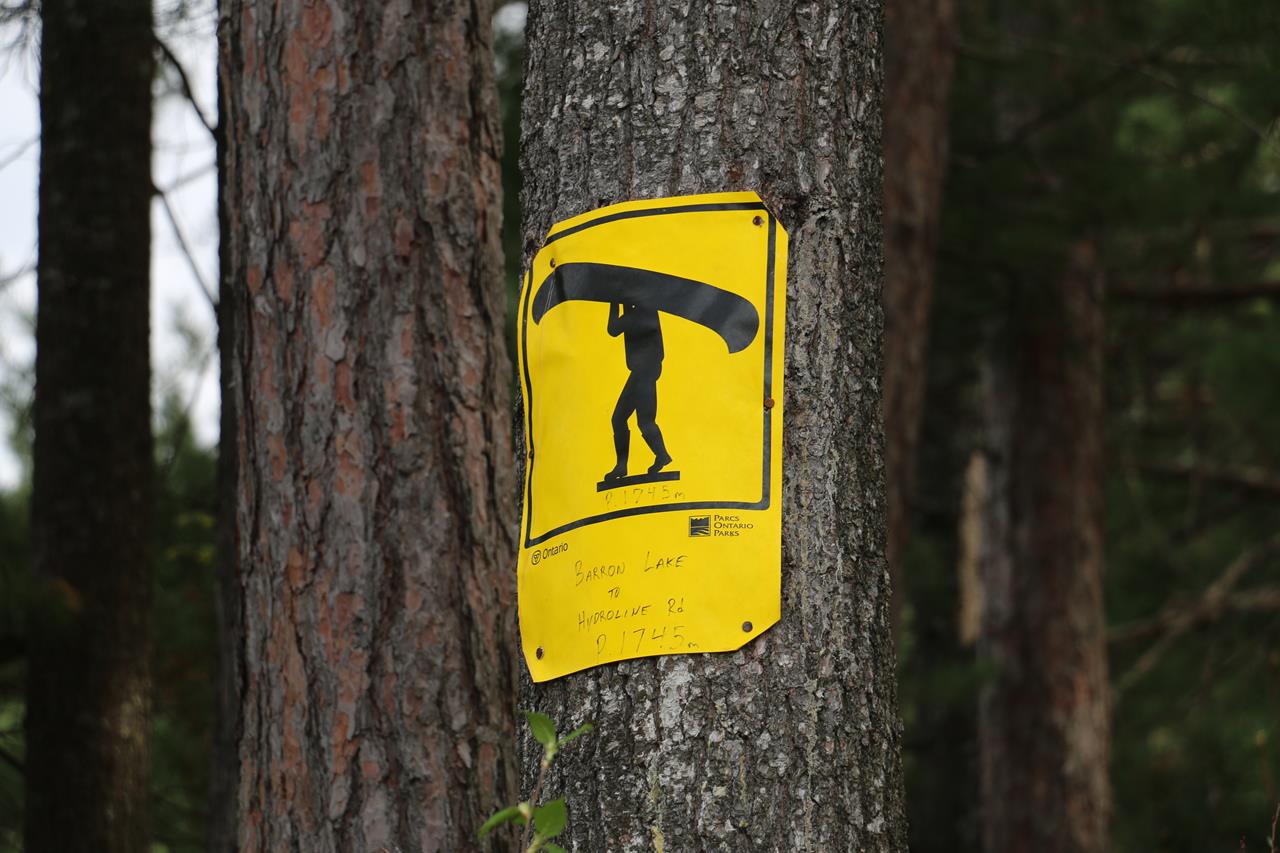 |
| Portage to the hydro field. |
 |
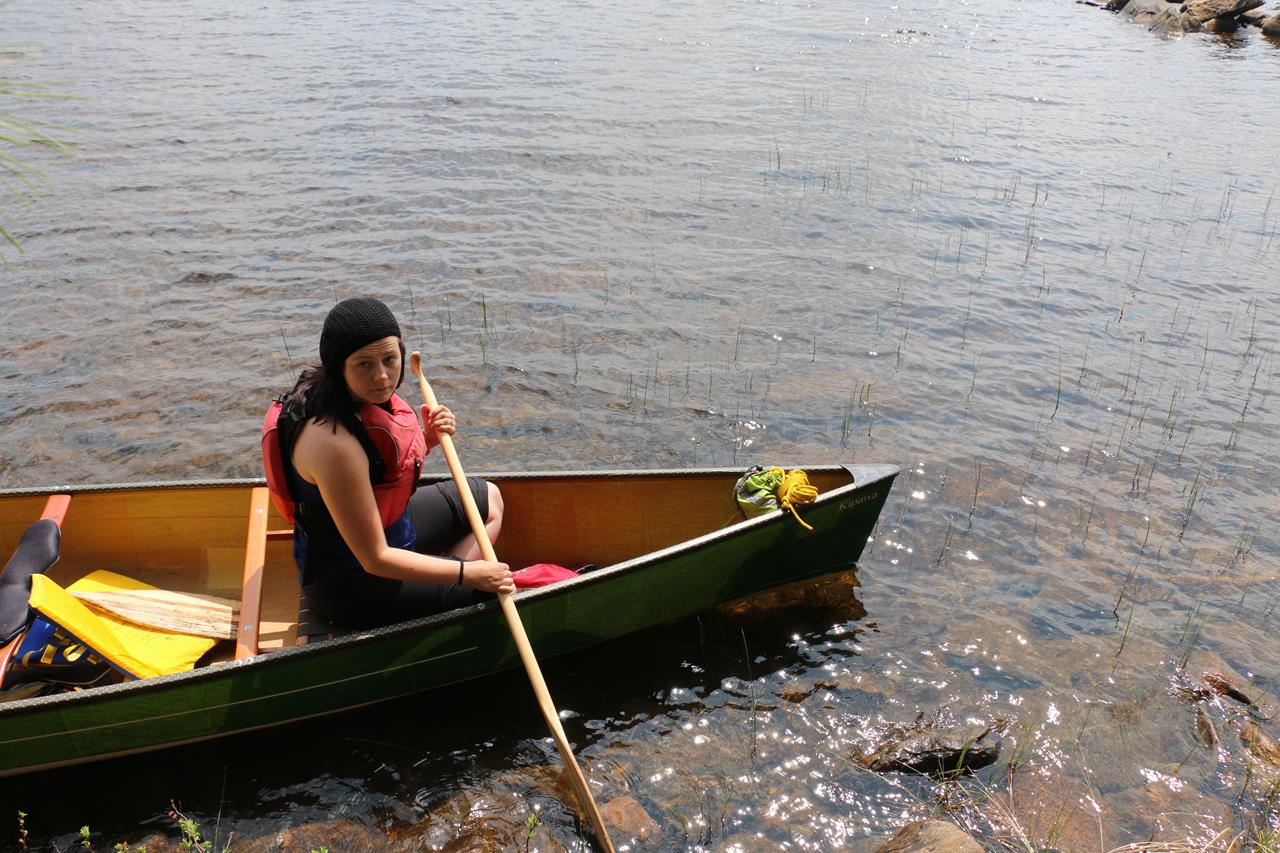 |
| Angela waited in the canoe while I checked out each campsite. |
 |
I must say, Barron Lake is very beautiful. However, our visit was somewhat tarnished by the bugs. Oddly, they seemed to be much worse there than on Greenleaf. Each time we checked out a campsite, it wouldnít be long before we had to jump back in the boat and move on to avoid the bugs. While paddling to the middle of the lake to lose the bugs, I quickly boiled some water and tossed it in the dehydrated meal bag to let it cook while we crossed the lake to visit the final campsite. As we approached the eastern-most campsite on the point we could see that this was definitely the one you would want to stay at. A large point of land covered in red pine, but also sparse in some areas which would allow a nice bug-moving breeze. While at the site, we ate our lunch of pasta primavera and decided to head back to Greenleaf.
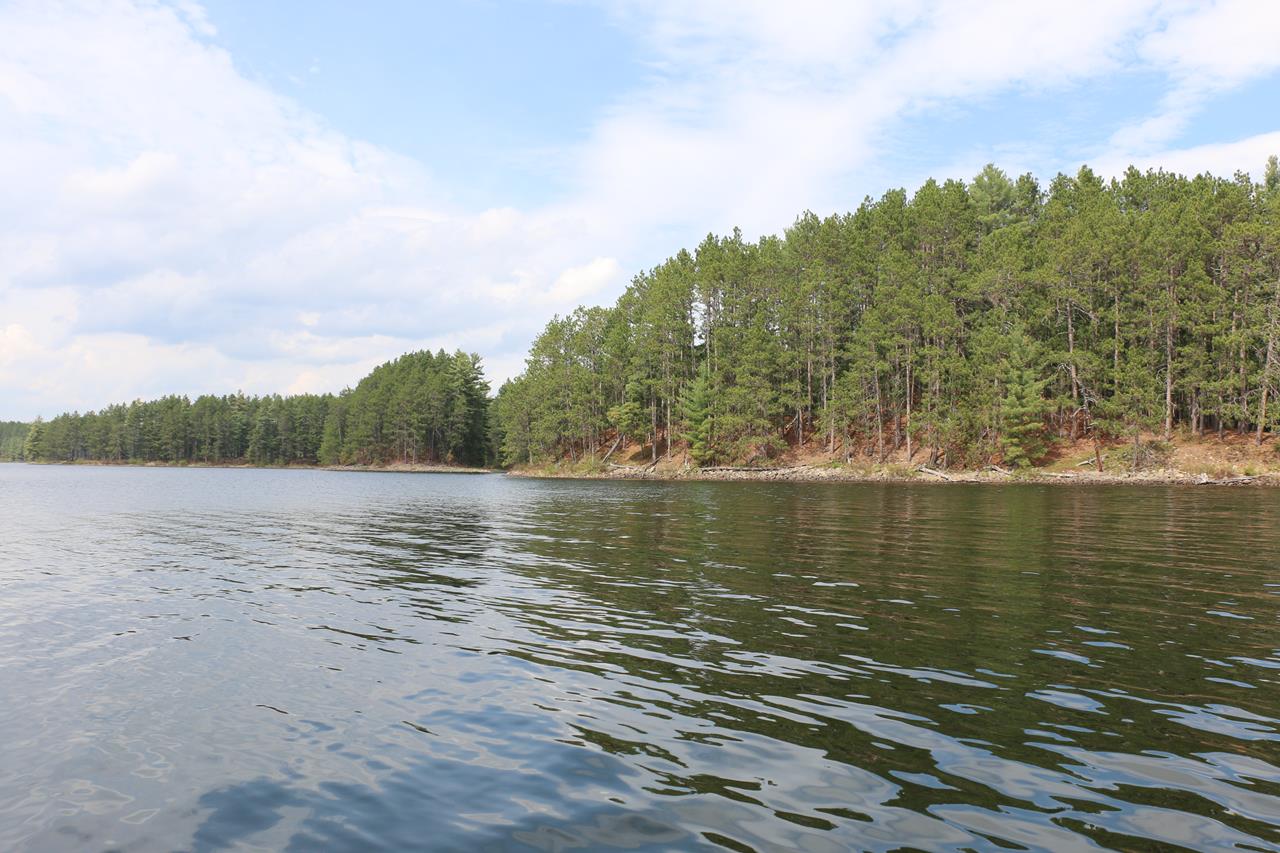 |
| Beautiful Barron Lake. |
 |
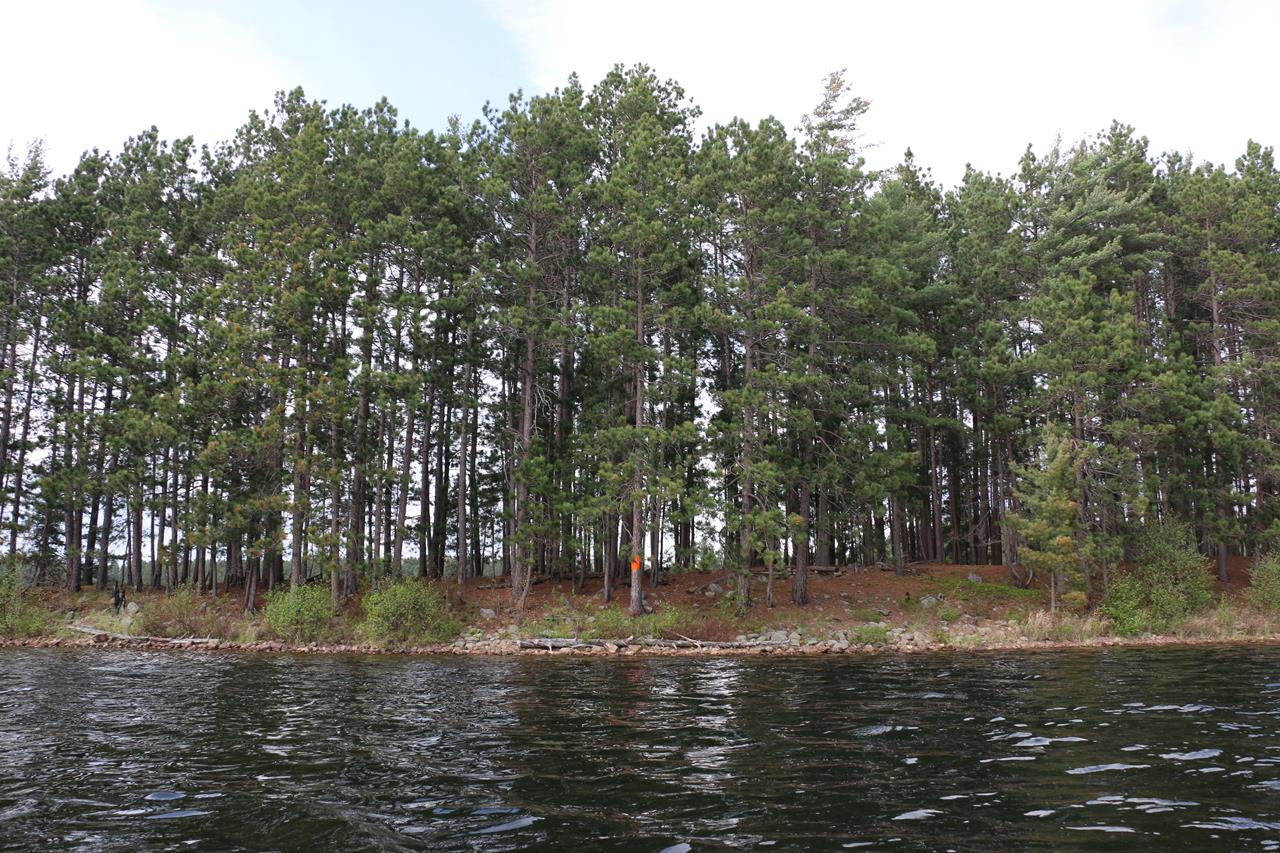 |
| The best campsite on the lake. |
 |
It was getting late in the afternoon and we were both a little tired. It wasnít long before we landed at the portage and we crossed it about 5 minutes quicker than we did the first time around. I attribute this to the downhill grade. I should mention that at the time of writing this report, both the trailhead and trail alignment are not true to Jeffís Map (v5) and the trail is closer to 1800m in length. We arrived at the landing and carefully launched the canoe onto Greenleaf.
Once we got into the main channel of the lake, we were hit with a very strong headwind. It was being funneled down the lake and we had to paddle fairly hard just to maintain some speed. It took about 15 minutes to get back to camp and when we did, Angela went straight for the tent. Though I was tired, it was the last evening of the trip and I didnít want to miss anything by taking a nap. I relaxed in my chair for a while and the black flies kept me company.
Up to this morning there had been little to no mosquitos. But today they really came out. I didnít do much, and before I knew it a couple hours had passed. I decided to wake up Angela for dinner time. I whipped up two loaves of bannock, which took nearly an hour as I only have one stove. Next I heated the chili and moments later we had fresh hot bread to dip in our steaming spiced chili. I absolutely love chili and fresh bannock while camping, and so does Angela! After dinner, we relaxed around the fire and pretty much called it a night. We were in the tent and in bed by 10pm and I couldnít have been happier to lay on that air mattress Ė I was pooped!
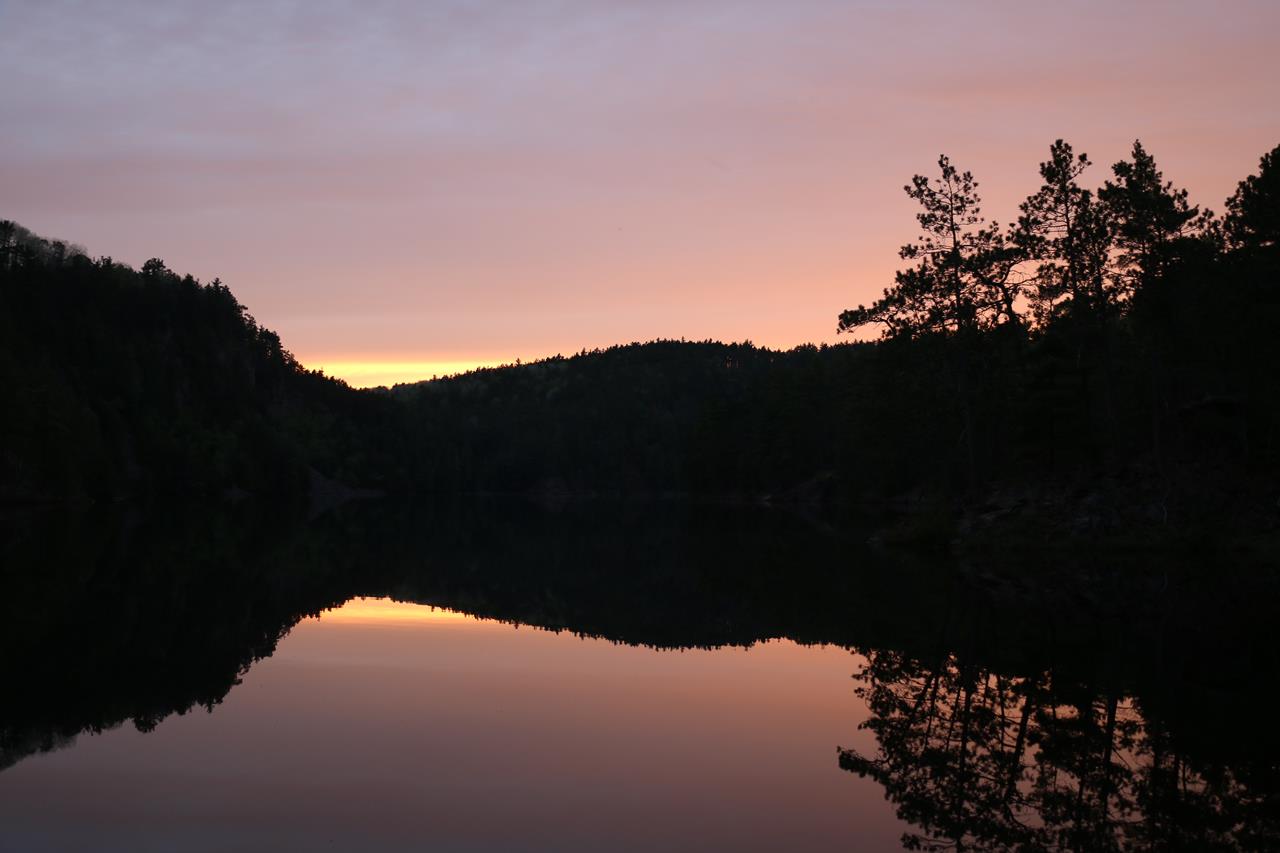 |
| Beautiful view looking up Greenleaf Lake. |
 |
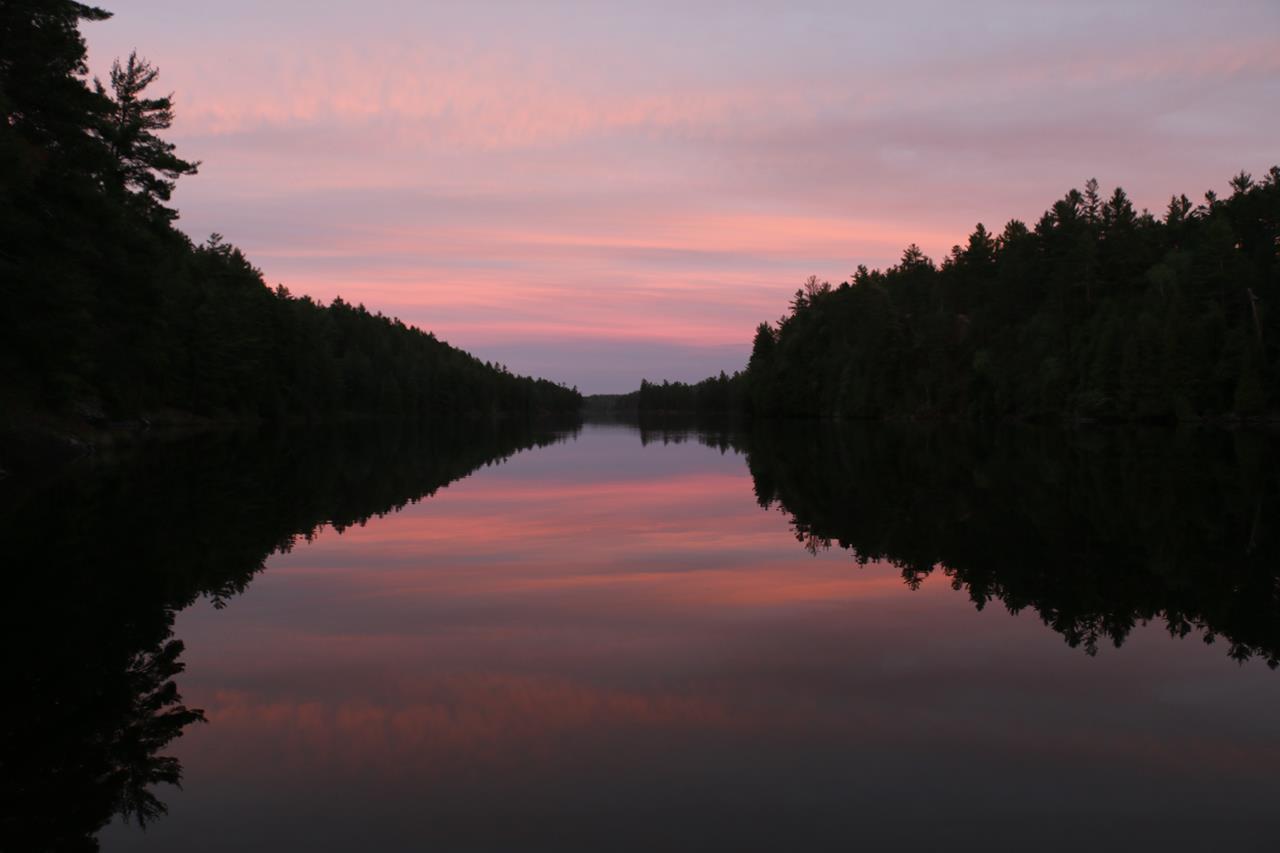 |
| Beautiful view looking down Greenleaf Lake. |
 |
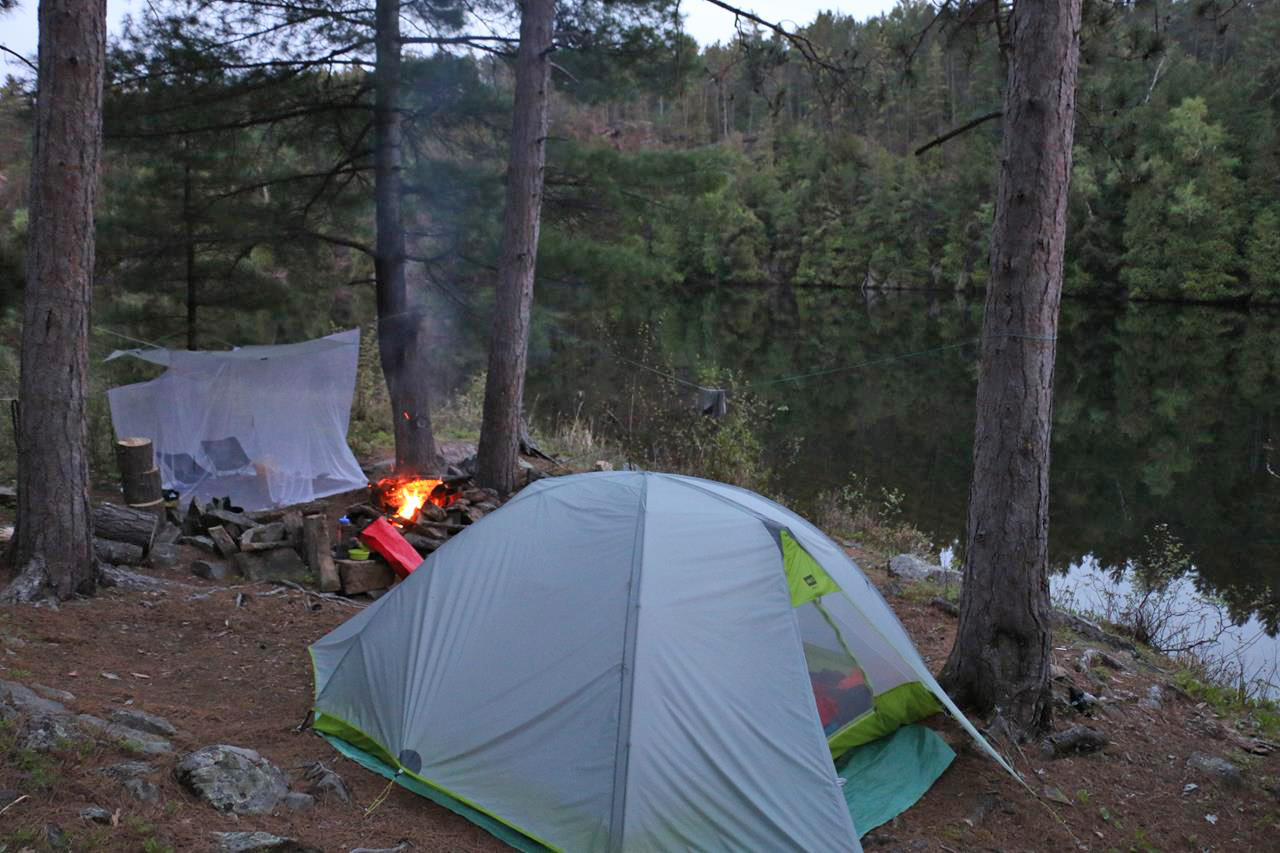 |
| Evening at camp on Greenleaf. |
 |
Day 5 Ė Tuesday May 19th, 2015: Greenleaf Ė Grand
Having woken up a little earlier than usual because it was very windy, I was out of the tent by 6:30am. I couldnít help but notice the wind, though earlier than usual, was headed in our direction. It was sunny with only a few clouds. After putting the water on for coffee, I began to dismantle to tarp and get all the minor things in order and ready for packing. I sat in the bug shelter enjoying a coffee while looking at the map and thinking about the trip. I was sad to be leaving, but I was thankful for the cooperative and favorable weather we'd had.
About an hour after me, Angela woke up and headed straight for the bug shelter. The bugs were bad today, even with the wind. For that reason I was ready to leave. We made a quick breakfast of oatmeal and coffee then began the process of packing up. While I took down the bug shelter, Angela took care of the interior of the tent. It wasnít long before we had everything packed up and ready to go.
By 9:30am we hit the water and by this time the winds really picked up. We had a fairly easy paddle for 2km down Greenleaf Lake. As we approached the log jammed take out to the portage, I realized we have a small problem on our hands. We were now at the end of the lake where the wind was blowing hardest. The waves were at a point where you really needed to stay in control. There were sunken logs jammed up to the little dock at the portage landing and the waves were slamming directly into them. So for us to come in parallel to the dock, we would be continuously smashed by the waves. Unfortunately due to the shoreline's topography and plants in the immediate area, there was no other way to take out.
So I waited for a lull in the wind and waves and made a break for it. We were still hammered sideways from the waves and got a bit wet. I jumped out onto one of the logs to guide the canoe next to the dock. Angela quickly jumped out and we rushed to get the packs out before everything was soaked. I was disappointed at having to get my feet wet before a 5.5 km portage, as the trail is pretty long and itís less than ideal to have wet feet for it. We were happy the wind kept blowing, as it kept the bugs at bay and we figured it would also help us as we paddled down Grand Lake. We loaded up and began down the trail.
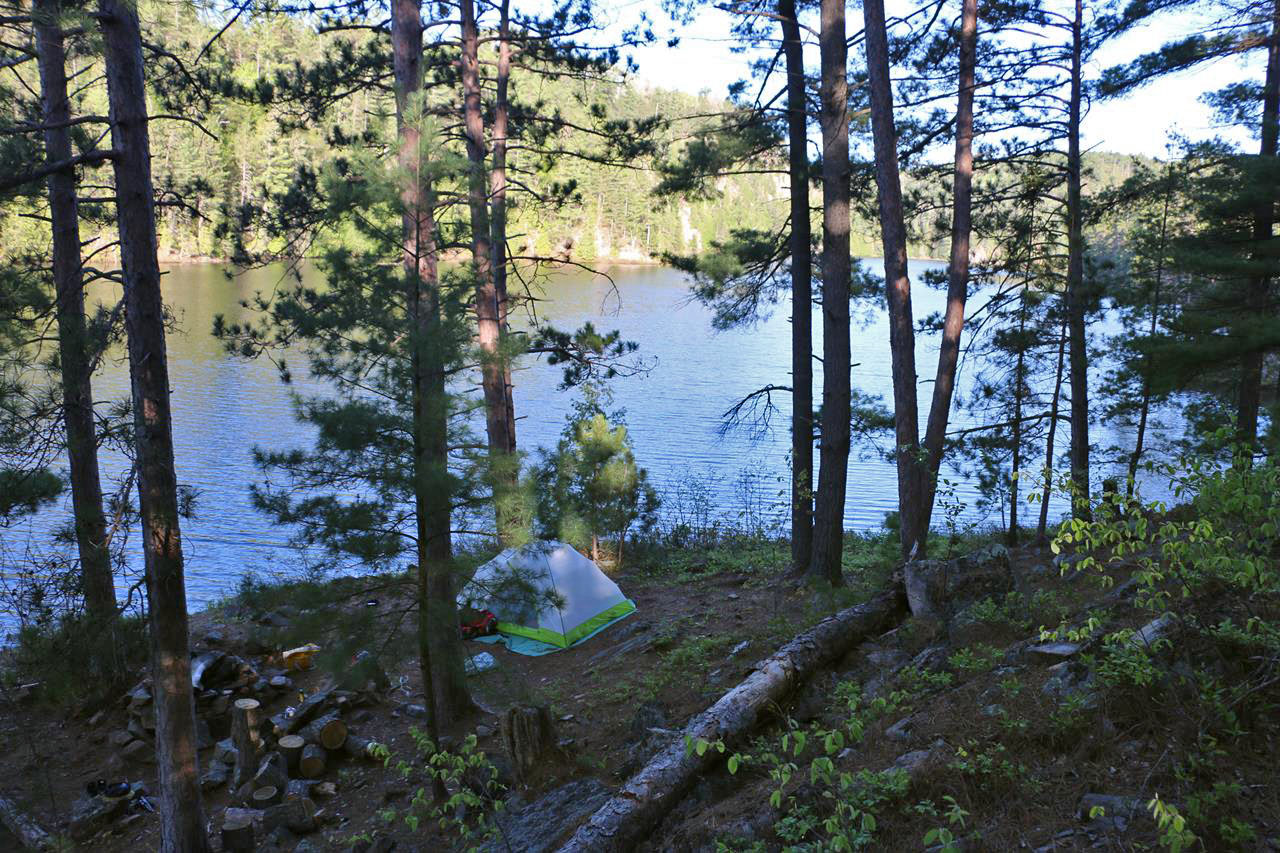 |
| Elevated view of the campsite on Greenleaf Lake. |
 |
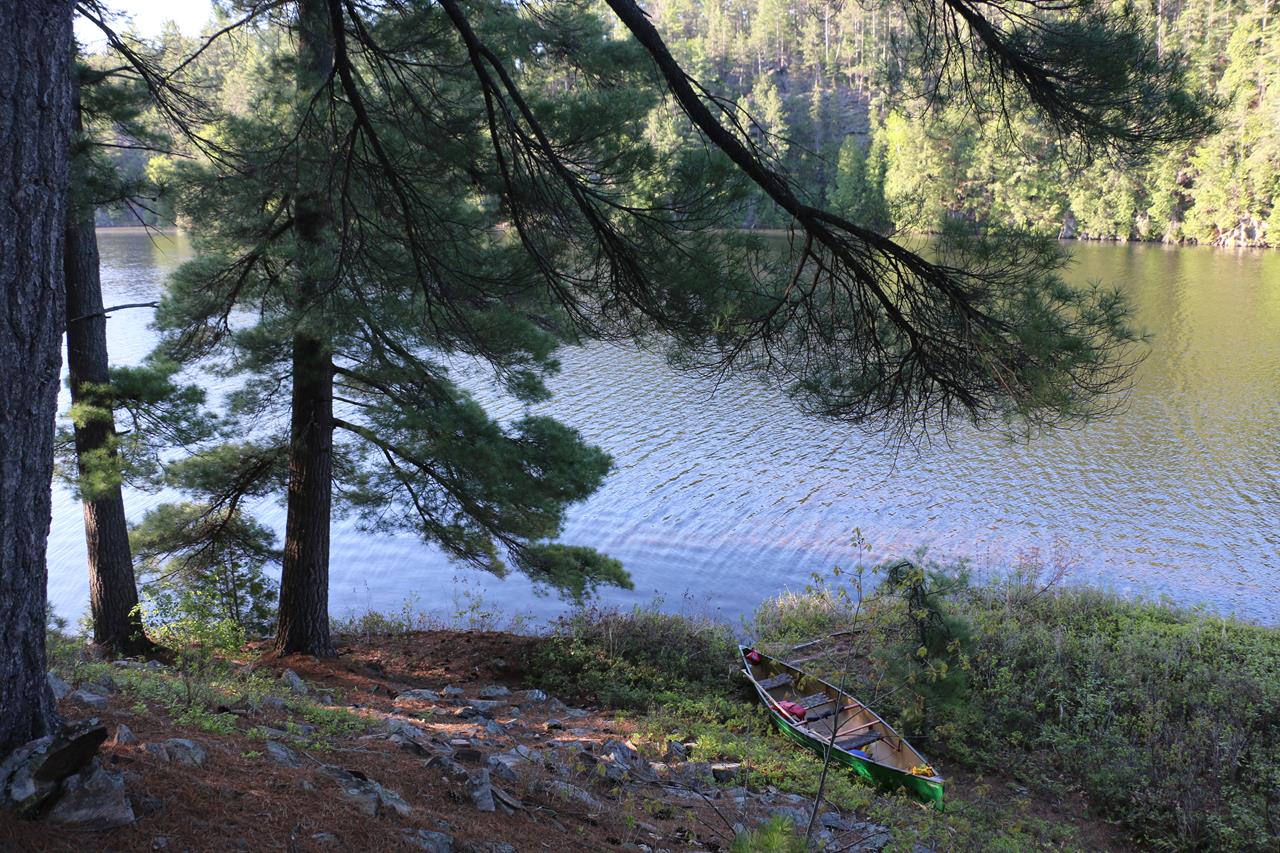 |
| Sad to be leaving this beautiful place today. |
 |
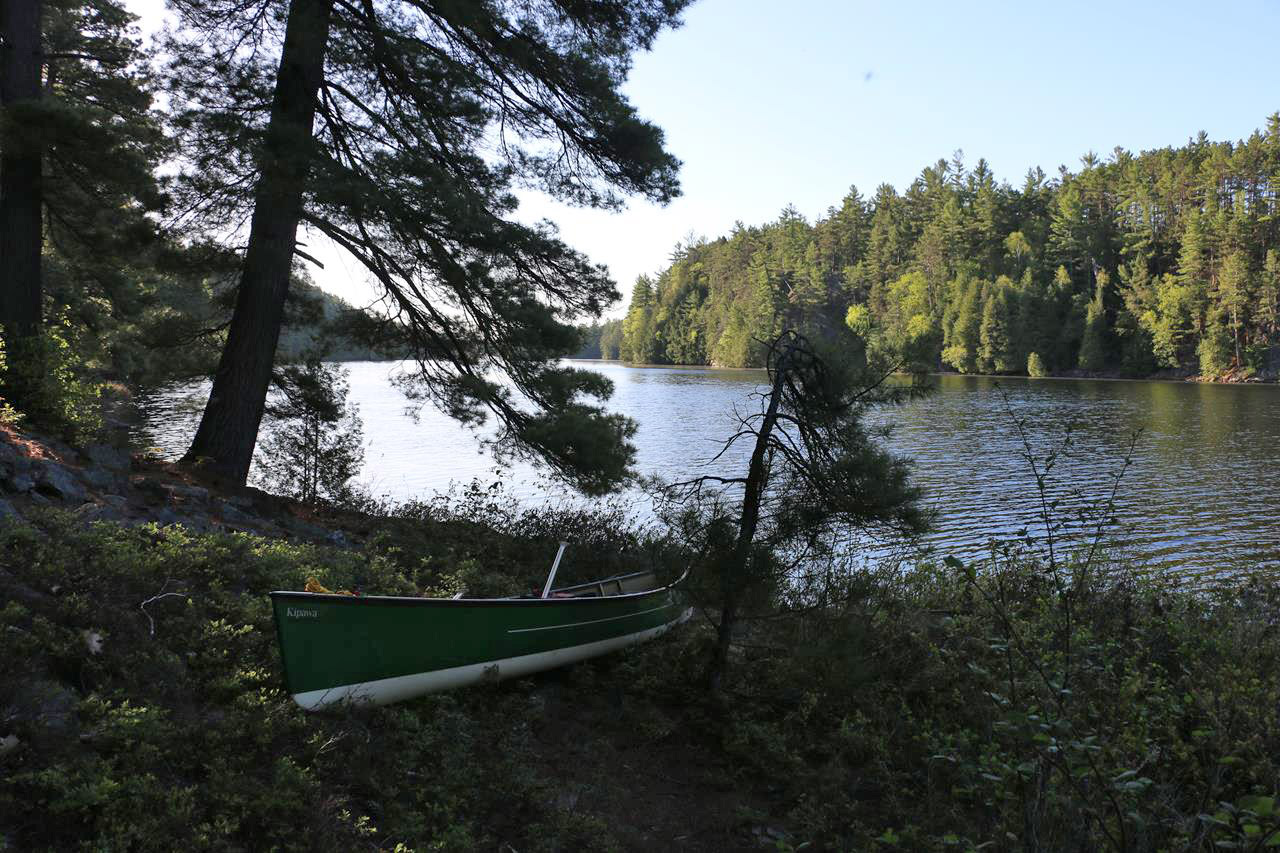 |
| I love my Kipawa! |
 |
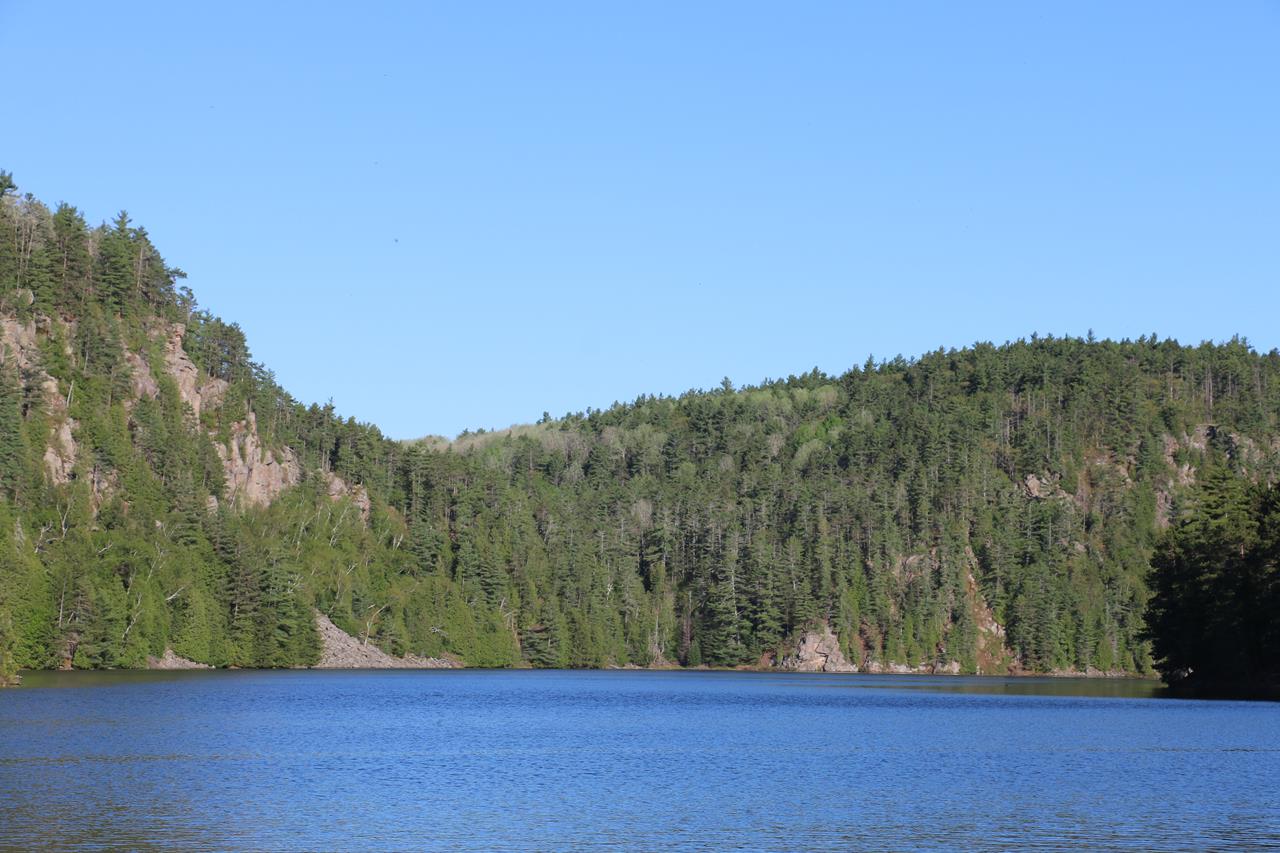 |
| One final look up Greenleaf Lake. |
 |
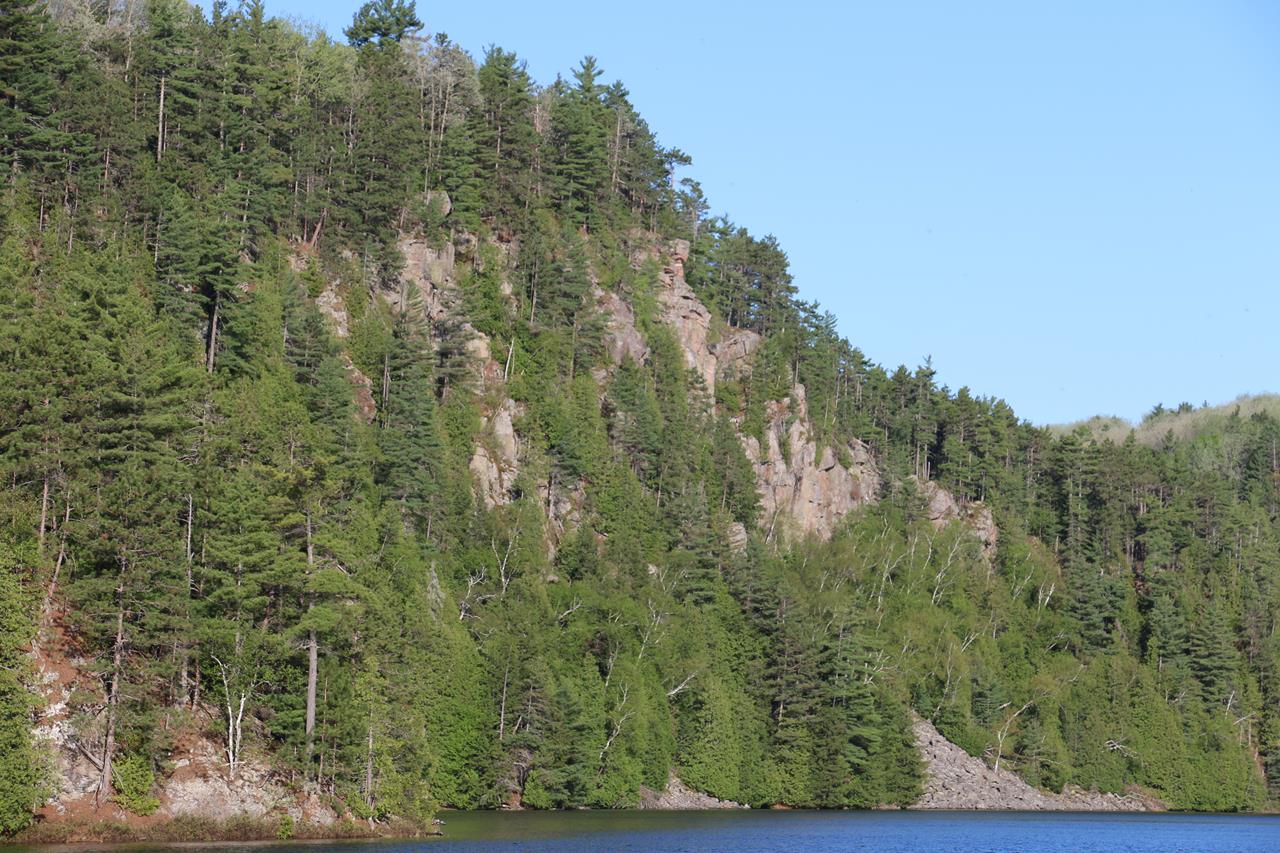 |
| Greenleaf cliffs on the west shore. |
 |
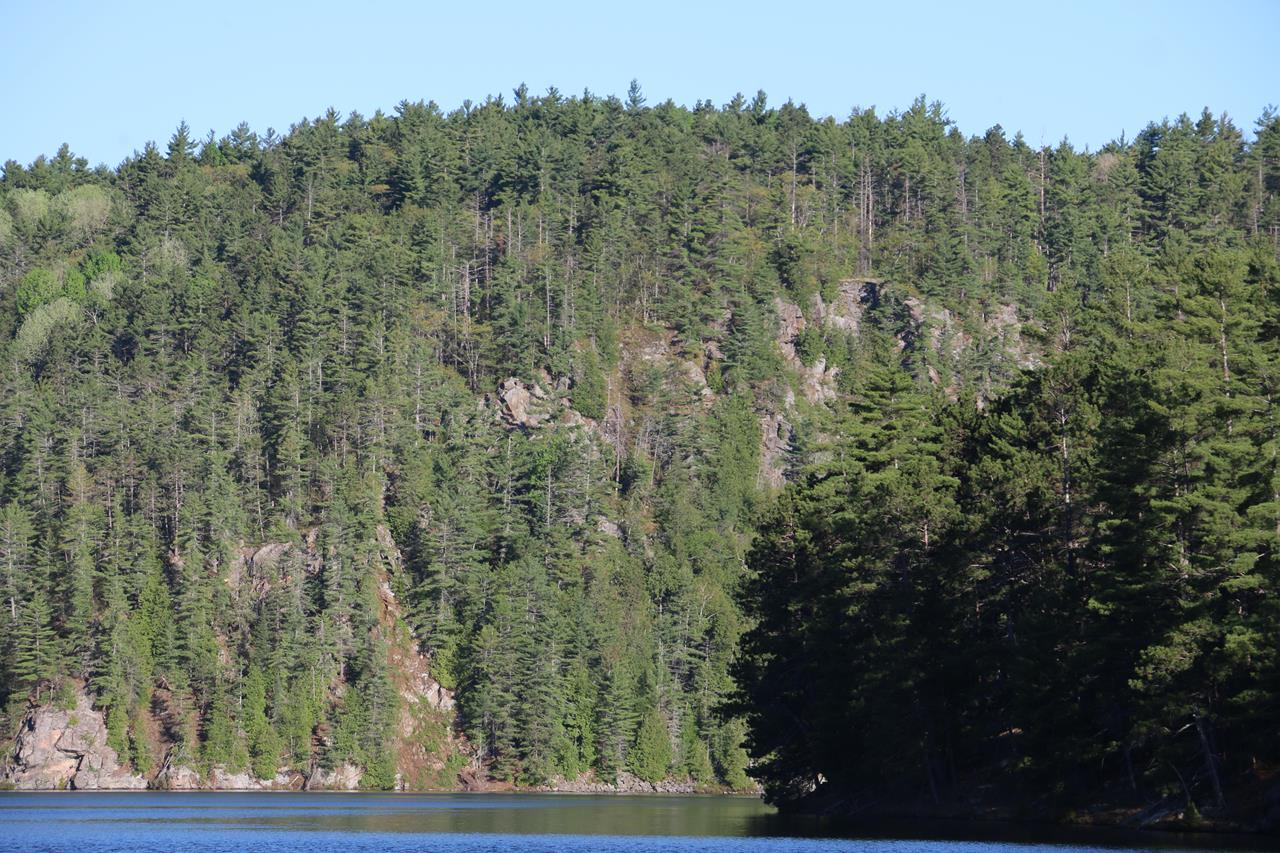 |
| Greenleaf cliffs on the north shore. |
 |
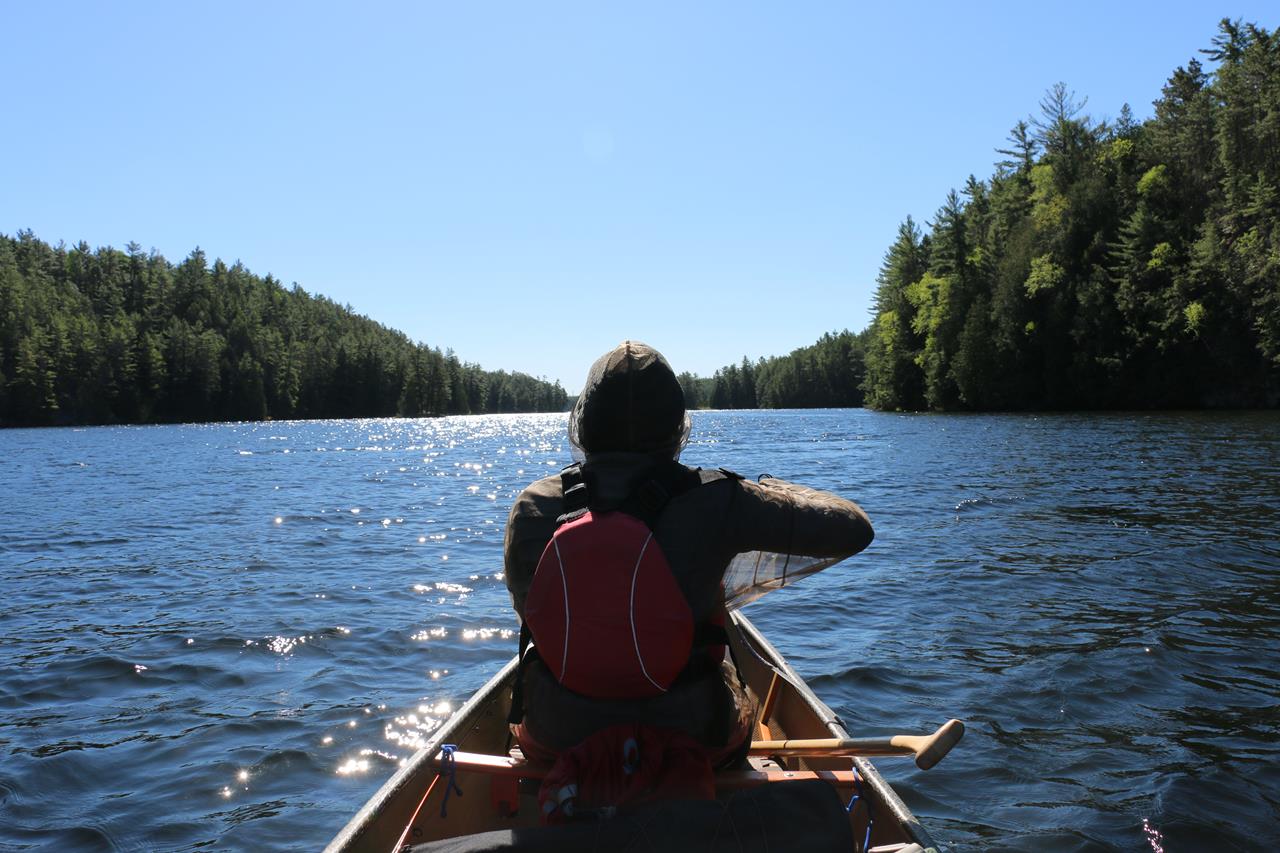 |
| Headed down Greenleaf Lake. |
 |
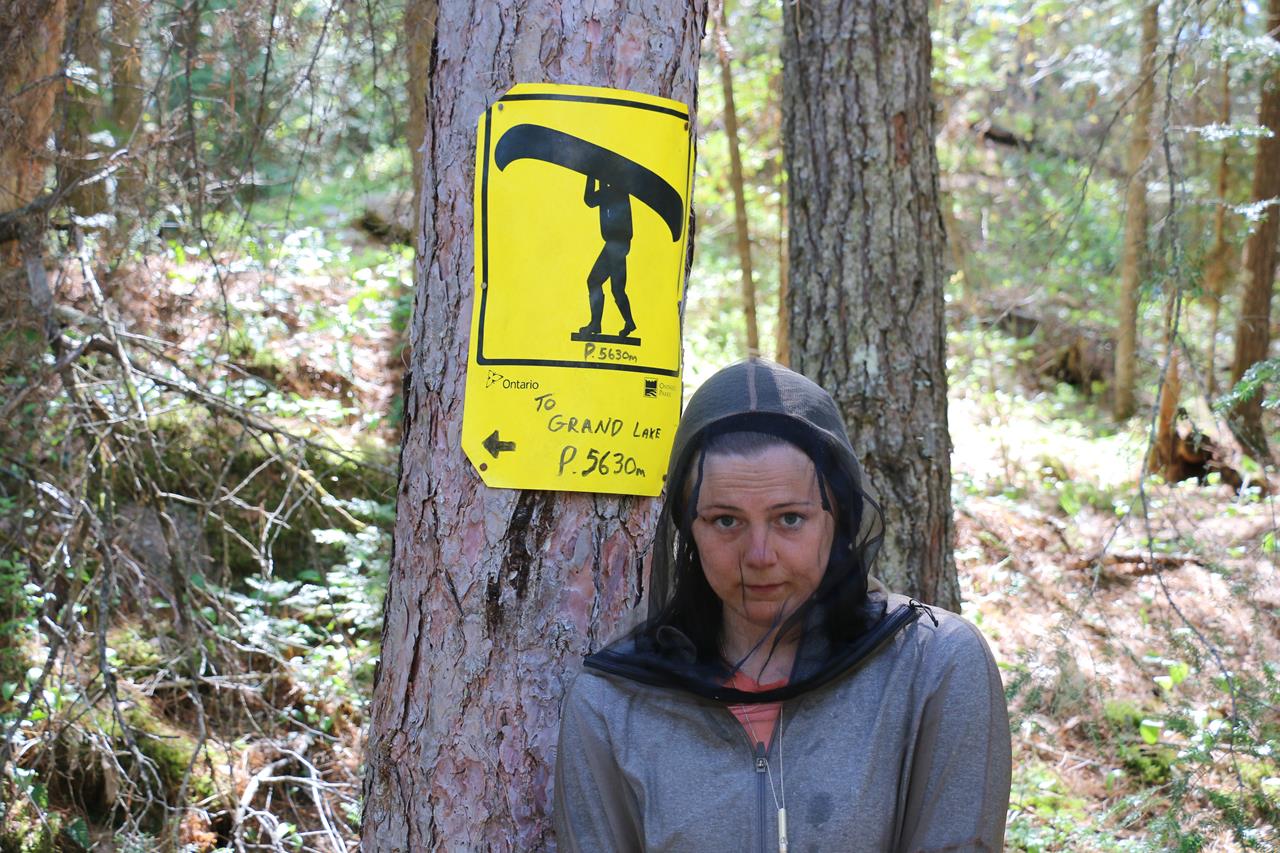 |
| Ready for the big one Ė 5600m from Greenleaf to Grand. |
 |
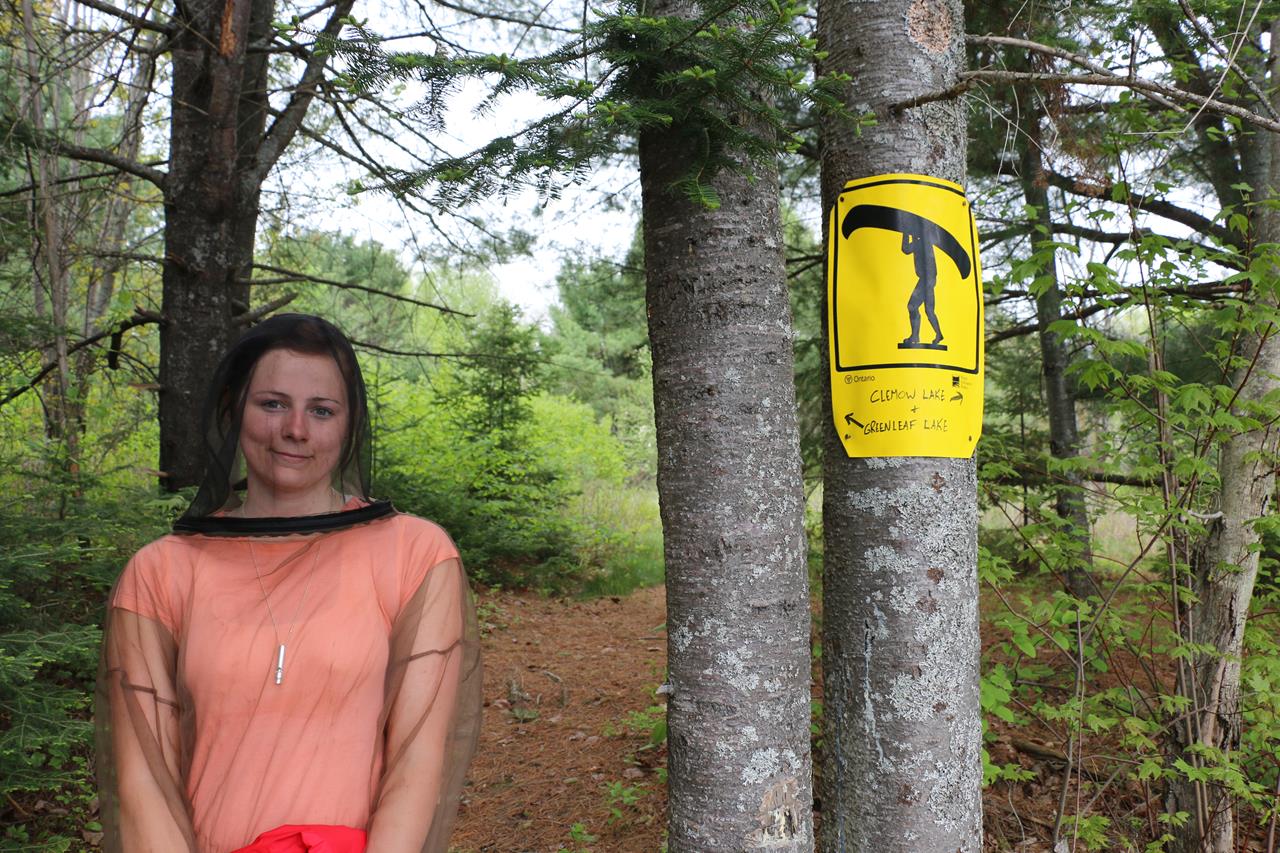 |
| A little over two hour later and we were on the other side. |
 |
I couldnít help but notice the scars on rocks along the portage, left behind by snowmobiles accessing this lake in the winter. I have witnessed these scars on rock in other areas of Algonquin too. We took a break at the portage intersection and we didnít stay long Ė the bugs were really bad here. I ate a few meat sticks and Angela had a granola bar, then we moved quickly. While headed up the trail I recounted my trip across this same portage back in 2012 when it was completely devastated by blow-downs. As we walked the trail Angela took note of all the cut stumps that would have otherwise blocked our path.
After crossing the hydro field, the trail begins a very steep incline and that doesn't stop for about 1km. The trail is along a hydro maintenance road (a very rough road) so itís easy to follow, but it is just insanely steep. The overall height gain from Greenleaf to the top is nearly 450 ft! We had to take breaks every 300 meters or less, as it was just too much. As we were getting closer to the top of the ridge, the winds picked up and allowed us to rest with a bit more ease due to the lack of bugs. Eventually, we reached the peak of the portage and when it flattened out we were able to cover much more distance.
According to the GPS, we did three sets of 1 km runs for the rest of the trail. When the trail began its decline, we found it was not as bad as we had anticipated. This was my 3rd time crossing this portage. Angela thought I was crazy for doing it more than once. I told her this portage was likely the reason we were able to catch trout in Greenleaf Lake. So Iíll take it any day. Two hours and ten minutes after we started on Greenleaf Lake, we arrived on Grand Lake. Just as I had suspected and one of the reasons I planned the loop in the direction, the winds on Grand Lake were blowing hard in the direction we were headed! I told Angela this was awesome because we wouldnít have to work as hard and we could probably make the 11km paddle back to the car in about 90 minutes.
We launched onto Grand Lake around 12:20pm and started our long journey. The skies were overcast but it didn't look like it would rain. The paddle was uneventful but I enjoyed it like I would any other lake. There was no one around. No campsites we passed were occupied. Nor did we see any boats on the lake. By 1:30pm we were at the railway bridge that divides the lake. Not bad! We took a short break after going under the bridge. The railway embankment across the lake provided a wind block and a chance to have a snack.
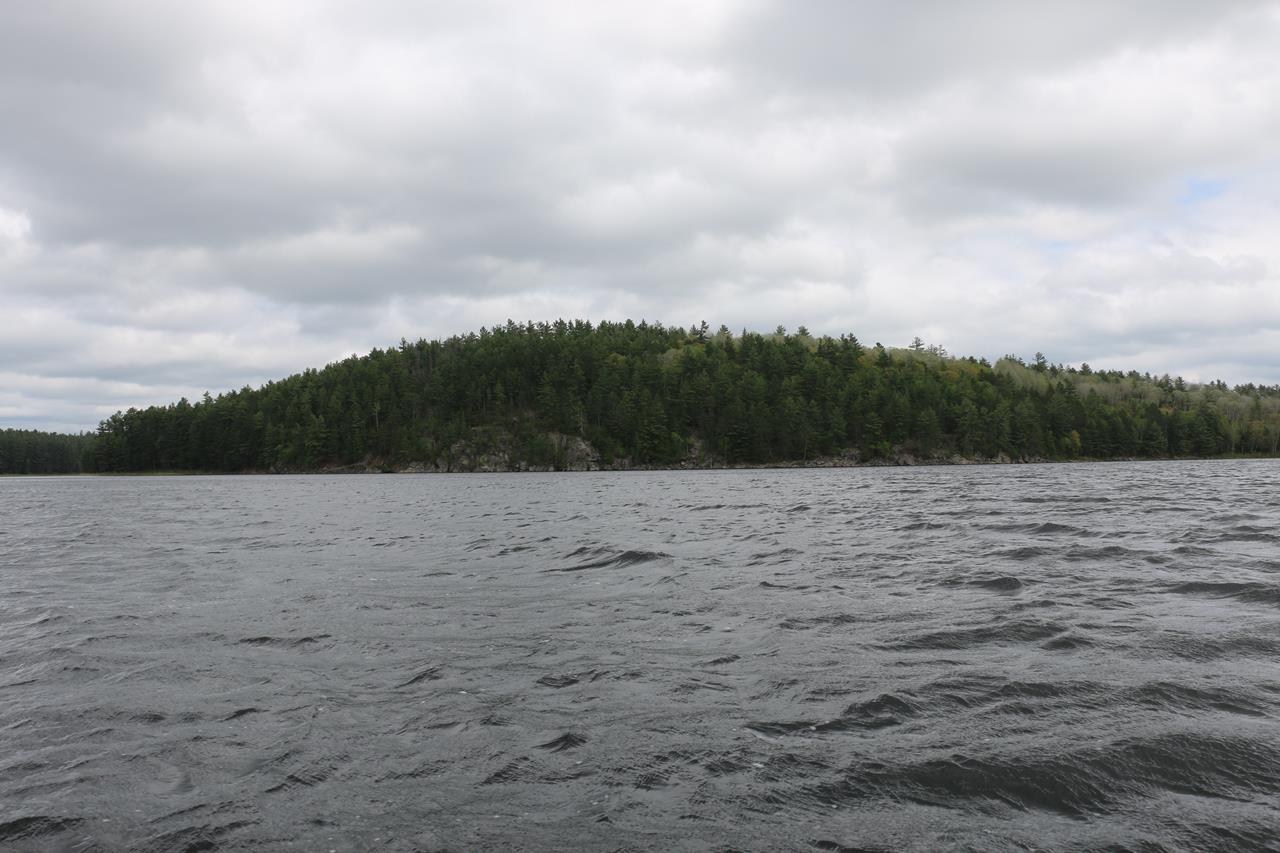 |
| A choppy & overcast Grand Lake. |
 |
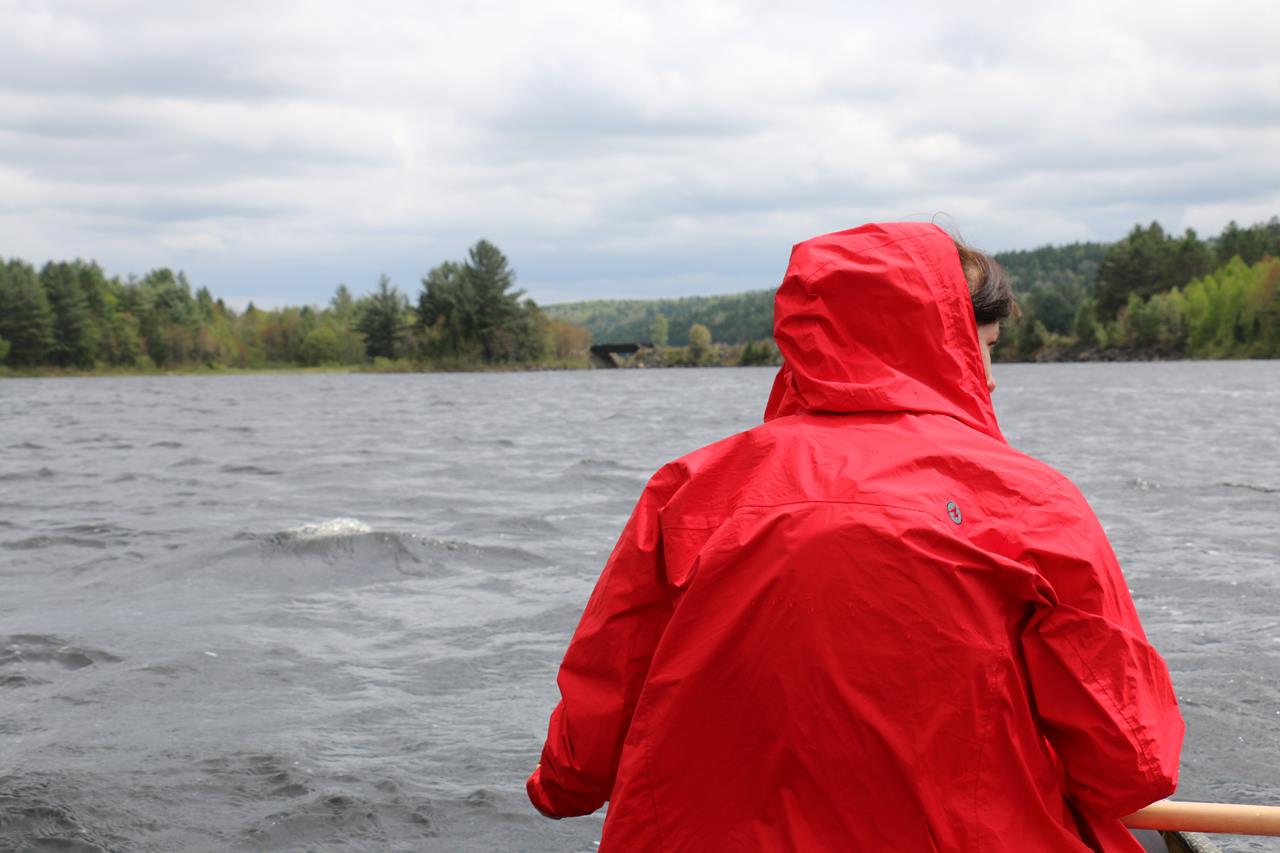 |
| Headed down Grand Lake. |
 |
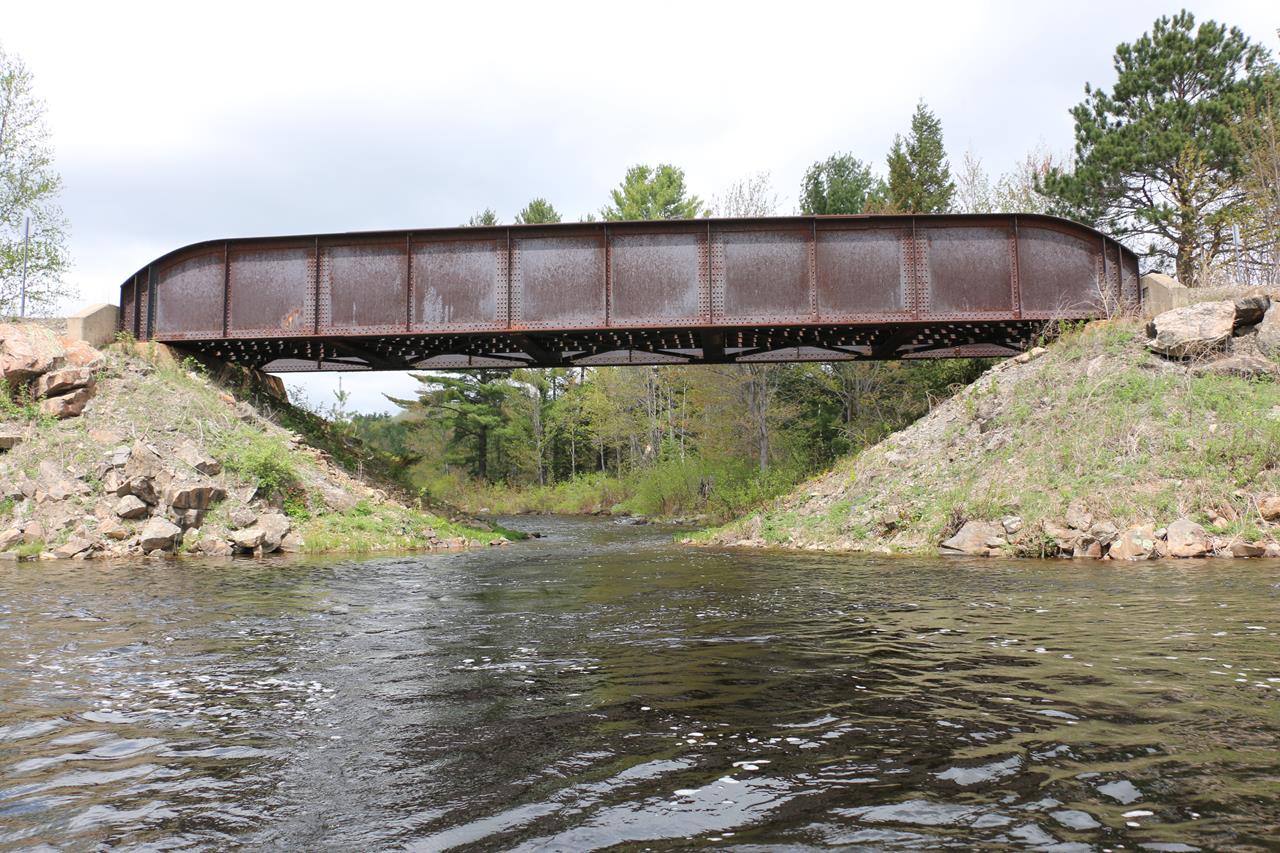 |
| The railway embankment provided a wind-break for a quick snack. |
 |
As we continued down the lake the wind became even stronger. Angela was a bit nervous, but I told her not to worry. I had control in the stern and if it became too much, I would pull over. We flew down the lake and landed at Achray just before 2:00pm. Not bad! 11km in one hour and forty minutes. I told Angela that if the wind had been blowing in the other direction, we would have had a real problem! Luck was on our side, and in this case it paid off to go up Carcajou Creek and down Grand Lake.
We unloaded the canoe, topped it on the car and made a quick stop at the Out-Side-In cabin and the Barron Canyon Trail. Overall I was really happy with this trip. The days werenít too demanding and I think Angela really did amazing for her first loop style trip. Sheís an amazing bow partner and I canít wait for our next trip together.
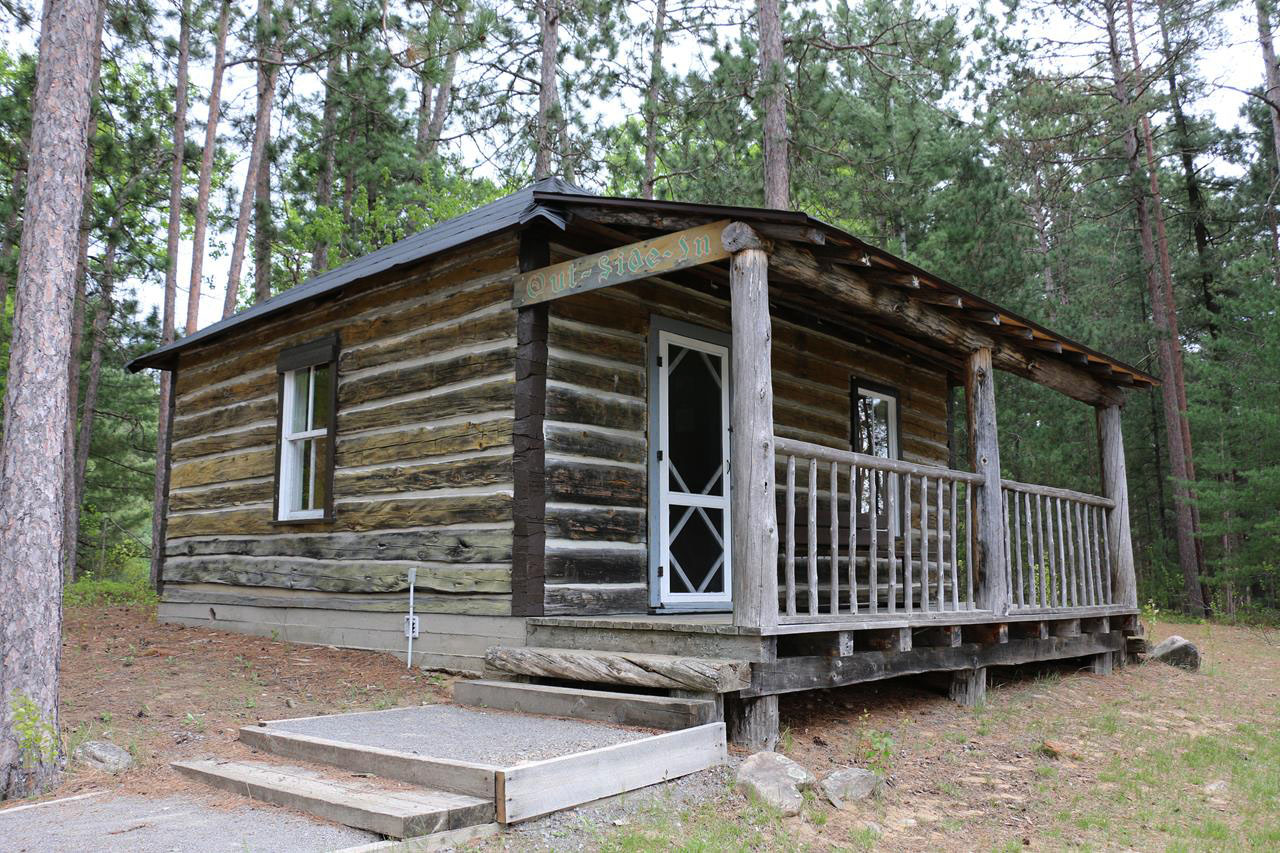 |
| Out-Side-In Ė Achray, Grand Lake. |
 |
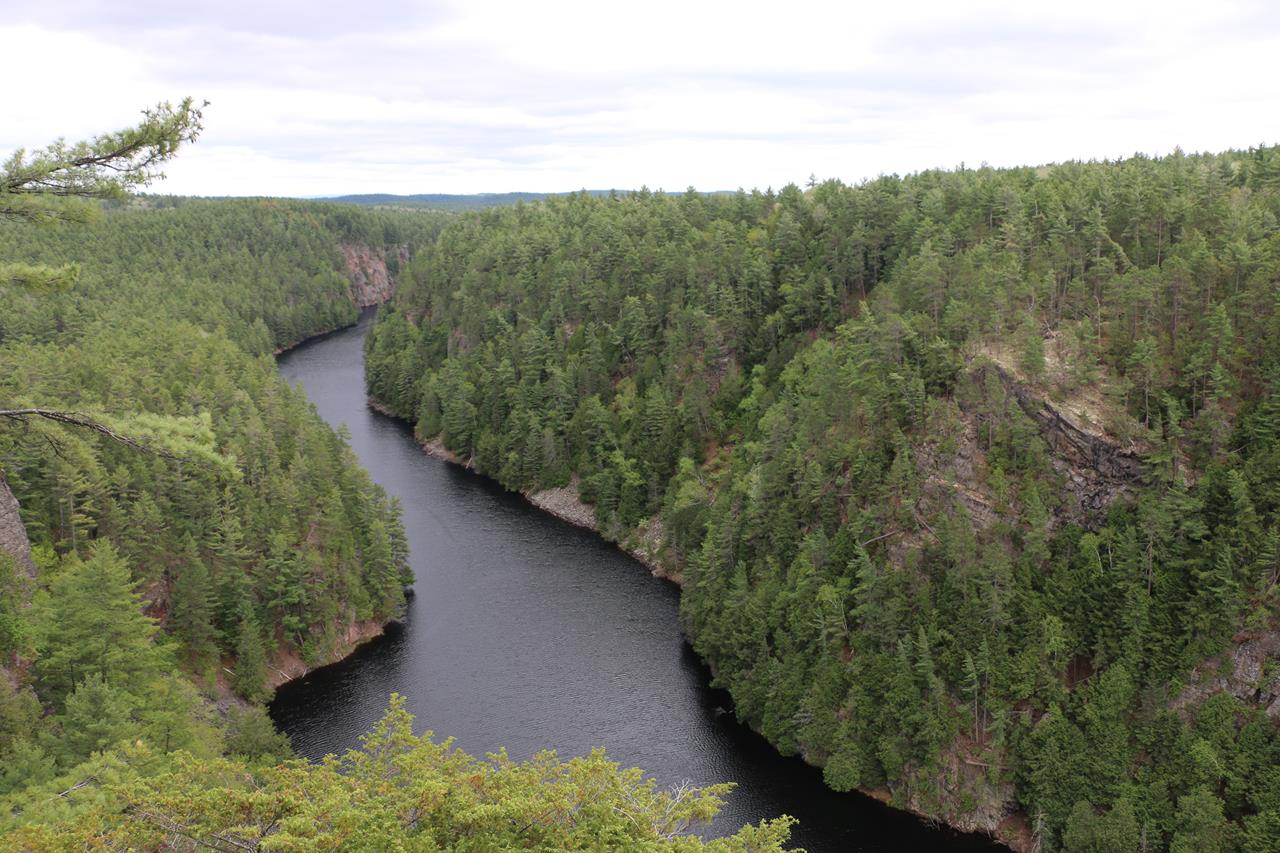 |
| No trip to the east side of Algonquin Park is complete without a visit to the Barron Canyon. |
 |